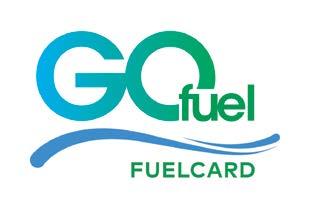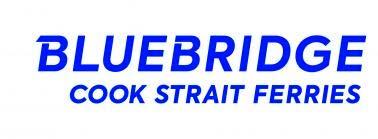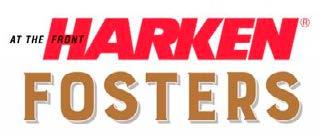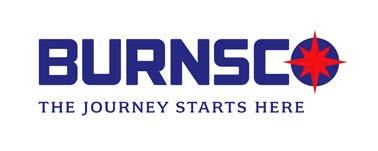
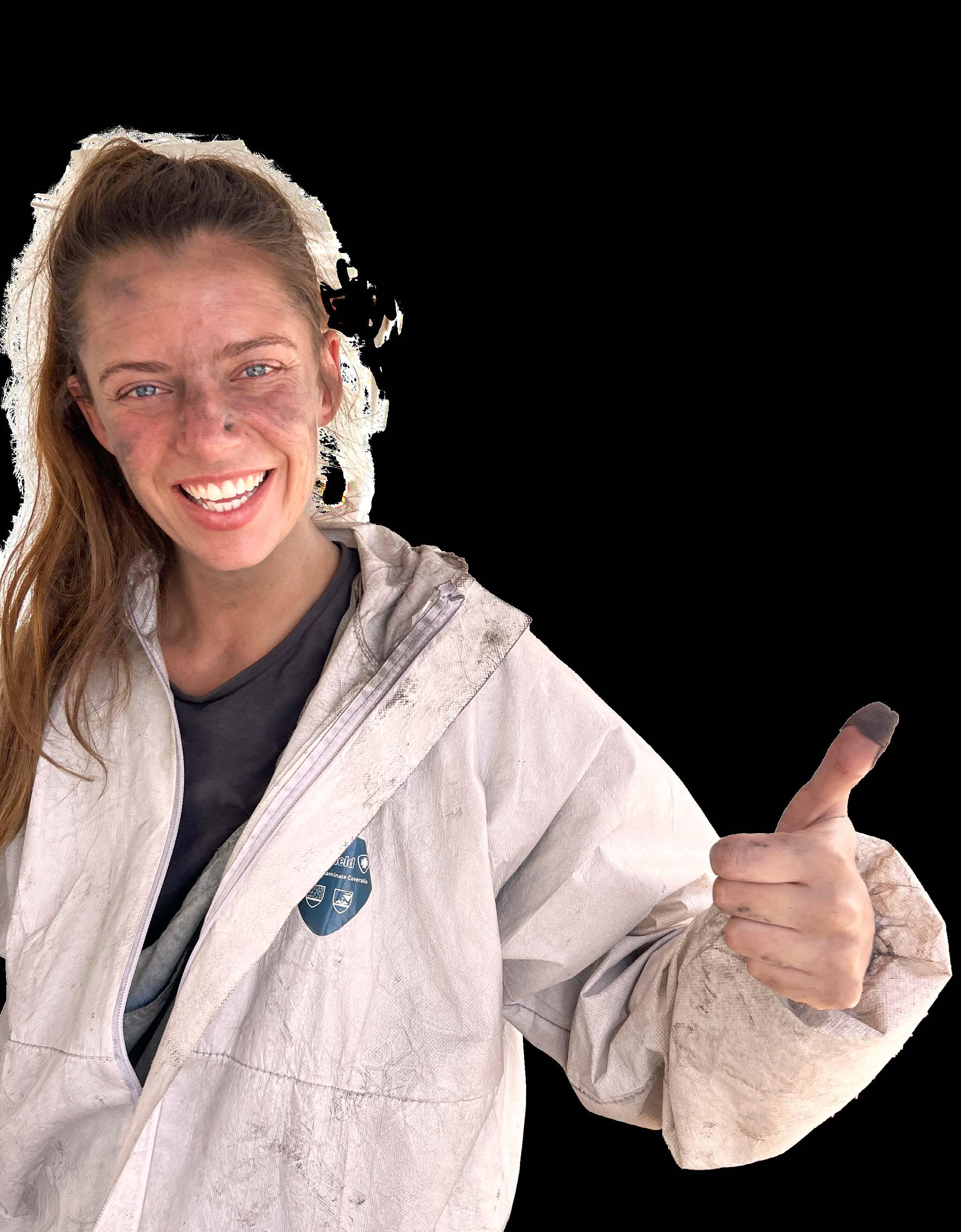
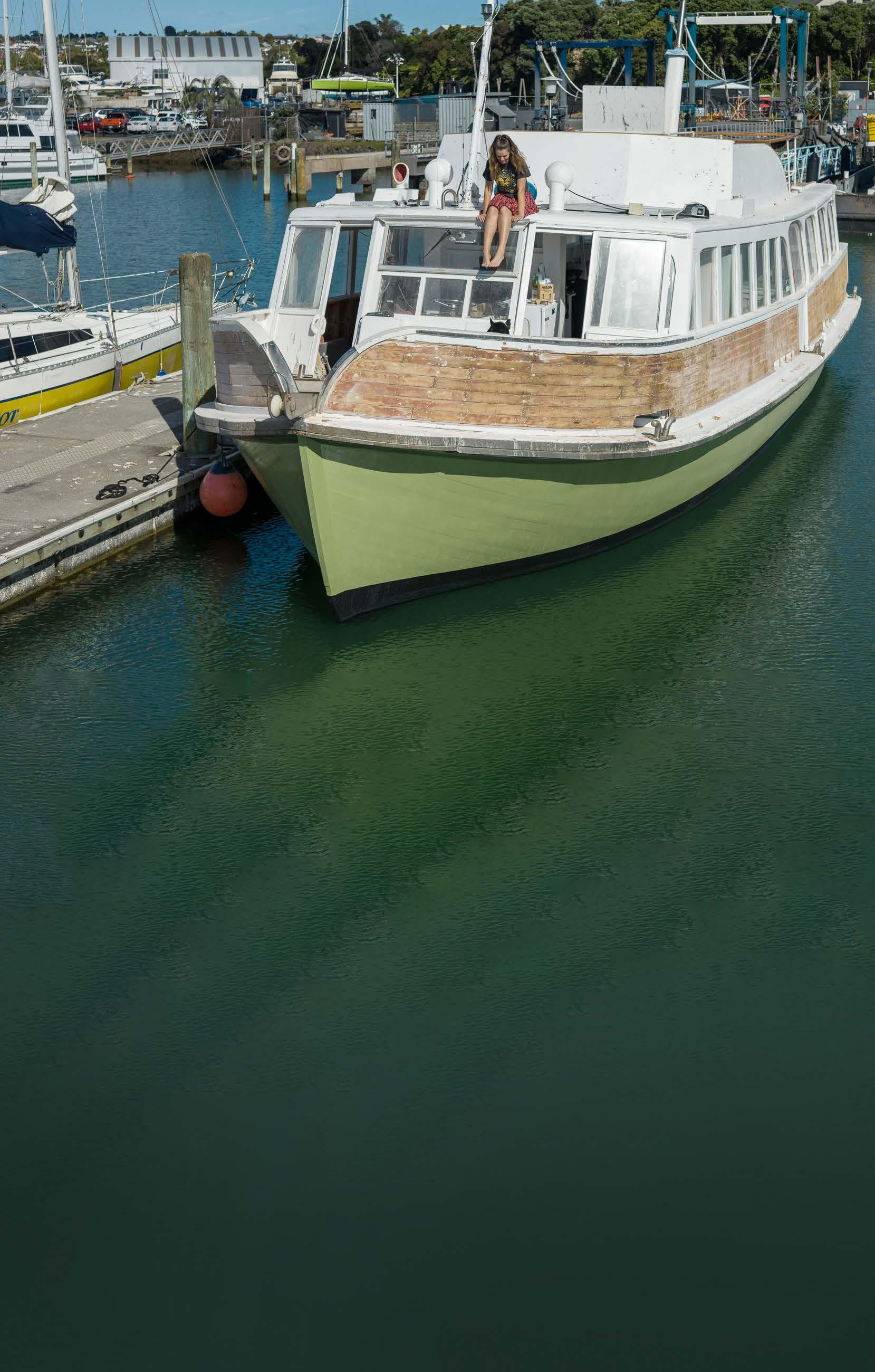





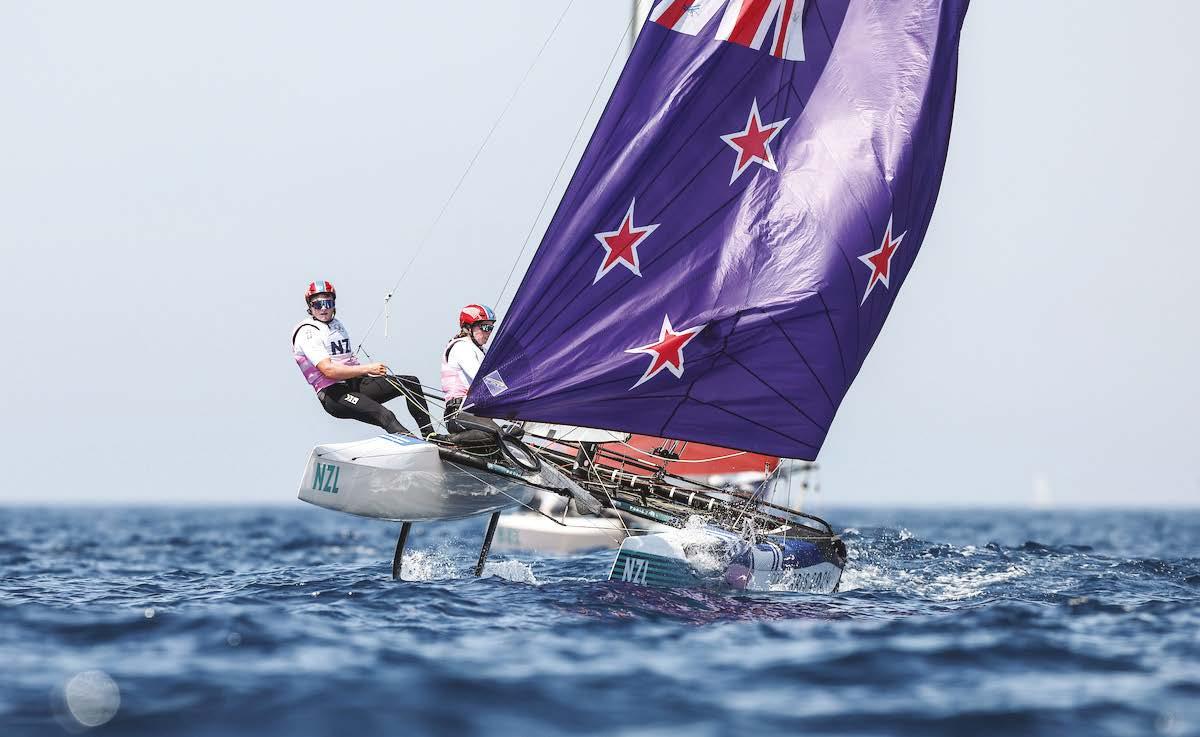
Take the helm at one of the country’s most iconic sporting organisations
After 14 years of dedicated leadership, YNZ’s CEO is stepping aside, creating a pivotal opportunity for a new appointee to shape the future of sailing and boating in Aotearoa. This leadership transition coincides with the start of new Olympic cycles as YNZ prepares for LA 2028 and Brisbane 2032. The role offers a visionary leader the chance to make their mark on both community sailing and high-performance excellence.
Yachting New Zealand is the national governing body for sailing, representing over 100 clubs and 40 class associations. Recognised by World Sailing, Sport NZ, High Performance Sport NZ and the NZ Olympic Committee, it supports both community sailing and competitive excellence.
YNZ’s purpose: to grow sailing and inspire New Zealanders through its sport. Based in Auckland with 20 staff, it operates nationwide to develop participation, community engagement and high-performance programmes.
As CEO, you will provide strategic leadership during a significant period of organisational transformation. You will implement Project Arotake recommendations, manage diverse stakeholders from grassroots to elite competitors and develop sustainable funding strategies. The role requires balancing high-performance with community sailing, expanding female participation and representing YNZ nationally and internationally. You will oversee national sailing centre development plans while supporting athlete voice in governance as part of a highly consultative leadership model.
We seek a dynamic, values-driven leader who can demonstrate a highly impactful skillset including:
Executive leadership in sport or not-for-profit sectors
Stakeholder relationship management
• Financial acumen and revenue diversification
Strategic vision and change management
Commercial insight for funding opportunities
• Understanding of NZ sporting pathways
Yachting New Zealand is committed to diversity and inclusion across all aspects of its organisation.
Candidates can apply online at www.sheffield.co.nz. To apply by email, please attach your cover letter and CV and send to cvakl@sheffield.co.nz quoting 8877. Applications close on 28 April 2025. Emails will be electronically acknowledged and further correspondence may be by email. To view the Candidate Briefing document, please click here.
For more information please phone Ian Taylor on Ian +64 (27) 487 7424 or Tash Wilson on +64 (21) 448 648.



Big backyard. You’ve got it. Buyers want it. We’ll sell it.

If you’re thinking of selling, we’re here to help you connect with the right buyers, and plenty of them. With 1,800+ salespeople across 88 branches, we can give your property the exposure it deserves. Book an appraisal at one of our branches today.



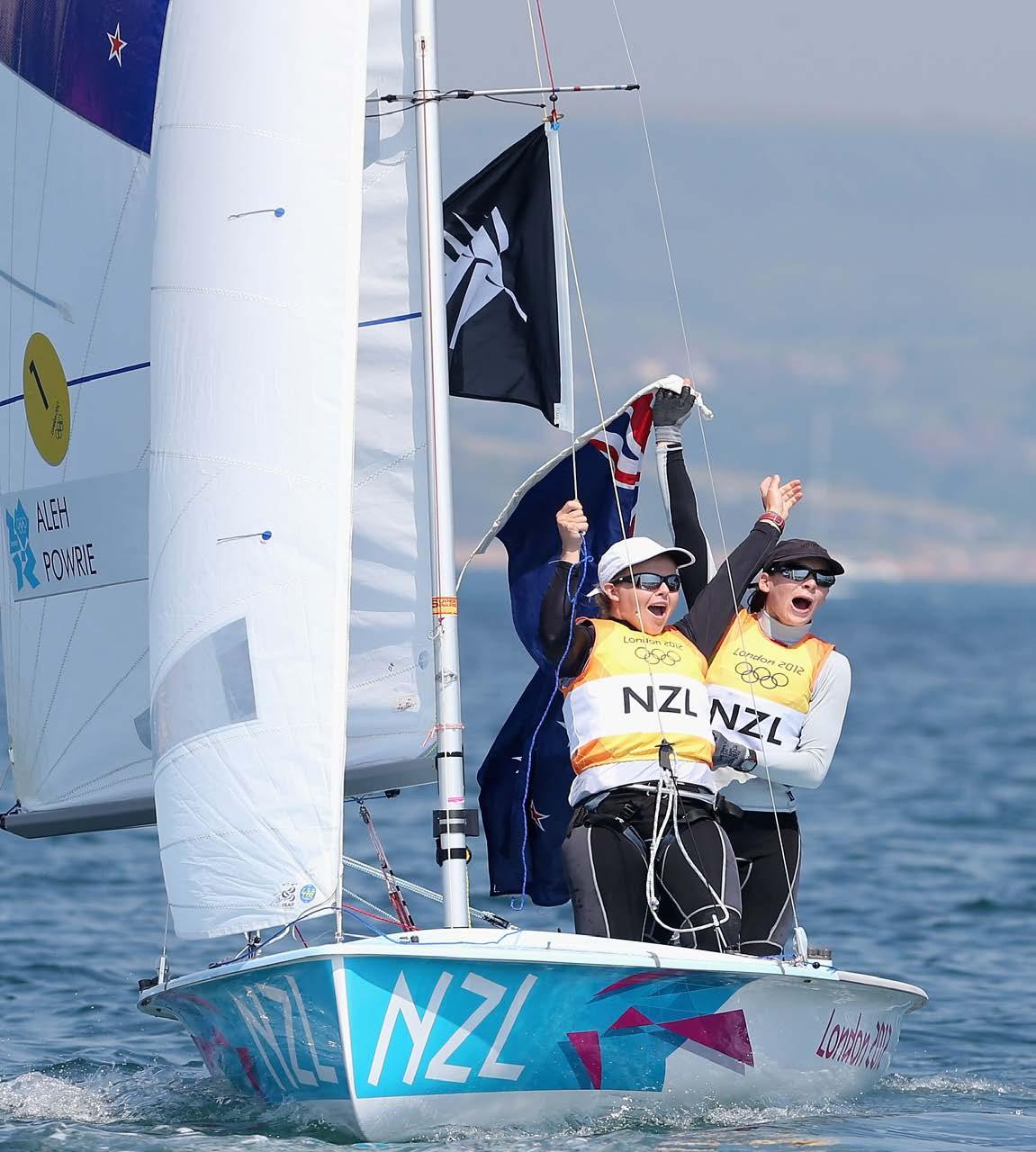


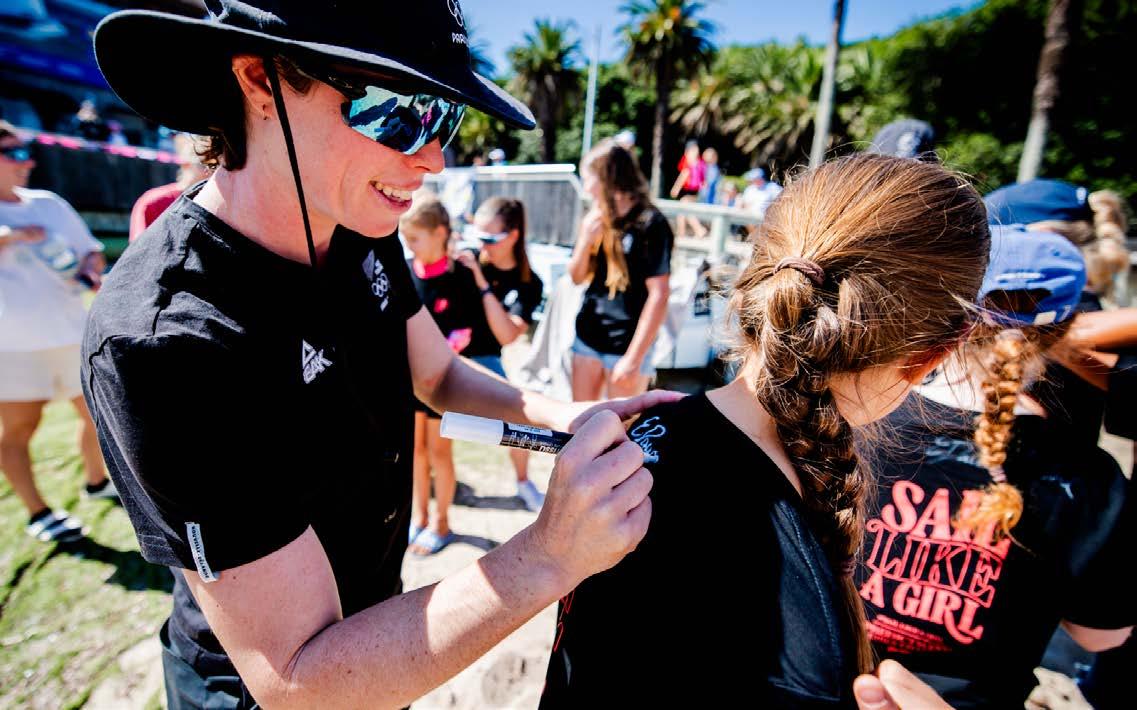



EDITOR
@YachtingNewZealand
@YachtingNewZealand
CONTRIBUTORS
David Abercrombie, Cris Brodie, Kathy Catton, Conrad Colman, Ian Gardiner, Wayne Holdt, Suzanne McFadden, Kirsten Moratz, Alisa Torgersen, Josh Tucker, Hayden Whitburn.
EDITORIAL
Eduan Roos eduan@yachtingnz.org.nz
ADVERTISING
Angela Jordan angela@yachtingnz.org.nz
YACHTING NEW ZEALAND
4 Fred Thomas Drive, Takapuna, Auckland 0622
YBQ is published quarterly by Yachting New Zealand.
Cover photo: Ben Howard
The story of Bay Belle has captivated New Zealand’s sailing community like few others this year – a historic kauri launch, left to rot, given a new lease on life by a young woman with limited experience of sailing or restoration.
It’s an underdog story that has inspired countless people to follow along.
Kate Farrant found Bay Belle listed in a deceased estate sale, “deteriorating on its mooring”, while searching for the perfect vessel for a bold business idea.
But restoring the boat which for 50 years had ferried passengers and cream in the Bay of Islands, proved far more challenging than she had imagined.
It was an emotional moment for the 29-year-old Aucklander and everyone who had joined the journey. The relaunch symbolised a personal triumph and a collective achievement – a testament to New Zealand’s love for maritime heritage and the spirit of adventure.
Farrant’s story can be found on page 72 of this edition of YBQ. But it’s not the only great read – two of the country’s most successful double-handed Olympic sailors Jenny Armstrong and Jo Aleh also discuss choosing the right sailing partner, and Paris 2024 hero Micah Wilkinson talks about his (temporary) transition from foiling multihulls to flying powerboats.


Determined to bring Bay Belle back to her former glory, Farrant turned to social media for help.
The response was overwhelming.
Online followers, friends, and boating enthusiasts rallied behind her, offering advice, volunteering services, and sharing memories.
For many, the project was a chance to relive the heyday of the beloved boat, which had carried millions of passengers and travelled the equivalent of 28 times around the equator.
Throughout the process, Farrant documented the journey online, sharing updates on repairs, challenges, and small victories.
Finally, in mid-March, five months after first laying eyes on her, Farrant relaunched Bay Belle, defying the odds and bringing the historic vessel back to life.
There are also insights on the latest sailing tech, fitness, and nutrition, as well as a message from Yachting New Zealand’s retiring CEO, David Abercrombie, after nearly 15 years at the helm.
Offshore sailing also takes the spotlight, with Sharon Ferris-Choat reflecting on her first Sydney-Hobart race and safety expert Cris Brodie offering essential tips. We celebrate the Pacific Rally’s remarkable new milestone, while Conrad Colman gives a first-person account of his brutal 85-day Vendée Globe challenge – and shares his plans to lead a New Zealand entry in The Ocean Race for the first time in over a decade.
It’s well worth a read and worth supporting the “Crazy Kiwi” as he embarks on his latest ambitious voyage. After all, who doesn’t love a good underdog story?

Conrad Colman on taming the Vendée - and his Ocean Race dreams 38

Kiwis battle at Princess Sofia 8
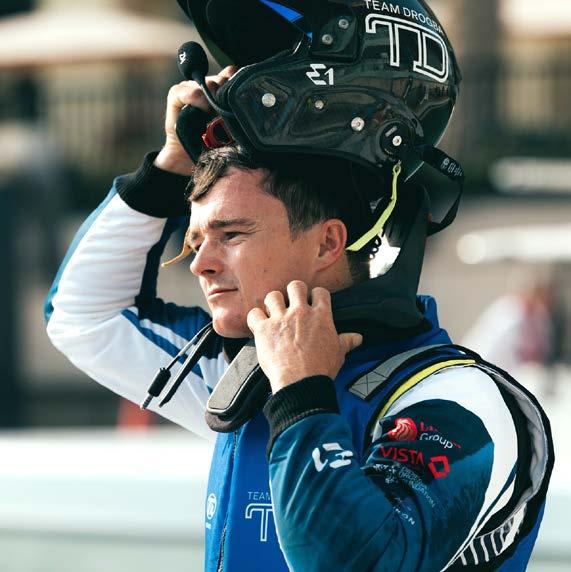
TILT Micah Wilkinson’s new adventure 10


Young Kiwis flock to Europe for start of new Olympic cycle.

Afresh wave of New Zealand sailing talent – with a pinch of old salts – kicked off their international season this week at the Princess Sofia Regatta in Palma de Mallorca, Spain, marking the beginning of a new Olympic cycle towards Los Angeles 2028. A 20-strong Kiwi contingent are competing across six classes in Palma, before shifting to the French Olympic Week in Hyères in a fortnight.
For some sailors it’s a return to international waters for the first time since the Paris 2024 Olympics, while others are looking to establish themselves on the world stage.
Notably absent from Palma are 49er
silver medallists Isaac McHardie and Will McKenzie, as well as Nacra 17 bronze medallists Micah Wilkinson and Erica Dawson. Despite the McKiwis’ absence, New Zealand remains well-represented in the men’s skiff fleet, with Seb Menzies and George Lee Rush leading four teams competing in the class.
At the time of publication, Menzies and Lee Rush were 13th in the Princess Sofia fleet, only nine points off a place in the medal race with one day of finals racing to go.
Olympic windfoilers Veerle ten Have and Josh Armit were also going strong in Palma, with ten Have third and Armit seventh overall.
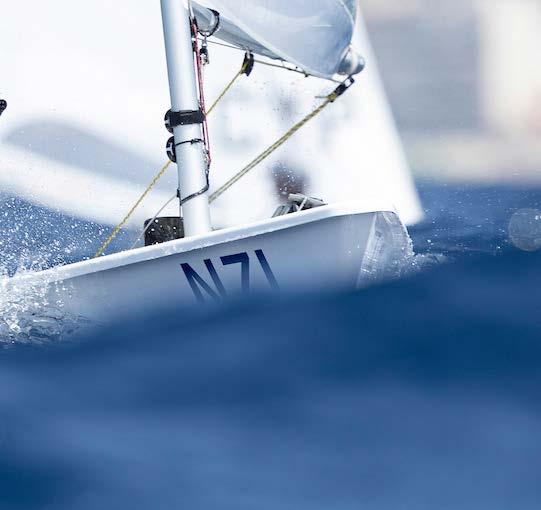
Ten Have is competing alongside rising stars Stella Bilger and Aimee Bright in a fleet that includes Olympic medallists Marta Maggetti and Emma Wilson.
Armit, who finished fourth in Marseille, is going head-to-head with fellow Kiwi Eli Liefting and the three sailors who beat him to the podium: Israel’s Tom Reuveny, Australia’s Grae Morris, and Dutchman Luuc van Opzeeland.
Lukas Walton-Keim leads New Zealand’s charge in the kitefoil in Europe, with youngsters Lochy Naismith and Lucy Bilger also racing, while Greta Pilkington is the country’s sole ILCA 6 representative.
Walton-Keim, Bilger and Pilkington were all inside the top 20 on their
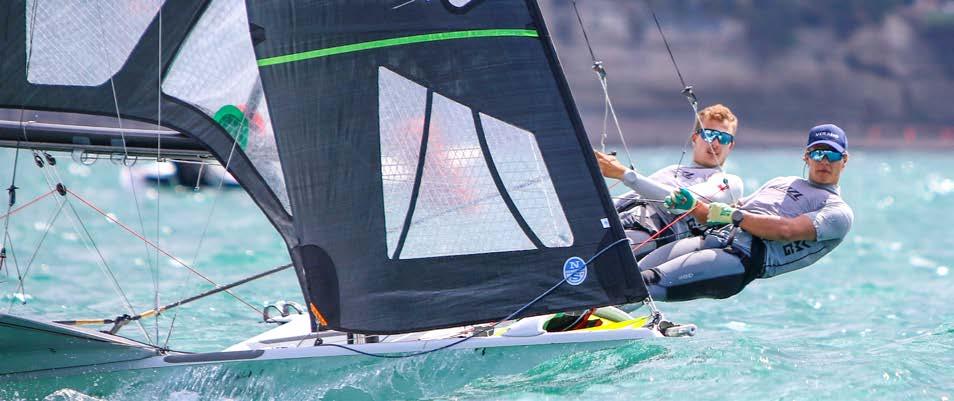
Princess Sofia Regatta
March 28-April 5
49er: Sam Bacon and Blake McGlashan, Francesco Kayrouz and Hamish McLaren, Seb Menzies and George Lee Rush, Campbell Stanton and Will Shapland.
Men’s kitefoil: Lochy Naismith, Lukas Walton-Keim.
Women’s kitefoil: Lucy Bilger.
ILCA 6: Greta Pilkington.
ILCA 7: Caleb Armit, George Gautrey.
Men’s windfoil: Josh Armit, Blake Hinsley, Eli Liefting.
Women’s windfoil: Stella Bilger, Aimee Bright, Veerle ten Have.
French Olympic week
April 19-26
49er: Sam Bacon and Blake McGlashan, Francesco Kayrouz and Hamish McLaren, Seb Menzies and George Lee Rush, Campbell Stanton and Will Shapland.
Men’s kitefoil: Lukas Walton-Keim, Toby Wigglesworth.
Women’s kitefoil: Lucy Bilger.
ILCA 6: Greta Pilkington.
ILCA 7: Caleb Armit, George Gautrey, Tom Saunders.
Men’s windfoil: Josh Armit, Eli Liefting.
Women’s windfoil: Aimee Bright.
respective leaderboards at the time of writing.
A key storyline this European summer will be George Gautrey’s return to international competition after narrowly missing out on Paris 2024 selection to Tom Saunders.
The Wellingtonian took an extended break from sailing in the class but recently resumed competition, training with British star Michael Beckett before making his comeback at Oceanbridge Sail Auckland.
He was impressive in the early exchanges in Spain, sitting well within the top 10 with the double-points finale ahead.
Gautrey made headlines two years ago in Palma with a stunning medal
race performance that secured silver and launched a breakthrough season, culminating in a world championship bronze in The Hague.
Saunders will make his season debut in Hyères, where he will be joined by Toby Wigglesworth in the men’s kitefoil.

Life
in the fast lane has taken an unexpected twist for Kiwi Olympic hero – one where technology and entertainment meet.
Aself-confessed speed junkie, Micah Wilkinson has spent most of his 29 years chasing white-knuckle thrills – whether on wheels or foils.
and Como, the series is backed by PIF, the Saudi investment firm that has also become a major player in top golf, tennis, football, and boxing competitions.
Much like Formula One in motorsport, the E1 series features nine teams with two drivers (or "pilots") each, competing for points in a series of Grands Prix on all-electric foiling powerboats called RaceBirds.
It has been a whirlwind eight months since Wilkinson and Dawson drifted past the finish line for one of the most dramatic moments of the Olympic sailing event –and the proudest moment of their careers.
Since then, he's supported Dawson and the Kiwi America's Cup teams in Barcelona, test-driven an electric hydrofoiling ferry on the Hauraki Gulf, restored a cruising catamaran with friends, coached across New Zealand, and made a mad dash to Italy to join the E1 Series Pilot Academy.

Yet even he can't hide a mix of excitement and slight trepidation when discussing his latest high-speed endeavour. Wilkinson recently made his debut in the new E1 world championship, an electric powerboat racing series featuring global stops, celebrity team owners, and cutting-edge all-electric marine technology.
Launched last year with rounds in Jeddah, Venice, Puerto Banús, Monaco,
While flying on water is familiar to Wilkinson, who won Olympic bronze in the foiling multihull Nacra 17 with Erica Dawson in Marseille in August last year, that's where the similarities with the E1 series end.
"It's just so beautifully different," Wilkinson explained.
"You're sitting in a cockpit with all sorts of buttons and gauges, limited vision, and wearing a full fireproof suit, crash helmet, boots, gloves, and a five-point harness.
"It feels like you're strapped into a rocket!"
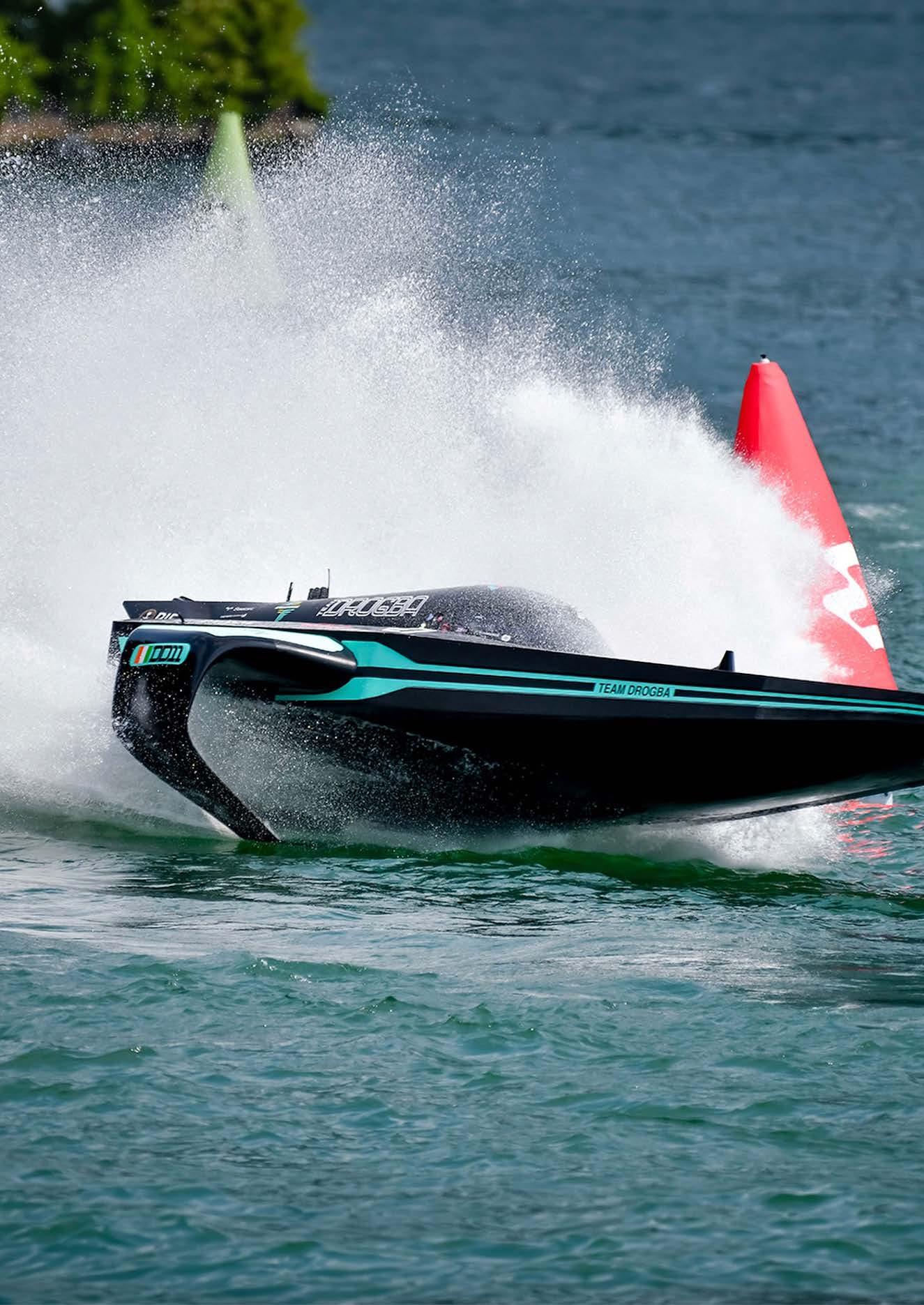
He and partner Kate Stewart have also just relocated from Auckland to Christchurch.
When YBQ caught up with him, Wilkinson was still settling into life in the Garden City – "we're loving the first few weeks" – and was about to head to Doha for his E1 debut as one of Team Drogba's two pilots, along with British powerboat ace Oban Duncan.
Doha was the second stop on this year's calendar, following the opening round in Jeddah in January, where Team Drogba
– owned by former Chelsea footballer Didier Drogba –finished last of the nine teams.
Wilkinson replaced Kuwaiti jet-skier Yousef Al-Abdulrazzaq for the Qatar GP after being fast-tracked into the pilot academy.
He made an immediate impression, leading the team to a podium finish after a sensational overtake in his group race and securing third place in the final.
Wilkinson reached a top speed of 88.99 km/h and recorded an impressive fastest lap of 1:16:63.
Yet his big break in the series arrived quite by chance, when two other sailors with strong Kiwi ties – Glenn Ashby and Leonard Takahashi – became unavailable and Wilkinson's name "came up through the grapevine".
"Glenn is involved in the background with the team but had to pull out of driving, and then Leo did too," Wilkinson said. "I got a call from the team manager,
Continued on p12

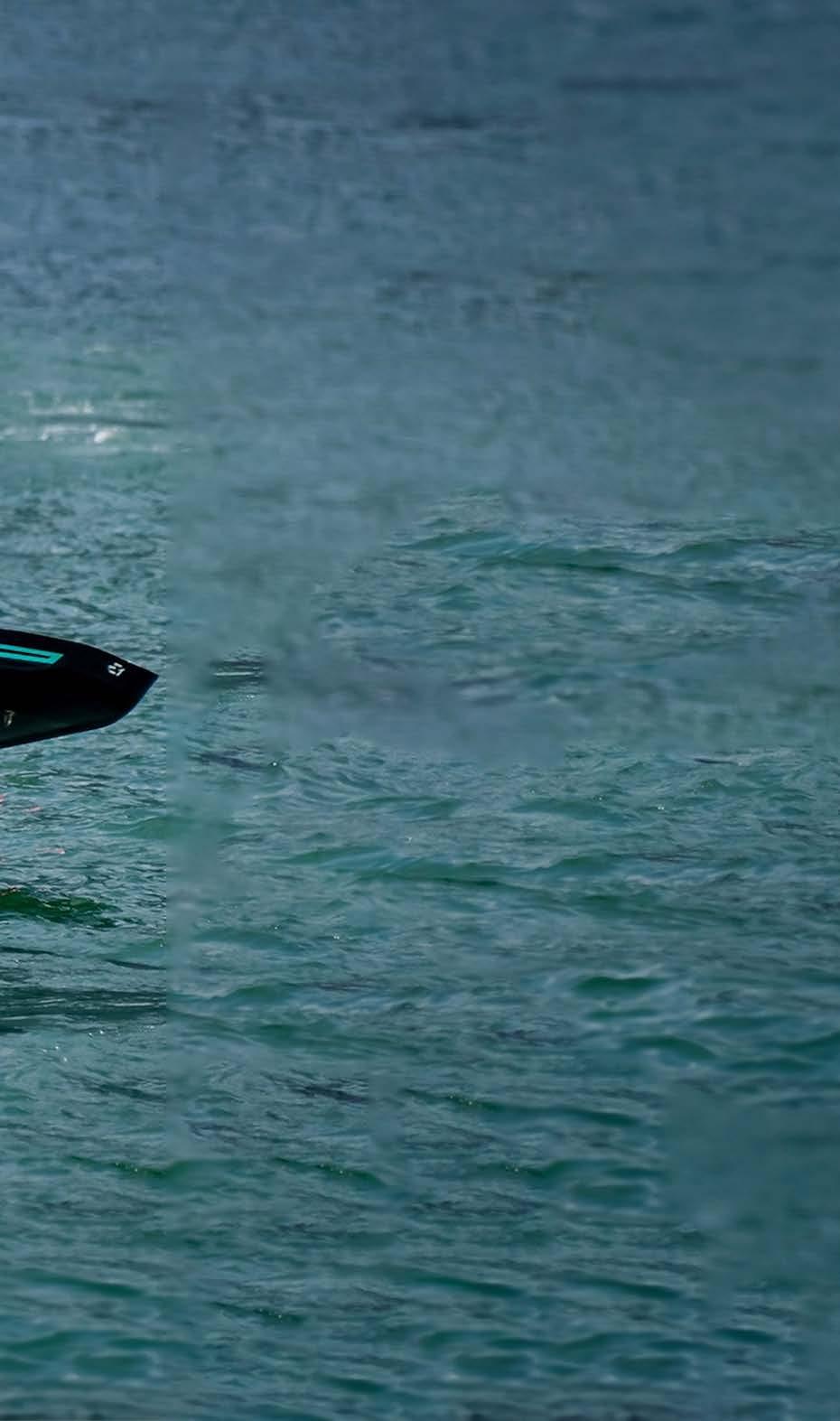
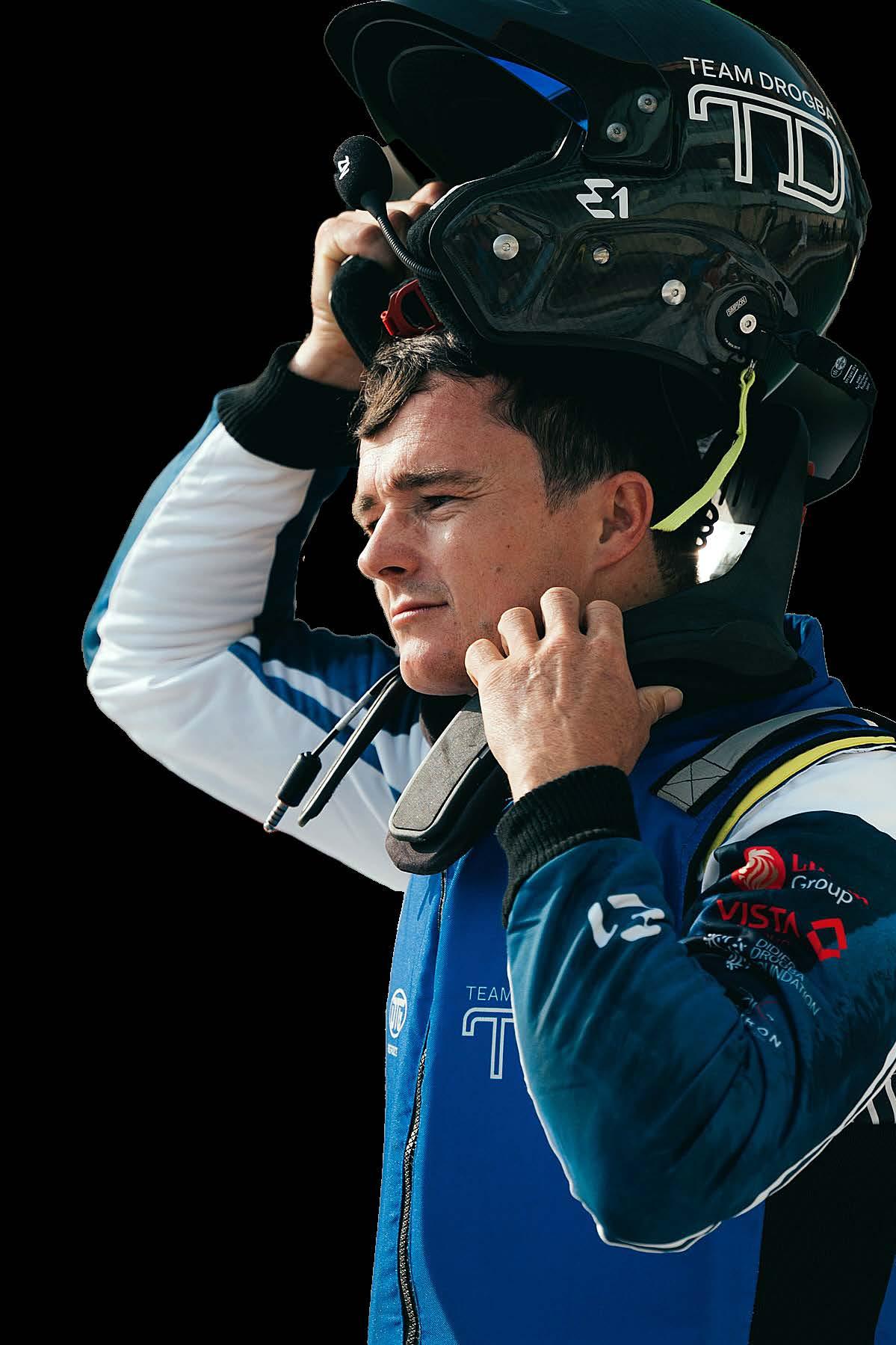
Rory Godman, at the end of October asking if I could get to Italy about ten days later. Naturally, I said 'yes,' and we were on!"
After earning his super licence, Wilkinson joined the team's support crew, sitting in mission control and helping with strategy for the opening round.
The mix of celebrity and sport was unlike anything he had experienced before, Wilkinson said.
"There's really no other league like it. The series is designed to attract top motorsport talent, but you also have superstars like Drogba, Tom Brady, and Rafael Nadal closely involved.
"In Jeddah, they had this two-storey VIP club and what they called an Acceleration Festival, with activities along the waterfront and all the boats lined up in front. We didn't have much time to look around, but the water quality was amazing – just beautiful."
Team Drogba's poor result forced team bosses to "to mix things up" and Wilkinson was thrown into the deep end.
While he is the only sailor to have secured a seat in the series, he's not the only New Zealander involved.
"Our team manager Rory and team principal Jamie Boag are both Kiwis," Wilkinson said.
"We also have [Olympic 470 sailor and former world champion] Simon Cooke as a mechanic and [racing car driver] Rianna O'Meara-Hunt as a reserve pilot on the team.
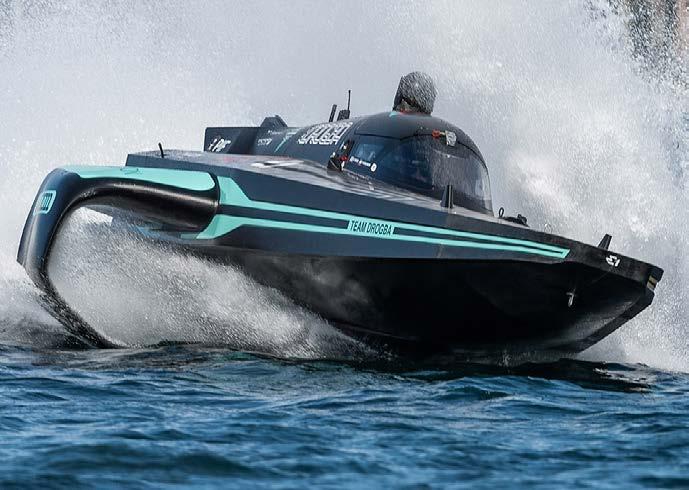
"Having a few Kiwis and yachties around is great for the banter, but everyone on the team is fiercely competitive. Yes, we have a great time, but we're all here to win."
Growing up in Te Awamutu, Wilkinson was introduced to motorsport at an early age and still considers it his first love.
"I started karting at six, and I just loved the speed and intensity of it," he said.
"I raced cadets and came back to it a few times before sailing really took centre stage." Wilkinson competed internationally in the SL16, won a youth world championship title in the 29er, and was part of the New Zealand team that finished second in the 2017 Youth America's Cup.
Over the following decade, he and Dawson cemented themselves as one of the world's top foiling multihull combinations, securing several top 10 finishes at major European regattas before making their Olympic debut in Tokyo in 2021 and winning bronze in the south of France.

Aoki Racing Team
Owner: Steve Aoki (DJ, record producer)
Pilots: Dani Clos - Spain (Race car driver, YouTuber)
Mashael Alobaidan
- Saudi Arabia (Dakar Rally driver)

Team Alula
Owner: LeBron James (Basketball)
Pilots: Catie Munnings
- Great Britain (Extreme E, WRX driver)
Rusty Wyatt
- Canada (Powerboat racer)
The opportunity to race in E1 came at a time when Wilkinson was considering his future, he revealed.
"I've always wanted to be on the fastest boat or the fastest wheels I possibly could. The passion for motor racing has always been there – even when I was sailing full-time, I would still follow MotoGP or Formula One. There are so many Kiwis doing great things in motorsport. We have one or two in just about every class and it's only getting bigger.
"In a way, this opportunity combines my two great passions – motor racing and foiling."
While he will be taking a break from Olympic sailing for much of 2025 and is yet to commit to anything beyond that, Wilkinson is by no means done with the sport.
"I'm taking a breather after a pretty intense Olympic cycle and reassessing what's next for me," he explained.
"I'll always be passionate about Olympic sailing, and we have so many amazing people involved in the [NZL Sailing] highperformance programme. Being part of the America's Cup and SailGP is another dream of mine, so I'll just keep pushing and see what happens."
Before strapping in for his Doha debut, Wilkinson's only experience with powerboats had been on fishing boats.
"I’ve had very little time in powerboats, and these ones are pretty out there. They're super technical – it has an F1-style steering wheel with buttons for everything, from boost and radio to trim, plus three data screens.
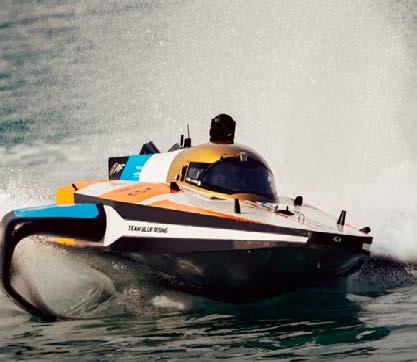
Team Blue Rising
Owner: Virat Kohli (Cricket)
Pilots: John Peeters - USA (Powerboat racer)
Sara Misir - Jamaica (Race car driver)

Team Brady
Owner: Tom Brady (NFL)
Pilots: Sam Coleman
- Great Britain (Powerboat racer)
Emma Kimiläinen
- Finland (Racecar driver)

"The boats start foiling at about 40 knots and top out at 50, though it's hard to reach that due to stability."
Wilkinson had only one practice race in Doha before competing against some of the world's top powerboat racers and champions from related disciplines. His flying start to the series is bound to keep him in the hot seat – at least for the next round at a yet-to-bedetermined venue.
It is one of five remaining rounds in the season that ends in November, including Monac, Lake Maggiore and Miami.
"The guy who won the first round in Jeddah [Aoki Racing Team's Dani Clos] used to be a reserve driver for the Williams F1 team and raced against Sergio Pérez for the F2 title when they were younger. There are powerboat racers, Dakar Rally drivers…
"I'm super excited to step up – and just a little nervous. In terms of racing credentials, I'm surrounded by rock stars. This is a whole new world!"
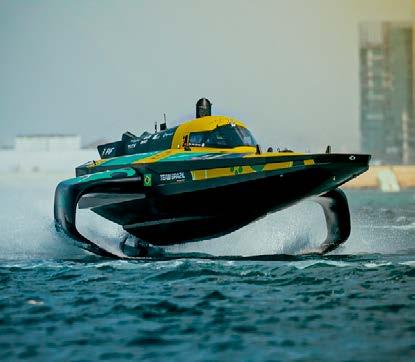
Team Brazil
Owner: Marcelo Claure (Technology entrepreneur)
Pilots: Timmy Hansen
- Sweden (Extreme E, WRX driver)
Marit Stromoy
- Norway (Powerboat racer)
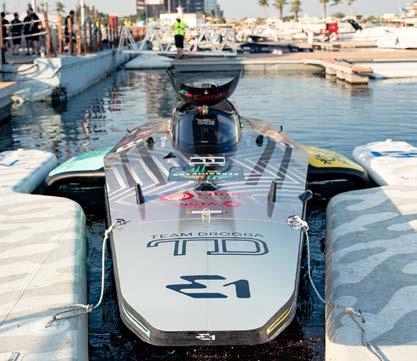
Team Drogba
Owner: Didier Drogba (Football)
Pilots: Micah Wilkinson - New Zealand (Sailor)
Oban Duncan - Great Britain (Powerboat racer)
The all-electric RaceBird offers high-speed action with a focus on stability and innovation. Equipped with advanced electric propulsion systems, the boats effortlessly harness 150kw (200 bhp). With its state-of-the-art foiling technology, it can reach speeds of up to 50kn (93kph).
A race weekend consists of testing, free practice, and qualifying on the first day, while the semifinals, play-off race, eliminator race, place race, and finals all take place on the second day. Qualifying is three sets of three racers, with each team getting two sessions to allow both pilots to set a time. After qualifying, the teams are split into three groups of three, racing against each other in six semi-final races. The top team in each group automatically goes to the final, while the second-place finishers battle in a playoff race for the last spot. The third-place finishers race in an eliminator race, with the last-place finisher placing ninth for the event. The bottom two teams in the play-off, and the top two teams in the eliminator then compete in the place race, for positions five through nine. The top four teams compete in the final, which consists of the combined results of super final 1 and super final 2.

Team Miami
Owner: Marc Anthony (Singer)
Pilots: Erik Stark - Sweden (Powerboat racer) Anna Glennon - USA (Jetskier)

Team Rafa
Owner: Rafael Nadal (Tennis)
Pilots: Cris Lazarraga - Spain (Jetskier) Tom Chiappe - France (Powerboat racer)

Westbrook Racing
Owner: Will Smith (Actor)
Pilots: Sara Price - USA (Dakar Rally driver)
Lucas Ordonez - Spain (Racing driver)

Promising 49er crew claim coveted Oceanbridge Sail Auckland crown (with a little help from their friends).
Plenty of hard work and a touch of Olympic inspiration propelled one of New Zealand’s most promising double-handed crews to success at the country’s premier domestic sailing event in March.
Seb Menzies and George Lee Rush have now joined an impressive list of sailors to have won the 49er title at Oceanbridge Sail Auckland, with the young duo delivering a masterclass in consistency over three days at Torbay.
The regatta concluded on a thrilling note, with titles in several classes only decided in the final race but while some sailors faced last-minute battles for victory, Menzies and Rush had all but secured their title before pushing off Waiake Beach on the final day.
The pair, who won the 49erFX junior world championships in 2022, claimed four race wins and finished outside the top three only once, underlining their consistency in a range of challenging conditions.
They are part of a squad of five 49er teams training together over the past two years to maintain a strong talent pipeline in the class.
Rush credited this squad-based approach for their success.
“There’s a group of us who have all come
into the class at roughly the same level and the same time from the 29er,” he said. “It’s a very competitive fleet and we’re all evenly matched but being able to train together, progress together and share everything is an awesome place to be in.”
Menzies and Rush finished 11 points ahead of Mattias Coutts and Oscar Gunn, with Francesco Kayrouz and Hamish McLaren third.
“We really focused on our starts during the regatta,” Rush explained. “At the national championships [in late February], that was our biggest weakness, so we made it our priority for this event.”
The squad has drawn inspiration from New Zealand’s international success in the 49er class, particularly from Peter Burling and Blair Tuke, and more recently, Isaac McHardie and Will McKenzie.
McHardie and McKenzie won silver in the 49er at last year’s Paris Olympics, continuing New Zealand’s podium streak in the class at the past four Games.
“Statistically, it’s our strongest class, and there’s always been a great group of sailors involved. We all want to carry that legacy forward and achieve even more success.”
Meanwhile, Erica Dawson and Molly Meech won the 49erFX event, while Nelsen
Meacham and Tim Howse edged out Will Leech and Will Mason by a single point in the final 29er race.
In the ILCA 7 (formerly Laser) competition, Singapore’s Ryan Lo topped the podium ahead of New Zealanders Tom Saunders and George Gautrey.
Lo, who has represented Singapore at the past two Olympics, won four of the 10 races, including the first on day 3, finishing two points ahead of Saunders.
Saunders, who placed seventh in Marseille last August, will head to Europe in April for the start of the international season, joined by Gautrey, who has recently returned to ILCA 7 racing after an extended break.
Saunders revealed he had been coaching Lo for much of the year.
“Obviously, I’ve been doing too good a job!” he joked. “Seriously though, Ryan is a great sailor, and he raced well.”
Greta Pilkington continued her dominance in the domestic ILCA 6 (Laser Radial) fleet, winning six of the 10 races to claim the title by 13 points ahead of her younger brother, Tom.
She had previously won her first national title in Nelson in January and achieved impressive results in Australia.

Tessa Clinton and Amelia Higson won the 420 event in their first major regatta as a team.
Clinton, a two-time youth worlds competitor, recently partnered with promising Starling sailor Higson, and together they won six of the 10 races to take victory by 12 points from Thomas Jurczyluk and Oli Wyeth.
“We’ve made great progress in a short time and are really happy with how the weekend went,” Clinton said.
Asked about their key to success, Clinton highlighted communication – along with plenty of singing.
“I think we know how to push each other’s buttons. If I go quiet, Amelia tells me to snap out of it, and vice versa.
“There was also a lot of Coldplay, Adele, and The Killers to keep us motivated!”
Elsewhere, Veerle ten Have overturned a four-point deficit on the final day to win the windfoil 7.3m title, with Stella Bilger second and Aimee Bright third.
Eli Liefting held on to his one-point lead in the windfoil 8m category, despite Josh Armit winning the final race. Armit finished second overall, with Blake Hinsley third.
Toby Wigglesworth topped the kitefoil fleet, with Lucy Bilger the highest-placed female competitor.
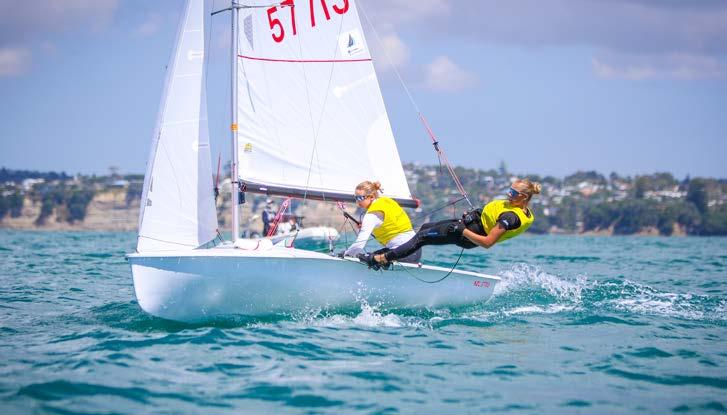
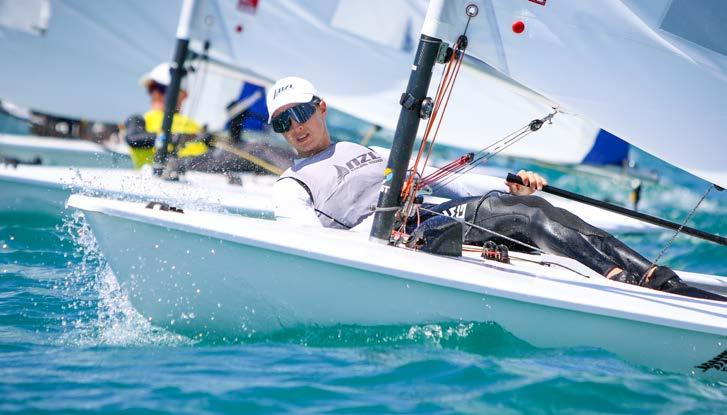
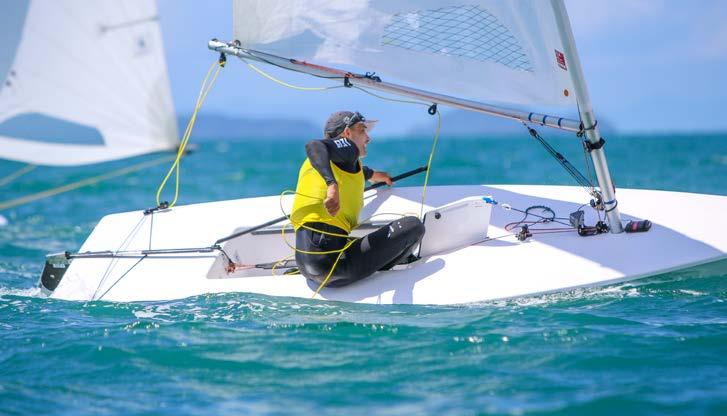


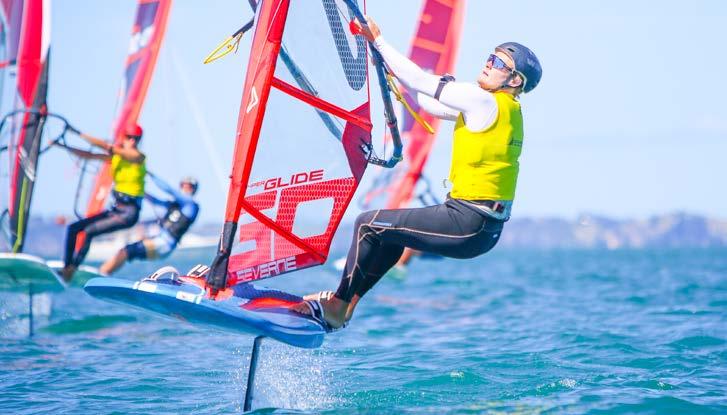

49erFX fleet (3 boats)
Erica Dawson/Molly Meech 14 pts
Nicola Hume/Rebecca Hume 20 pts
Erin Kee/Isla Kee 38 pts
iQFOiL 7.3m fleet (9 boards)
Veerle ten Have 24 pts
Stella Bilger 27 pts
Aimee Bright 31 pts
iQFOiL 8m fleet (9 boards)
Eli Liefting 19 pts
Josh Armit 20 pts
Blake Hinsley 40 pts Kitefoil fleet (4 boards)
Lochy Naismith 22 pts
Lukas Walton-Keim 27 pts
results here


Age, qualifications no barrier to start of exciting journey, says Doug Elder.
You don’t need to hold a national or club judge qualification to attend the World Sailing judges seminar hosted on our shores later this year.
In fact, any experienced sailor or coach is free to register – and take the next step on what could be a rewarding journey.
It certainly has been for Doug Elder, New Zealand’s only World Sailingrecognised international judge instructor and one of the country’s most experienced race officials.
Elder will be one of two instructors at the seminar, held at the Royal New Zealand Yacht Squadron from May 2 to 4, 2025, and he is encouraging Kiwis from all walks of the sailing community to register.
“You don’t have to be a national judge to attend the seminar – I definitely wasn’t when I attended my first one in 1991,” Elder said.
“Anyone who is interested in judging and has a general yacht racing background – whether as a sailor or a coach – is welcome.”
Some of the best judges he has come across in his 34 years in the role didn’t have official qualifications when they first got involved.
“As long as you have the racing
experience, are generally fair-minded, and like to be involved in the sport, you can do well.”
Age isn’t a barrier either, according to Elder.
In November last year, World Sailing appointed Louis Mayo, 28, as an international judge, making him the most recent Kiwi to achieve the position and one of the youngest ever.
The judges seminar follows the World Sailing race management seminar hosted by Gulf Harbour Yacht Club in October last year and planning is already underway to run a World Sailing measurement clinic and seminar later this year.
Raynor Haagh, Yachting New Zealand’s national sport development director, highlighted the significance of these events.
“It is an honour to have this seminar hosted in New Zealand so soon after also being chosen for our first race management seminar in several years and with work
underway to have the measurement seminar, too,” she said.
“These seminars don’t just provide valuable training and certification opportunities but will also foster international collaboration and the sharing of best practices in these areas. We look forward to hosting the World Sailing judges seminar and assisting our community in pursuing their goals as race officials in the sport of sailing.”
To register for the World Sailing judges seminar, click here.
Equity, diversity and inclusion committee: Raynor Haagh

Growth of sailing committee: Raynor Haagh
Equipment committee: Jo Aleh
Specialist sailing committee: Jo Aleh
Events committee: Geoff Woolley
Match racing committee: Russell Green
Team racing committee: Sam Mackay
Youth events committee: Sam Mackay
International measurers sub-committee: Alistair Deaves (vice-chair)



Continued on p20

communicators.
What was important to you when selecting your sailing partners?
Aleh: Polly and I had sailed against each other through our junior years, and I always thought she was a really good sailor and had a really good work ethic. With Molly, I had watched her sailing with Alex [Maloney] for many years, and again, had huge respect for her and her skills in the boat, and who she was as a person, so it was quite simple. You must trust that your teammate will go all in as much as you and that you believe they are the best person for the job. I have been very lucky with all my sailing partners through the years.
Armstrong: I started sailing doublehanded three years out from the Sydney Olympics. I knew I needed someone who was already an experienced crew, prepared to work hard and had a single focus, but also someone who I could have fun with. I spent six months sailing with Belinda on a keelboat [as part of an Australian women's
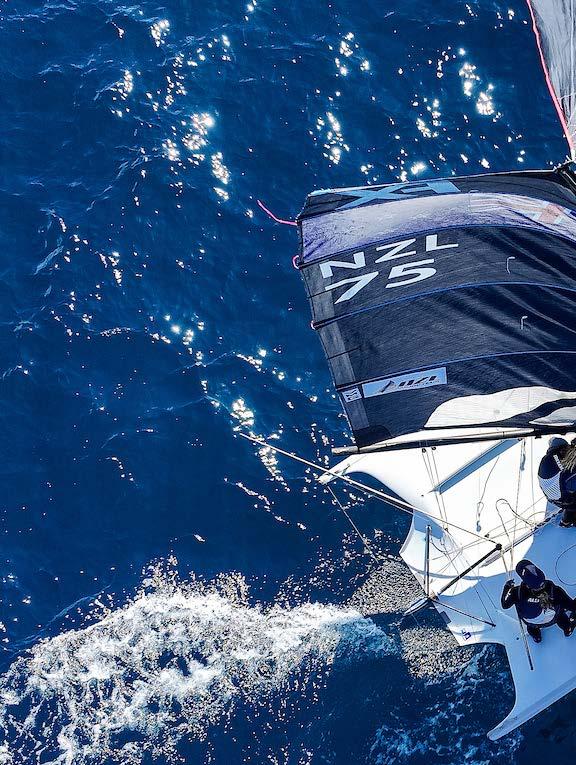
team for the Whitbread Round the World Race], so I got to know her well before we broached the idea of sailing together.
What are the biggest obstacles to a team's success?
Aleh: Being in a team is not always easy, dealing with the training loads and always being tired, with bad results or injuries. It gets hard if you are missing those basic
'Our biggest challenges were when we were doing the work but not getting the results. It's easy when things are going well – any team can do that! Getting through the difficult times is where a team is truly tested.'
Jenny Armstrong
cornerstones of trust and respect, and the ability to have honest open chats.
Armstrong: Our biggest challenges were when we were doing the work but not getting the results. It's easy when things are going well – any team can do that! But getting through the difficult times is where a team is truly tested. That's when good communication is particularly important but it’s not always easy. Sailing is about making the least mistakes, and a champion team can move on quickly to the next decision.
Sailing together means spending plenty of time in each other's company. Is it a good idea to also be close off the water?
Aleh: It depends on the partnership and the people involved.
It's easier logistically when you are happy to stay with each other off the water. Polly and I would sometimes take a bit more space, while with Molly we spent up to eight


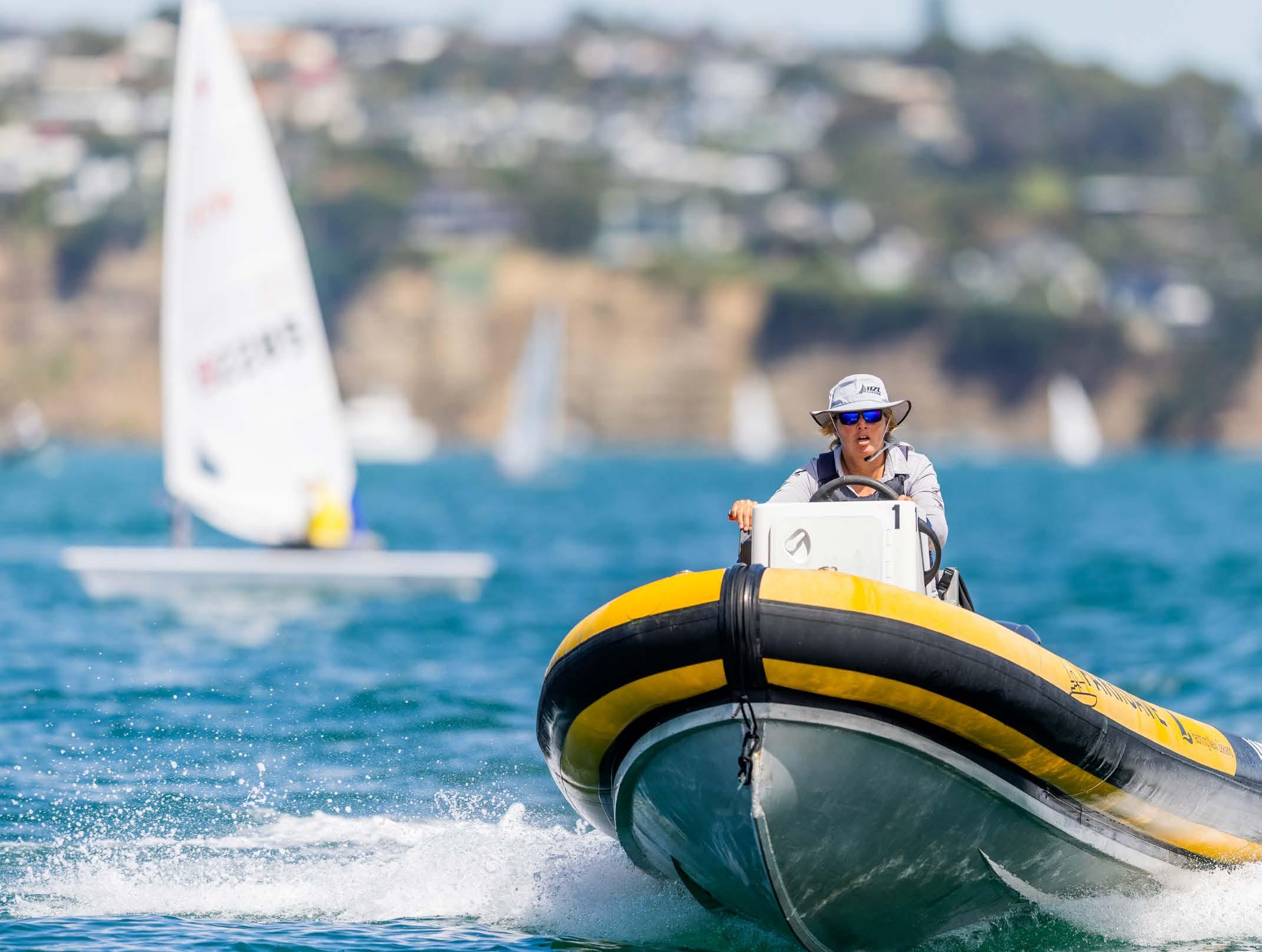
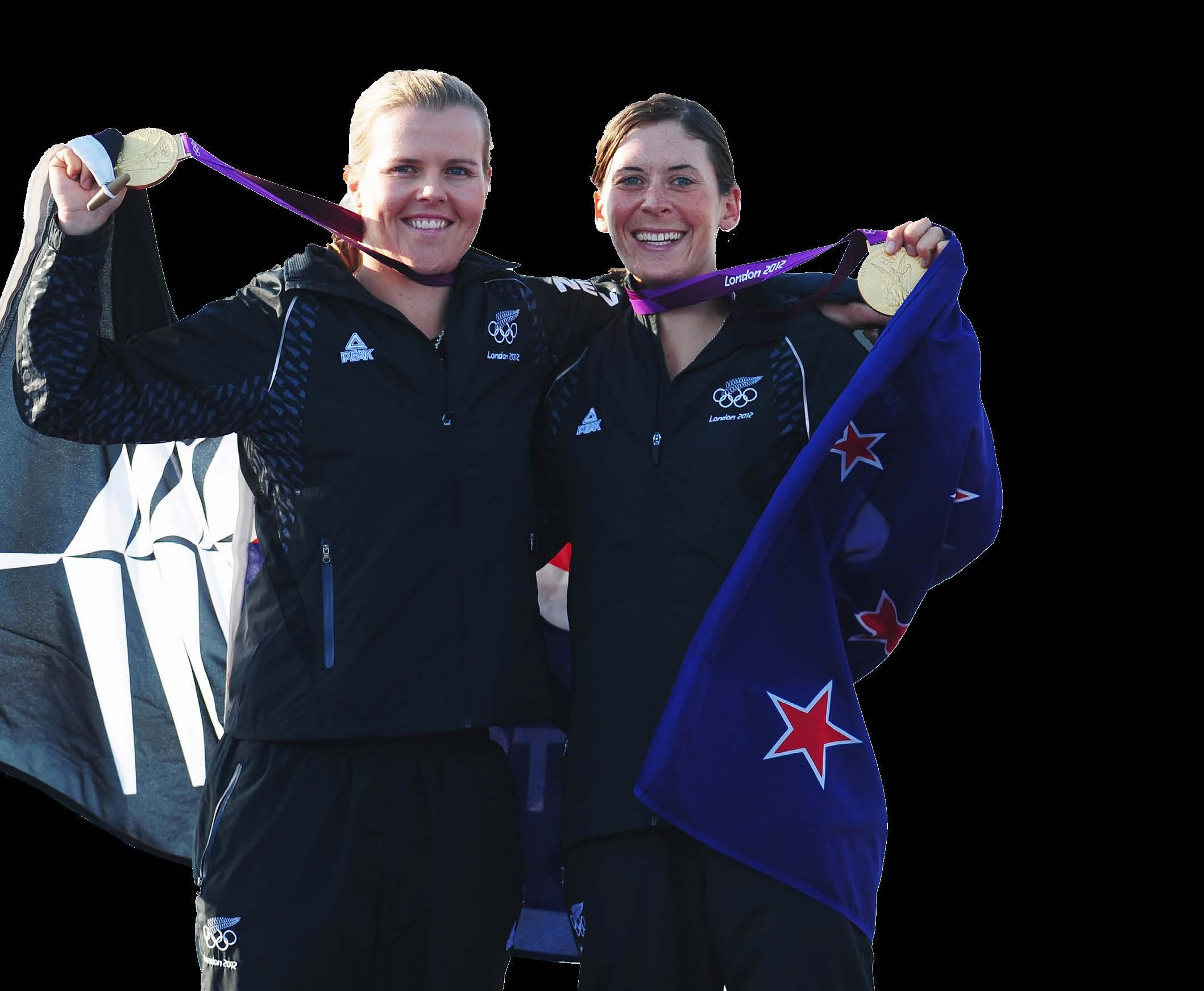
months at a time living together most of the time, so it just depends on what
It's a mixture – some teams do everything together, others when you are friends and have some things in common outside of sailing or a wider group or squad with who you can spend some time within a wider group
What if both sailors aren't quite at
This is generally always the way in any new partnership – the experiences you bring in will be different and you may have quite different strengths. It is important to be clear from the start what you believe the other person brings to the equation.
When you are going through the hard learning phases, you will have some tough times, but it means a lot when your teammate can remind you why they chose to sail with you in the first place.
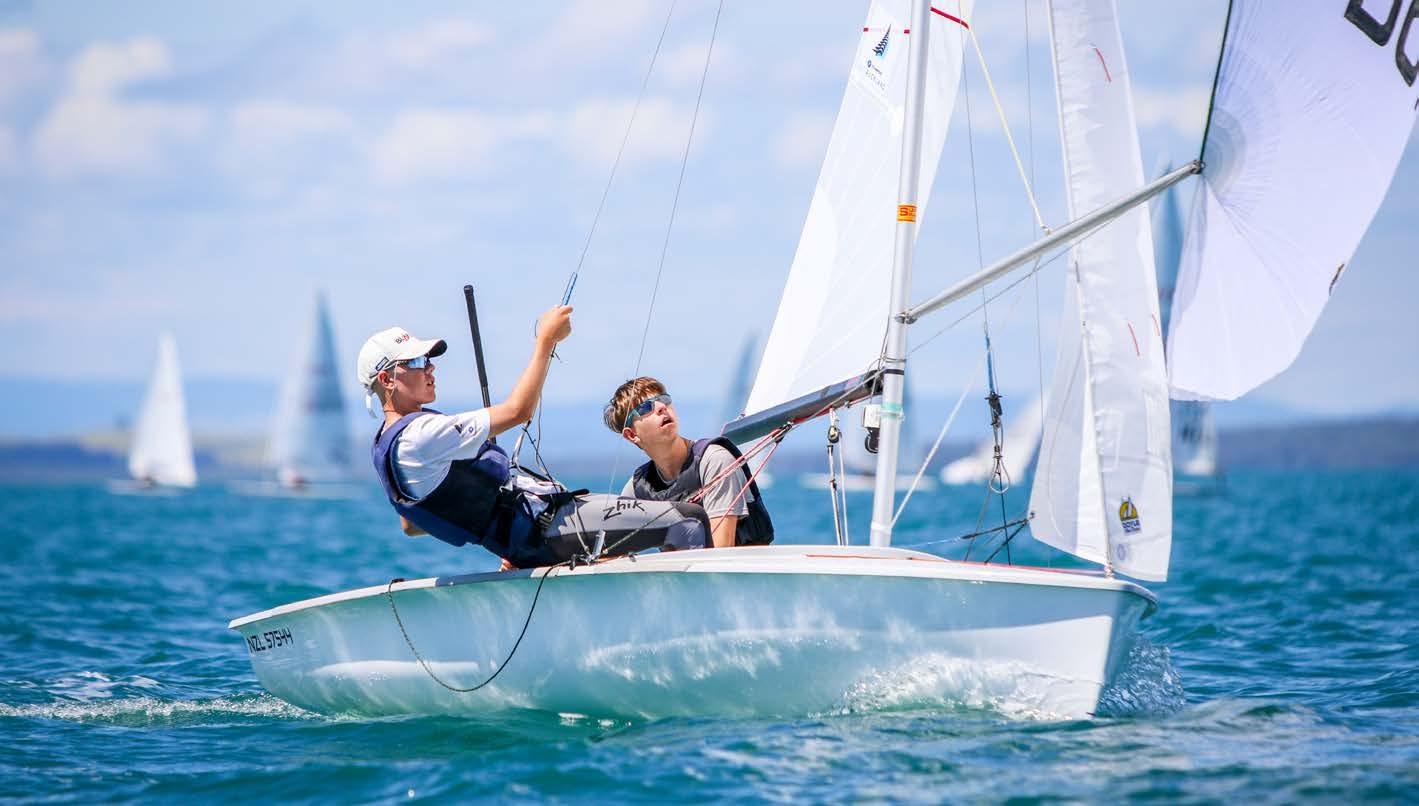
Armstrong: Everyone learns at a different pace and the most important is that the team are working towards the same goal and putting the same effort in. If there is a big age or experience gap – make sure that this is discussed at the beginning of the partnership – and reviewed as you go. The initial difference in skill or experience will change over time and how you operate as a team will also need to adjust accordingly.
Why does the helm often still get more recognition than the crew?
Aleh: This is an issue through sailing, unfortunately, but any good helm knows they could not do any of it without their crew. I think it's very simple but also important whenever you are talking about your results or speaking to media, that it's clear you are a team – it's "we", never "I". Always have respect for the other's roledoing a bit of sailing switched helps keep someone humble who thinks they can do the other role better!
Armstrong: In many ways, the crew is the most important person on the boat. Without them, the team won't achieve anything. It's important for the helm to understand this and always encourage the crew to step forward. You see this with all the good teams.
How important is role claritydeciding who does what on the boat and off it? Do these roles change over time?
Aleh: This is usually quite clear when you start sailing together, as you will each have your strengths and weaknesses. Molly is super organised, so she generally took
on the logistics and accommodation, while I kept track of all our equipment logs and Excel spreadsheets. On the water, the roles are often more practical and boat-based –i.e. who has more capacity and vision makes the decisions, and the other person feeds info. But again, there are different ways to get a boat around the course, so you will often play to each other's strengths.
Armstrong: There are no limitations or strict rules. Each team will look different. It's about creating what works best for your team. Both helm and crew must know their roles and their responsibilities with communication of information and their role in decision-making at different points around the course. Often teams create their own language on board for clarity and ease of communication when under pressure or in extreme conditions.
What's the best way to handle conflict between teammates?
Aleh: I have been lucky with my crews, that we were always able to talk through things and figure it out, but sometimes it helps to have a third party, like a coach, to help facilitate a more positive and constructive conversation. We often also used psychologists as a team to help us develop better frameworks and shared understanding, so we know how to work through things when they come up. A lot of dealing with conflict is first understanding yourself, and how you react to things.
Armstrong: Trying to perform under pressure doesn't always bring out the best in people and this is where it's important

Sailing with a mate should be fun, according to

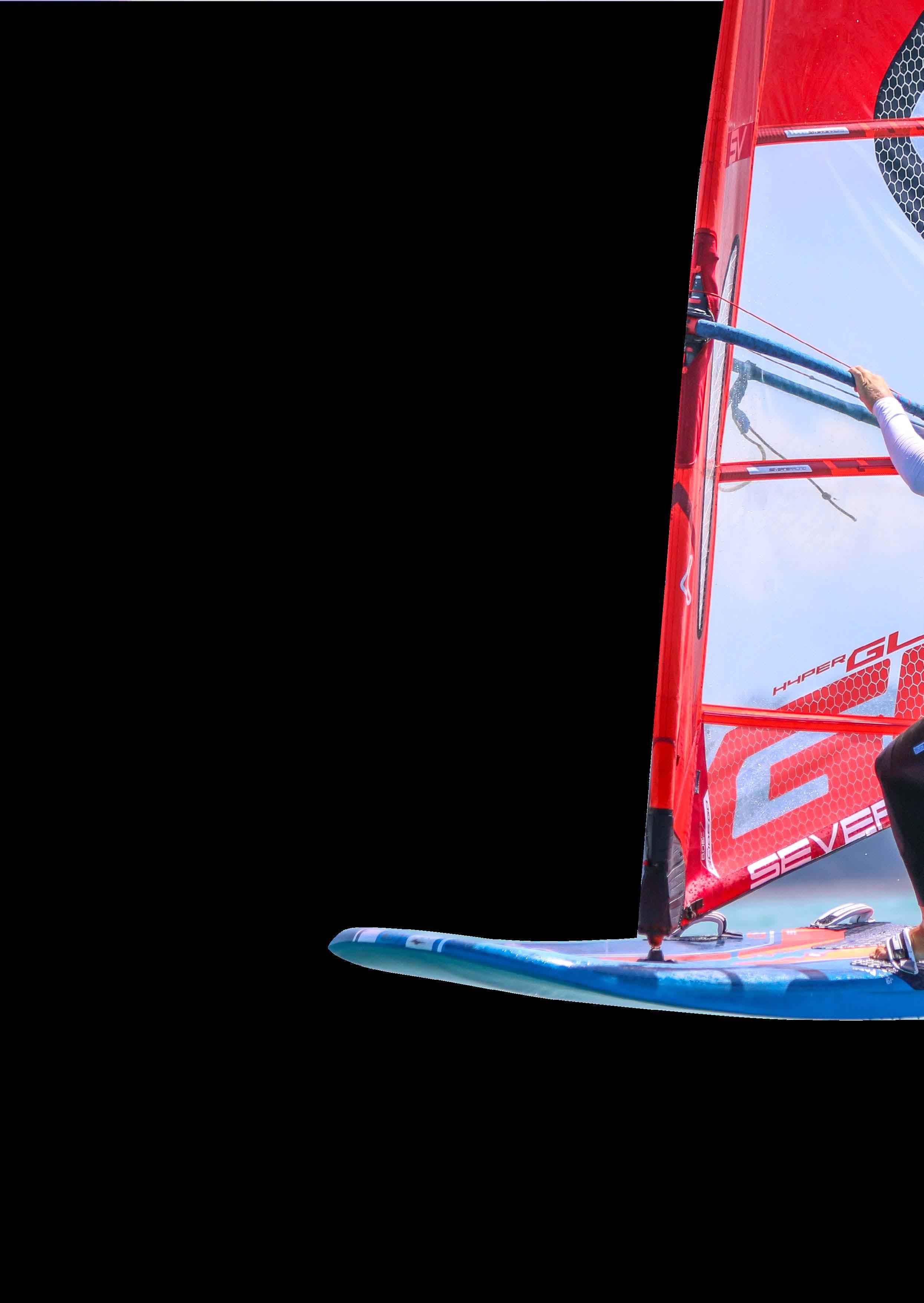
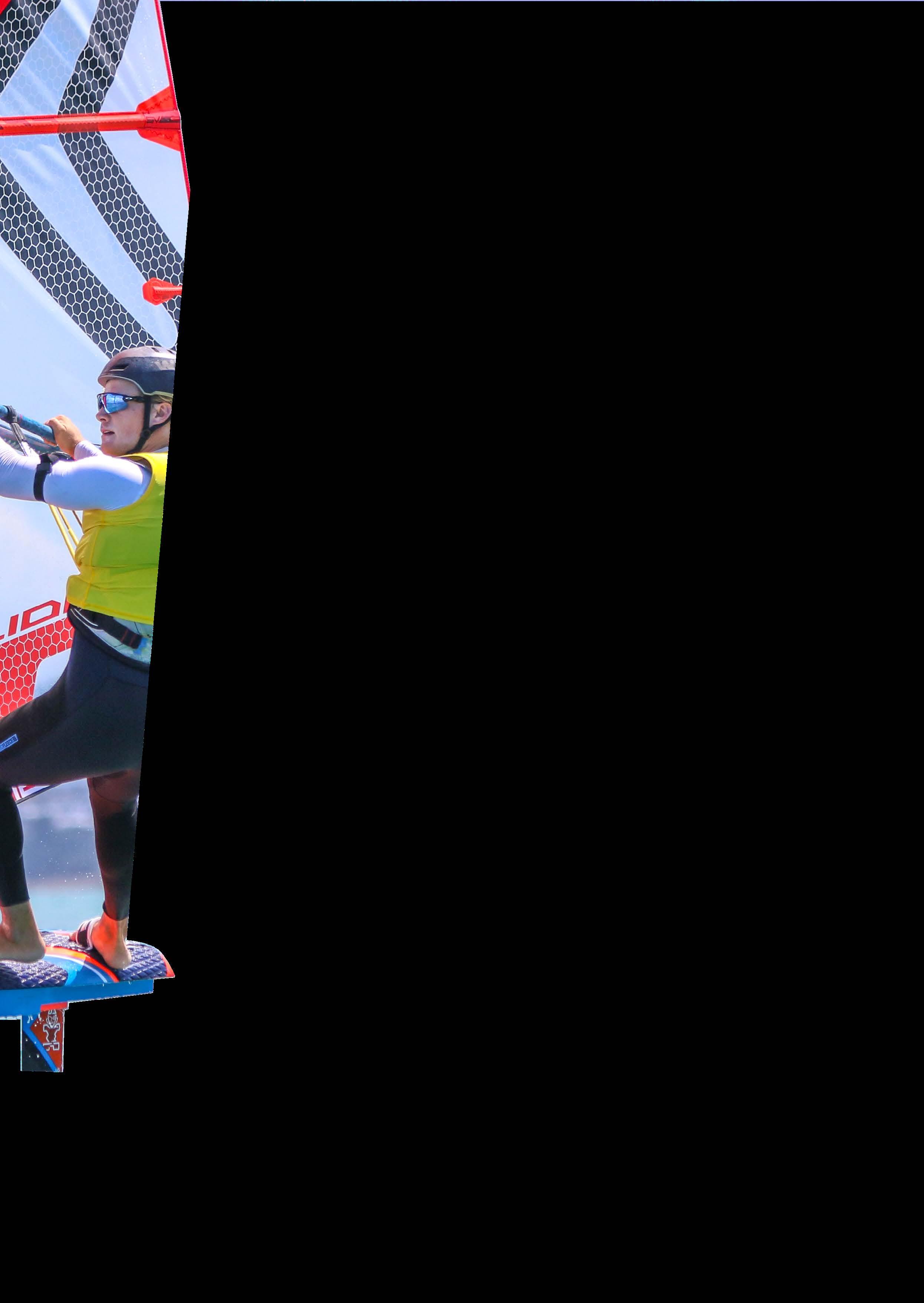

Continued from p25
every day. Eventually, some guys saw me cartwheeling down the lake and suggested I get better gear and start training with those who knew what they were doing!"
Although windsurfing is now his priority, Liefting still has a passion for skiff sailing. In January, he and rising 49er star Blake McGlashan won the 12ft Skiff Interdominions in their first regatta together, stepping in as last-minute replacements aboard Monkeywrench
"There's not much windsurfing happening at that time of year, and with the Moth world championships on, Blake and I decided to jump in. He was incredible in the 12 – it was great to use his 49er experience.
"We weren't expecting to do that well, but we jumped into a borrowed boat and won the whole thing, which was pretty special. Some of those guys put everything into their boats, so to come in and win was unexpected but amazing."
A few weeks later, Liefting added the 18ft skiff national title to his growing list of accolades, taking out the event with Adam Mustill and Josh Schon.
'I was jumping around a lot. I always knew I wanted to sail an Olympic class – I’ve been passionate about that from the start – but I just didn’t know which one.'
The trio also finished eighth at the prestigious JJ Giltinan 18ft skiff championships in Sydney in March, with Alex Vallings, Matt Steven and Brad Collins the best-placed of four Kiwi crews, in fourth.
Abackground in traditional sailing has given him an advantage in iQFOiL, Liefting believes.
"Understanding race dynamics in slower boats helps with reading the game," he said. "The windsurfing side is new, but the racing itself comes naturally to me. The biggest adjustment is the speed – everything happens so much faster in foiling."
For now, skiff sailing will take a back seat as Liefting prepares for another European campaign. And while the Los Angeles 2028 Games are still nearly four

years away, he has already set his sights on them after witnessing the success of his Kiwi teammates in Marseille.
"I never thought I'd be campaigning for the Olympics on a windsurfer, but Silvaplana was a real turning point for me. I went in wanting to do well, and that event made me realise I could actually be competitive at this level," he said.
"This year will be important. It's getting more serious, and I realise it will take up more time. I'm working hard –doing everything I can to be the best at this. When you put in the effort and see results, it's incredibly satisfying."
Before then, there's plenty of hours on the water with Yachting New Zealand Olympic coach Nathan Handley and the rest of the windfoil squad.
"We have such a strong fleet, with lots of youth and juniors coming up. Working with Josh and Nathan as a team to push each other has been really valuable."
Liefting sees the team-first ethos in the squad as crucial to making his Olympic dream come true.
"My goal is to help get our team to be the best in the world, and hopefully, we can all reach the top together."


Windfoil NZ
Category: Boardsailing
Established: 1857
Annual membership: $60 (adults), $40 (under-18s)
2025 national champs: Eli Liefting & Veerle ten Have
Next events:
Princess Sophia Regatta
Palma, Spain, March 28-April 6

French Olympic Week
Hyeres, France, April 19-26
iQFOiL Games
Torbole, Italy, May 6-10
President: Gary Hill
Phone: 027 299 2725

email: secretarywindfoilnz@gmail.com
Website: www.windfoilnz.com


Summer is national championships season in New Zealand – and this year, we had a few familiar (and several new) names to add to the list of winners.
Waszp nationals
Naval Point Club Lyttelton
March 14-16
A dominant Jasper Camenzind secured the crown with five wins from 12 races. He also finished in the top three in five others to take out the overall and
youth title.
Will Mason was second overall (and first junior), with Ash Cole third. Top female went to Elise Beavis, with Charlotte Philpott second (and in 12th overall in the 18-boat fleet).
Dave Shaw won the master category. Full results here.

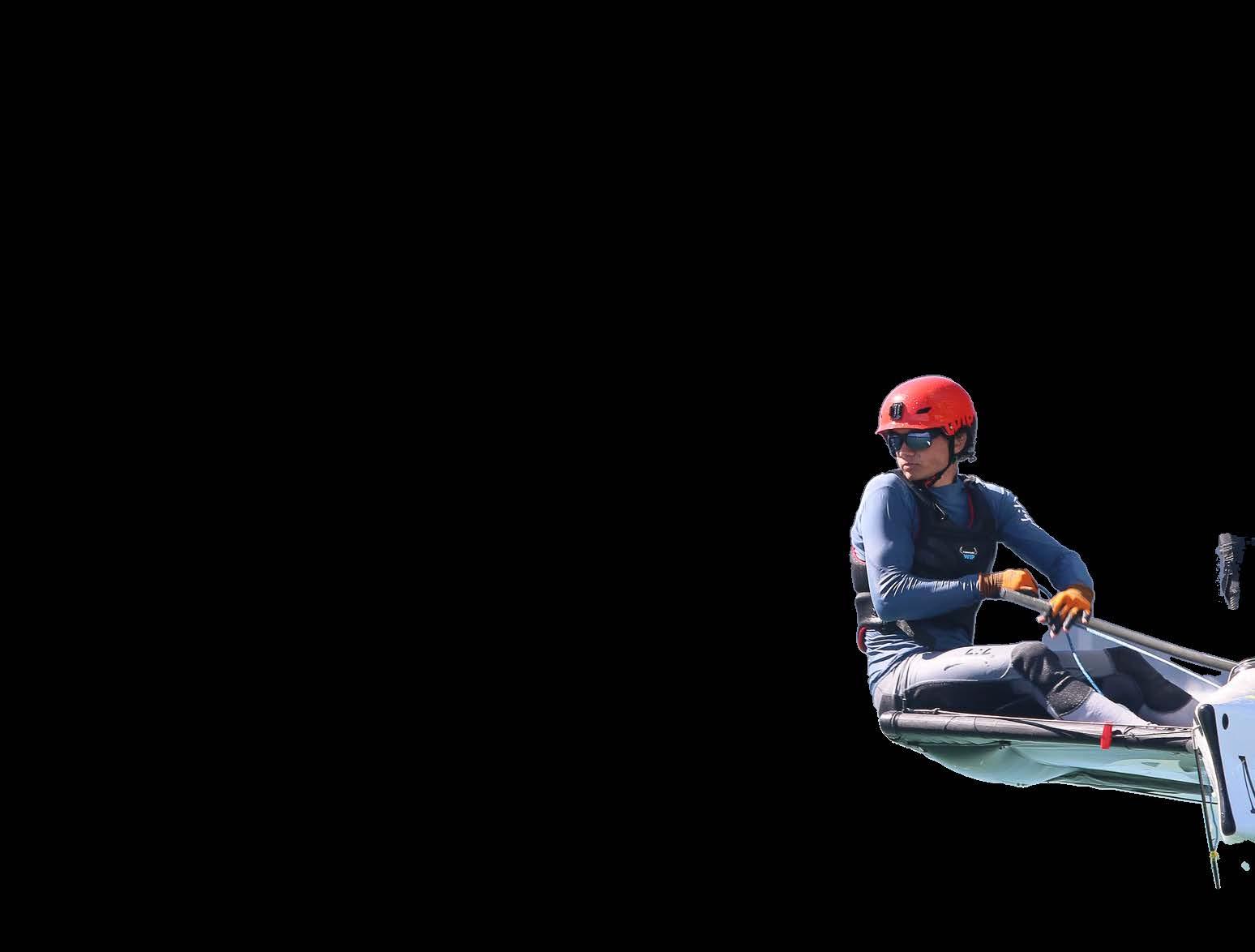
Young 88 nationals
Bucklands Beach Yacht Club
March 21-23
Karyn Drummond made history by becoming the first female helm in over 30 years, and only the second ever, to win the title. Sailing Flash Gordon, Drummond and her crew took out line honours after a consistent performance in tough conditions. They finished in the top four in six of the seven races, including two wins, edging out defending champion Harry Thurston (Dangerzone) by three points.

Drummond also won the Tanaka Cup for top owner-driver and Mixer Trophy for the highest-placed boat with a mixed crew. Full results here.
Sunburst nationals
Queen Charlotte Yacht Club
March 15-16
Over 50 sailors battled varying conditions, from light winds on the first day to strong gusts of up to 30 knots on the last, but no one handled it better than Wakatere Boating Club’s Craig and Roberto Beavis. The father-son duo won four races to secure the title by three points from club teammates Bruce Yarnton and Rebecca Garcia. Matthew Hix and Amanda Hargreaves of Waimakariri Sailing Club took third.

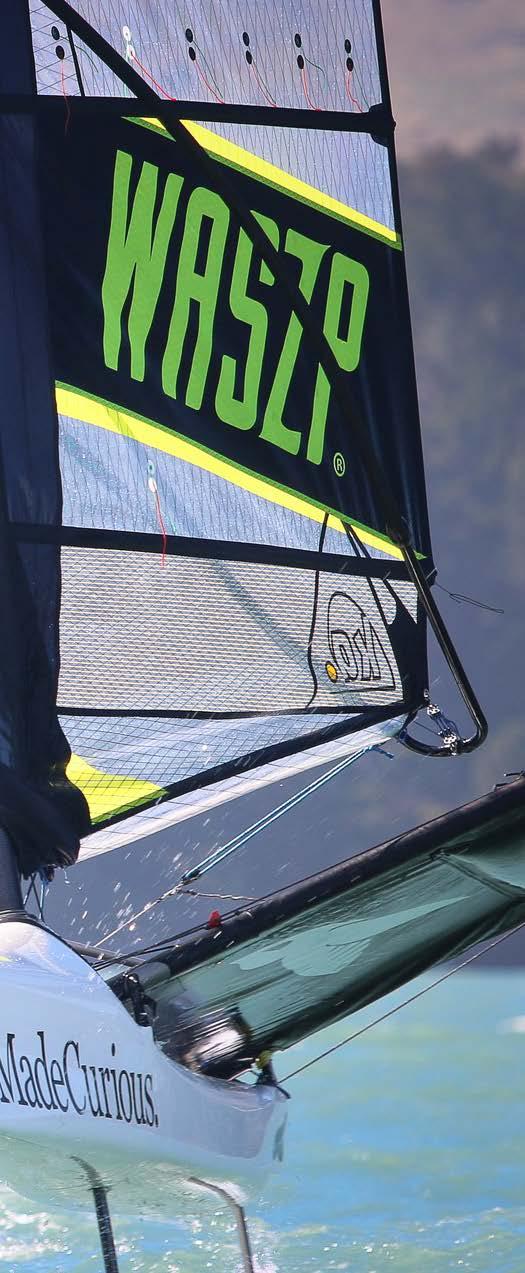
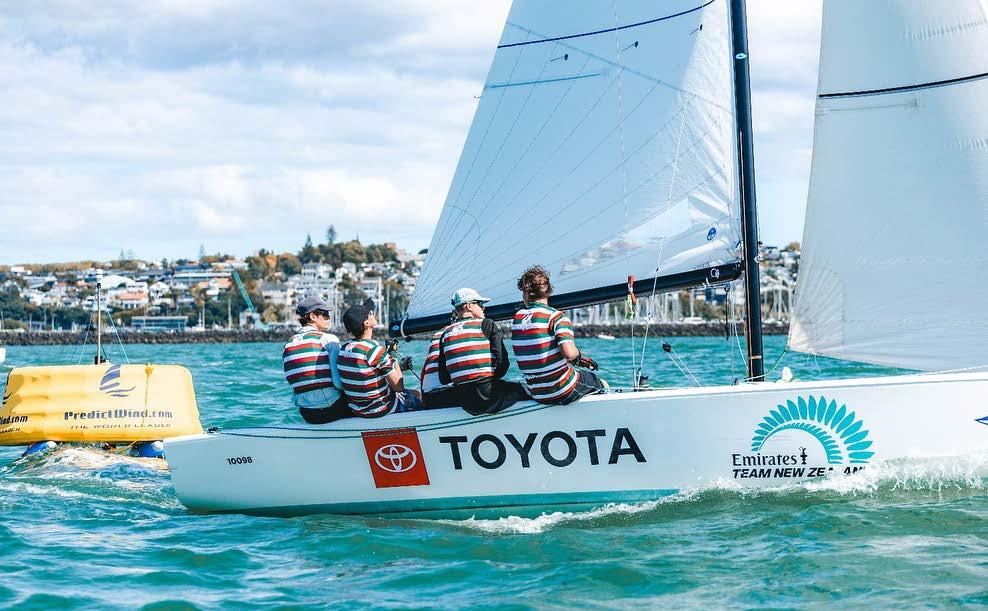
Secondary schools
keelboat nationals
Royal New Zealand Yacht Squadron
March 14-16
Westlake Boys’ High School triumphed after three days of competitive racing in the Emirates Team New Zealand Elliott 7 fleet.
Wingfoil nationals
Wakatere Boating Club
March 7-9
Sean Herbert secured his second consecutive class national title in emphatic fashion.
The regatta, held annually since 2007, saw 20 high school teams from across the country compete on the Waitematā Harbour. Light winds challenged sailors throughout, but Westlake’s crew navigated the conditions best to secure the national title after a weekend of tactical racing. Full results here.

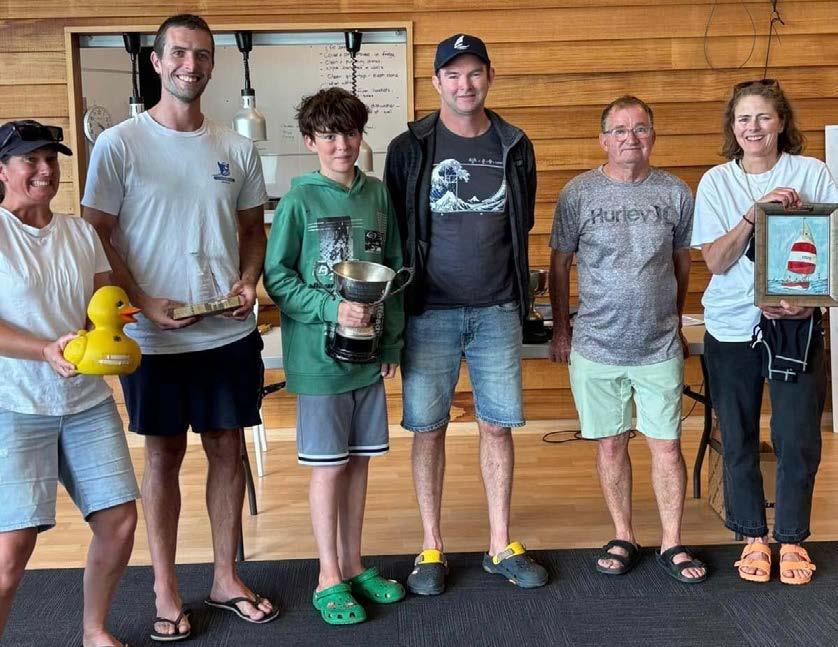
The 23-year-old won an impressive 11 of 14 races to finish 17 points ahead of runner-up Jeremiah McDonald, with Kosta Gladiadis claiming third and the youth title.
Stella Bilger was the top female competitor, while Jon Bilger won the master division, and Andrew Mitchell took the grand master title.
The Kiwi wingfoil fleet continues to show impressive growth with a total of 117 competitors battling it out in, at times, spicy conditions. Full results here.
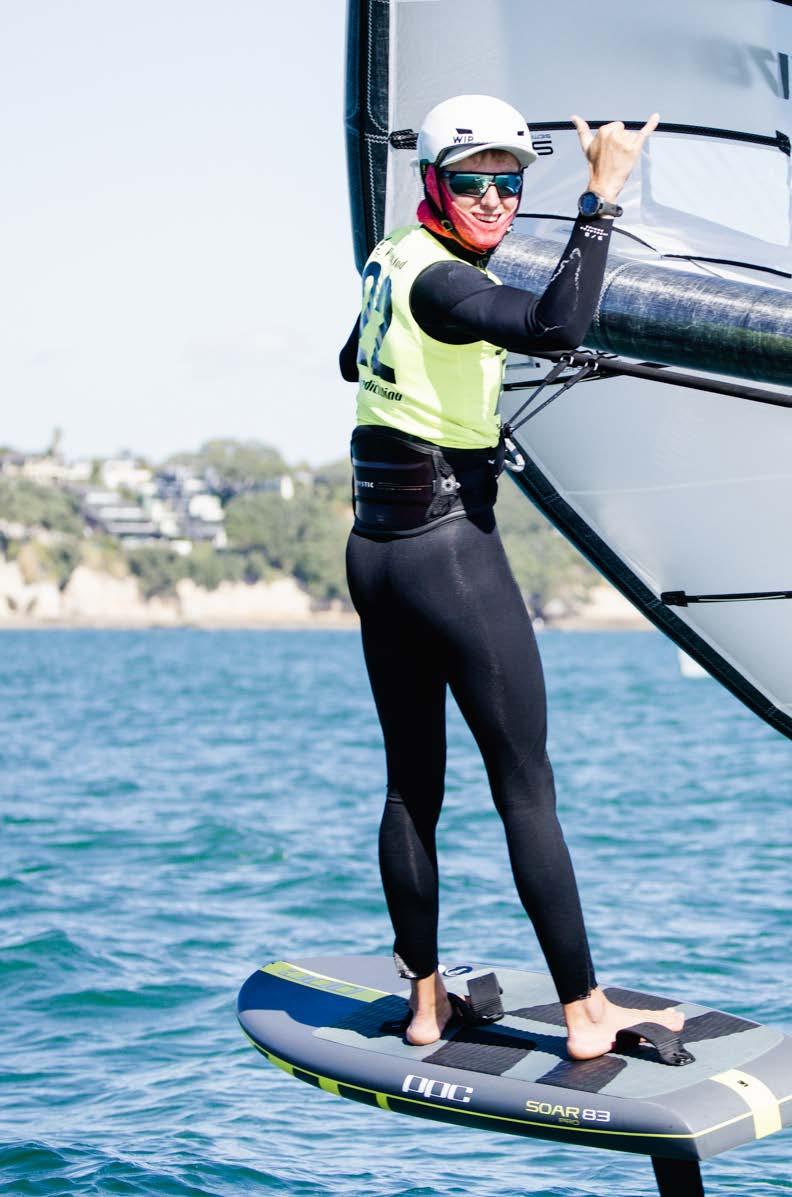


Kitefoil nationals
Bay of Islands Yacht Club
February 20-23
Lukas Walton-Keim and Lucy Bilger were crowned New Zealand national kitefoil champions at the FOIL Bay of Islands.
Walton-Keim, who made his Olympic debut in Marseille last year, won five of eight races to see off the challenges of Oscar Timm and Andy Robertson. Bilger beat another 2024 Olympian Justina Kitchen by two points to finish first female and sixth overall.
Noora Ruskola was third. Robbie Naismith, Robbs Hielkema and Jeremy Peck made up the podium in the silver fleet.
Full results here.
420 nationals
Takapuna Boating Club
March 6-9
The rebuilding of the domestic 420 fleet gathered momentum with the national championships at Takapuna Boating Club.
The class nationals was the second major regatta in as many weeks for the double-handed dinghy, following the 2025 Oceanbridge Sail Auckland regatta hosted by Torbay Sailing Club.
Cam Brown and Oli Stone claimed the title impressively, securing seven wins in 12 races in shifty, gusty conditions to take the overall title by five points ahead of Tessa Clinton and Amelia Higson. Clinton and Higson had dominated the fleet to win the Sail Auckland title the previous week, with Brown and Stone withdrawing late in that competition. Both crews are relatively new pairings. Brown, who represented the NZL Sailing Foundation youth team in the boys’ 420 with Alex Norman at last year’s World
O’pen Skiff nationals
Plimmerton Boating Club
February 27-March 2
Oliver Tiedemann and Dahlia Fyfe were the standout performers in Porirua. Fyfe led the competition at the end of day one and finished second overall, securing the top female and
under-17 titles.
Sol Douwes claimed third overall and second in the under-17 division, while Tiedemann, the overall winner, also topped the under-13 category, with Honor Fyfe finishing third in that age group.
Full results here.
Sailing youth world championships on Lake Garda, teamed up with Stone earlier this year.
Clinton, at 16 already a veteran of two youth world championships, joined forces with accomplished Starling sailor Higson this season.
“The regatta was raced in challenging southerly,” said Yachting New Zealand coach Jenny Armstrong.
“Cam and Oli adapted best and came out on top, but Tessa and Amelia pushed them closely, while Thomas [Jurczyluk] and Oliver [Wyeth] also picked up a win.”
Leading the charge from the South Island were Christchurch crew Saxon Foggo and Sam Nicholl, who finished third overall.
Armstrong and other coaches led twice-daily briefings with the 420 group – discussing weather, currents and daily priorities before racing, and reviewing the day’s racing once competitors got off the water.
Full results here.


Zephyr nationals
Tauranga Yacht and Powerboat Club
March 4-8
Photo: Zane Shackleton
Murrays Bay Sailing Club stalwart Scott Leith secured the overall win with three victories from seven completed races, to end the reign of serial national champion Mark Orams, who did not compete this year. It was the first time Leith, a 10time ILCA masters world champ, had
sailed the Zephyr competitively. Rod Dawson finished second, while Mike Drummond took third place. In the women’s division, Worser Bay Boating Club duo Polly Wright and Amanda Hargreaves claimed the top two spots, with local sailor Jess McDowell in third. The event, New Zealand’s longestrunning adult dinghy sailing national competition, remains one of the country’s most popular. Full results here.
Finn nationals
Waiuku Yacht Club
March 1-4
Ray Hall is the new Finn class national champion, after dethroning last year’s winner, Richard Hawkins, in a thrilling regatta.
The event was a big test for the 21
competitors, with the North Island championships preceding the nationals, creating a five-day, 15-race challenge. The fleet featured strong representation from across New Zealand, including five South Island sailors, as well as two competitors from Queensland. Hawkins finished runner-up to Hall with Karl Purdie taking third.
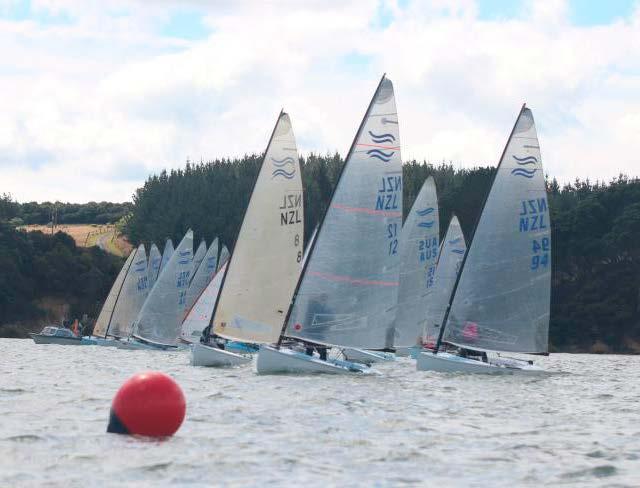

Luxury Charters in Auckland DISCOVER THE WASTING LIGHT EXPERIENCE
Bespoke charter packages
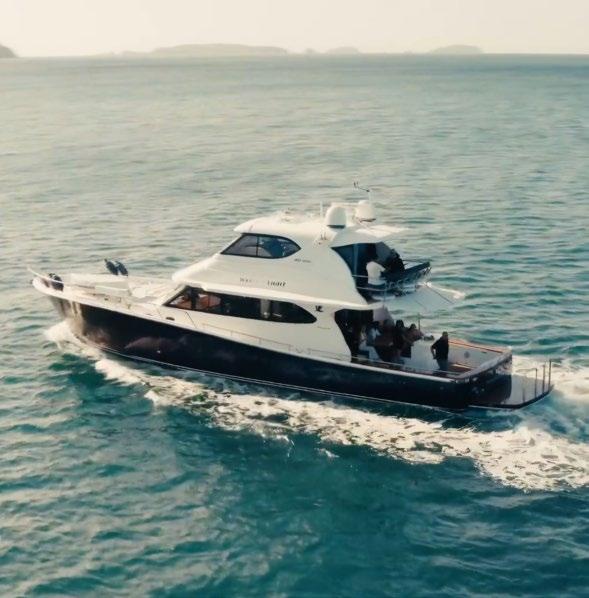
Maritimo 70
Length: 68’11” / 21m
Passengers: 6 overnight | 36 day trip
Toys: E-foil | Jetski | SUP | E-surfboard | Kayaks | Our boat
Half/full day and overnight options available.


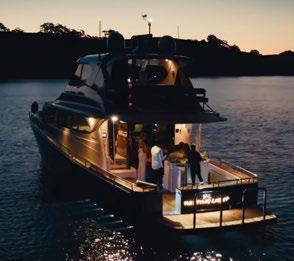
A Class and Tornado nationals
Milford Cruising Club
February 20-23
For Milford Cruising Club, the A Class and Tornado national championships provided more than just an opportunity to showcase the club’s prime location and shake off the cobwebs after several years without hosting a major regatta. It was also a valuable dress rehearsal for an even bigger test in just a few months. According to club commodore Andrew Robertson, the success of the regatta was largely due to the hard work of the MCC, the New Zealand A Class association, and the New Zealand Multihull Yacht Club, as well as an incredible team of volunteers.
“It’s been a long time between drinks for the club to host a regatta of any type, so when we were approached by the NZ A Class association and the Multihull Yacht Club, I had some trepidation.
“Whilst the club has a great spot on the foreshore reserve to hold these types of events, the course was proposed over the Hauraki Gulf cable protection area, so positive engagement and support from the council, Spark and Maritime NZ was critical. The club also has limited on-water assets and experience in organising these types of events,” he said.
“A lot of work went in from all three organisations, but what really pulled the
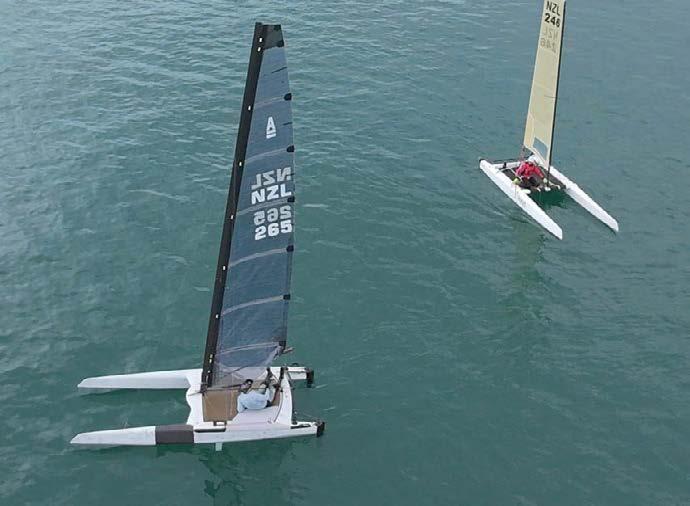
event together was the on- and off-water volunteers, including the race officers, the support from other clubs to utilise their RIBs, and the Tornado and A Class sailors themselves.”
Winston Ordish-Benner and Shanae Ahern from Tauranga Yacht and Powerboat Club were crowned 2025 Tornado national champions, while Dave Shaw (Nelson Yacht Club) claimed the A Class open title, and Pat Ashby (Wakatere Boating Club) won the A Class classic division.
The club’s attention now turns to the A Class world championships from November 12 to 16.
“It was a great event and went better than hoped, but it really was also an opportunity to teach us what we didn’t know,” said Robertson. “A lot was learnt, and these lessons will be taken forward as we prepare for the worlds in November.”
Full results here.
Hansa 303 nationals
Titahi Bay Boating Club
February 14-16
Graham Hook won the Hansa 303 national singles title in a closefought battle with Darrell Smith at Titahi Bay Boating Club – before both sailors competed at the class world championships a few weeks later. Hook and Smith finished ahead of Eric Kemsley, while, in the doubles, Angus and Richard Bates pipped Xervier and Paul Doney, with Kerihi Maxwell and Rhonda Ritchie in third. Lucas Thompson beat Xervier Doney for the singles Ability Cup, while the Doneys finished ahead of Thompson and Alexander O’Conner in
the doubles. Hook and Smith were two of eight Kiwis to sail in the singles open fleet at the Hansa world championships at Australia’s Royal Prince Alfred Yacht Club (RPAYC), finishing 36th and 26th overall. Xervier Doney (70th), Michael Jones (63rd), Thompson (68th), Ritchie (54th), Richard Chamberlain (29th) and Paulien Chamberlain (30th) were also in action in the singles Down Under. Tony Vaka was the best-placed Kiwi at the worlds – finishing fifth in the Liberty Open, with Brian Trubovich (11th), Paul Speight (15th), John Buchanan (24th) and Maqymseahe Ninces (29th) also competing in the class. Paul Wager and Annika Pennifold were sixth in the SKUD 18. Full results here.
Starling match racing nationals
Glendowie Boating Club
February 6-9
Tom Pilkington can add another accolade to his growing list after taking out the NZ Starling match racing nationals over Waitangi weekend. Representing North Harbour, Pilkington triumphed in a thrilling final against Leo Brown (South).
Blake McKinnon (Auckland) secured the bronze medal, rounding out a highly competitive podium.
In December, Pilkington was awarded the prestigious Sir Peter Blake Memorial Trophy, one of New Zealand youth sailing’s most coveted honours, after winning the ILCA 6 competition at Torbay Sailing Club.
Full results here.
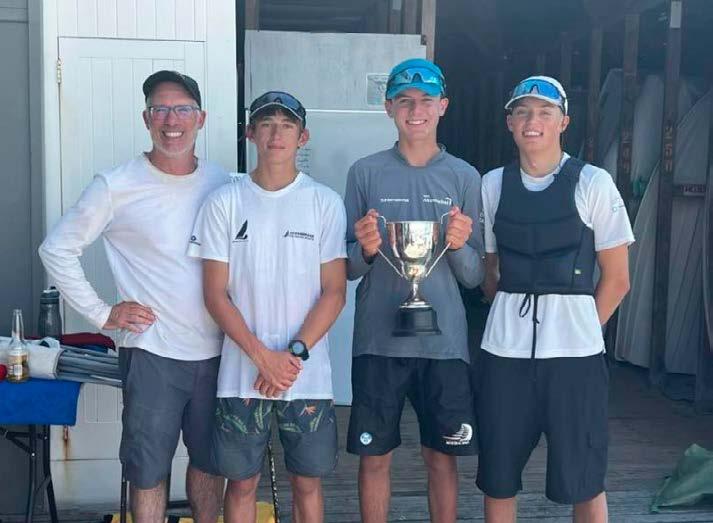
Paper Tiger and OK Dinghy nationals
Queen Charlotte Yacht Club
February 5-8
Sailing victories don’t come much more convincing than Hayden Percy’s triumph at the 2025 Paper Tiger national championships. The Napier Sailing Club member won nine races and dropped scores of 3 and 5 to beat Owen Jenkins by a mammoth 26 points. Jason Brownlie was third. In the OK Dinghy fleet, 31 boats from across the country battled it out in the first class nationals in the South Island since 1984. Sean Cleary, who finished fourth at last year’s edition, clinched the title with a race to spare after not finishing worse than second across nine races. He was followed by Steve McDowell and Alastair Gifford.
Annabelle Rennie-Younger finished first female, 16th overall.
Full results here and here.
ILCA nationals
Nelson Yacht Club
January 15-19
Improving as a sailor isn’t just about making gains on the water; the work you do before you push off is just as important. That has been especially true for 2024 Olympian and new national ILCA 6 champion Greta Pilkington, who has put in the hard yards since returning from her debut Games in Marseille last August. Pilkington claimed the national title in Nelson in January with a commanding 23-point lead, securing four wins and four second place finishes in the 10-race series. This follows her 34th place at the Games, where the 21-year-old became the first Kiwi to compete in the class since 2012. She defied her age and relative international inexperience to outperform several of the world’s top women’s dinghy sailors.
“It’s always a pleasure to race in New Zealand again after spending a lot of time competing overseas,” Pilkington said. “This was my first time racing in Nelson, and I focused more on the process of each race rather than the outcome – turning bad races into keepers, executing well, and taking it race by race. I believe that helped with my consistency.”
She returned to home waters after securing top-10 finishes at three regattas in Australia - Sail Melbourne, Sail Brisbane, and the Australian ILCA national championships - late last year, following a
short break from racing and training. The nationals were made even more special as her youngest brother, Tom, finished third in the ILCA 6 fleet, while older brother, George, made the podium in the ILCA 7 competition.
Former world champion George Lane was second overall in the ILCA 6, with Coco Barrett (seventh overall) and Chloe Turner (eighth overall) the second and third female.
Phil Wild finished first in the Masters fleet, followed by Josh Edmonds and Werner Hennig, with Sandra Williams, Helen Spencer and Holly Curtis the best-placed females.
In the 37-boat ILCA 7 event, Caleb Armit won a thrilling battle against Dylan Forsyth on countback.
Brooke Mundy, Lucy Luxford and Ellie Tapper took the podium spots in the ILCA 4 fleet.
Full results here.
P Class nationals
Charteris Bay Yacht Club
January 7-11
Blake Batten added his name to an illustrious list of Kiwi sailors to have claimed the P Class national title, with a commanding win. He claimed the Tauranga Cup courtesy of four bullets in nine races – joining the likes of Dean Barker, Simon Cooke, Ray Davies, Leslie Egnot and Isaac McHardie as winners of the event.
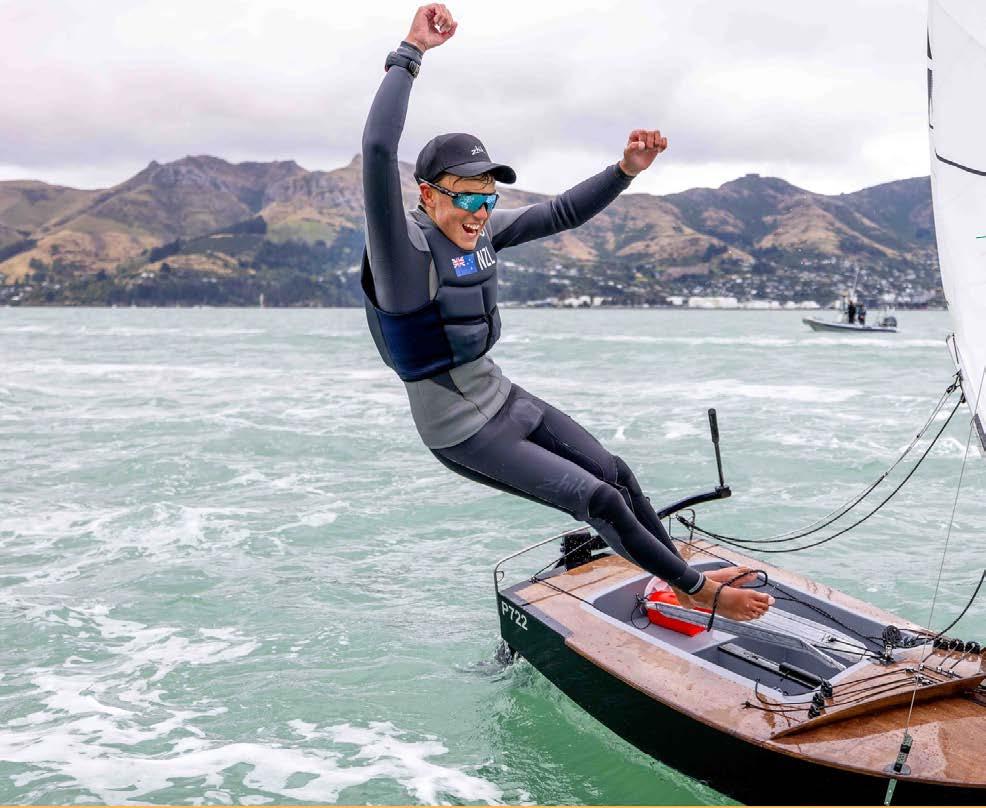
Nathan Soper and Finloe Gaites rounded out the top three with Charlotte Handley lifting the Naomi James Trophy for finishing first in the girls’ division, followed by Zofia Wells and Mila Blundell.
Batten and Handley earlier came second in the Tanner Cup and Centenary Cup respectively, which was won by Hamish Brown and Greta Hutton. Full results here.




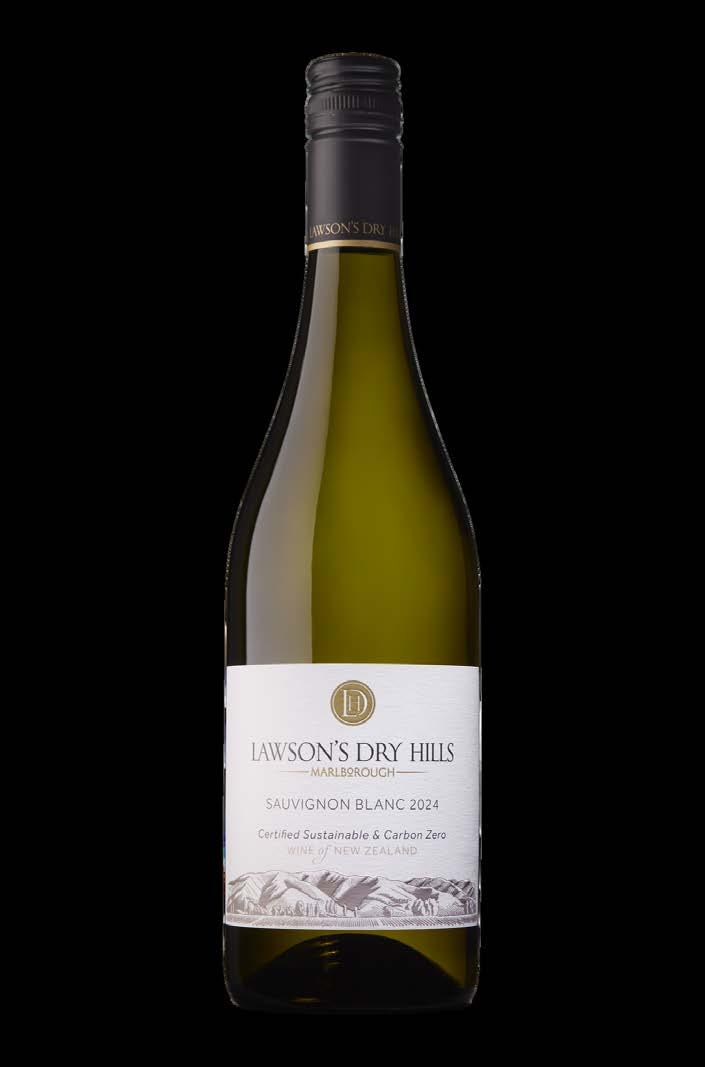

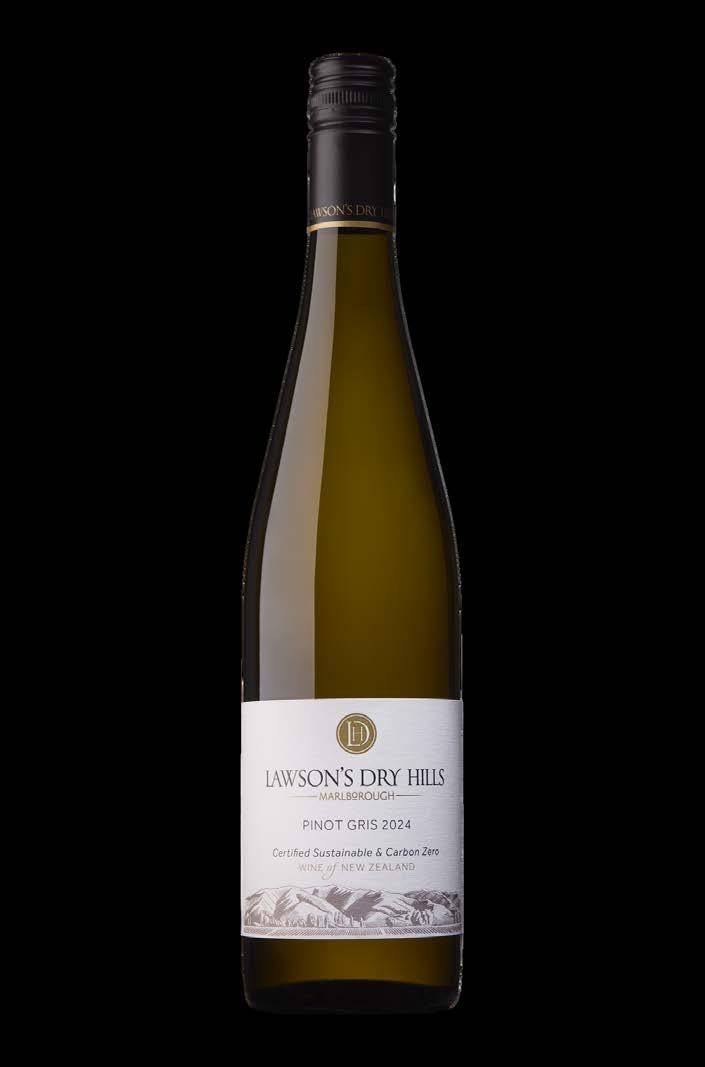
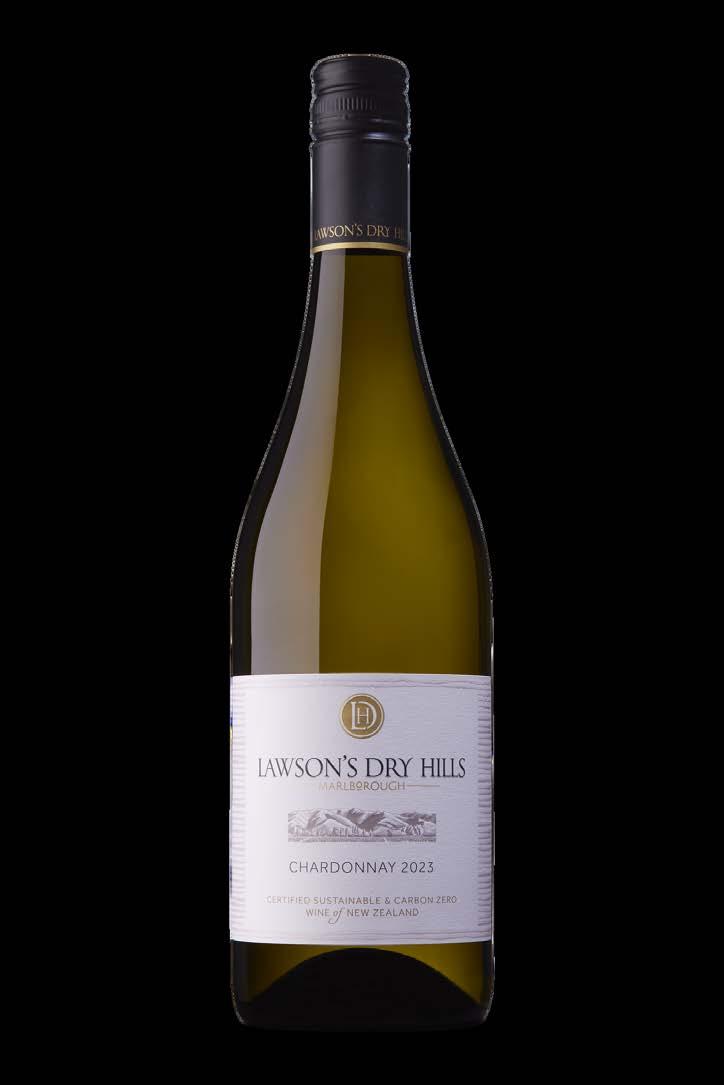

The 2025 Sydney-Hobart left esteemed Kiwi skipper Sharon Ferris-Choat ‘shell-shocked’. But, as she tells Suzanne McFadden, getting her crew safely across the finish line was one of her proudest sailing moments.
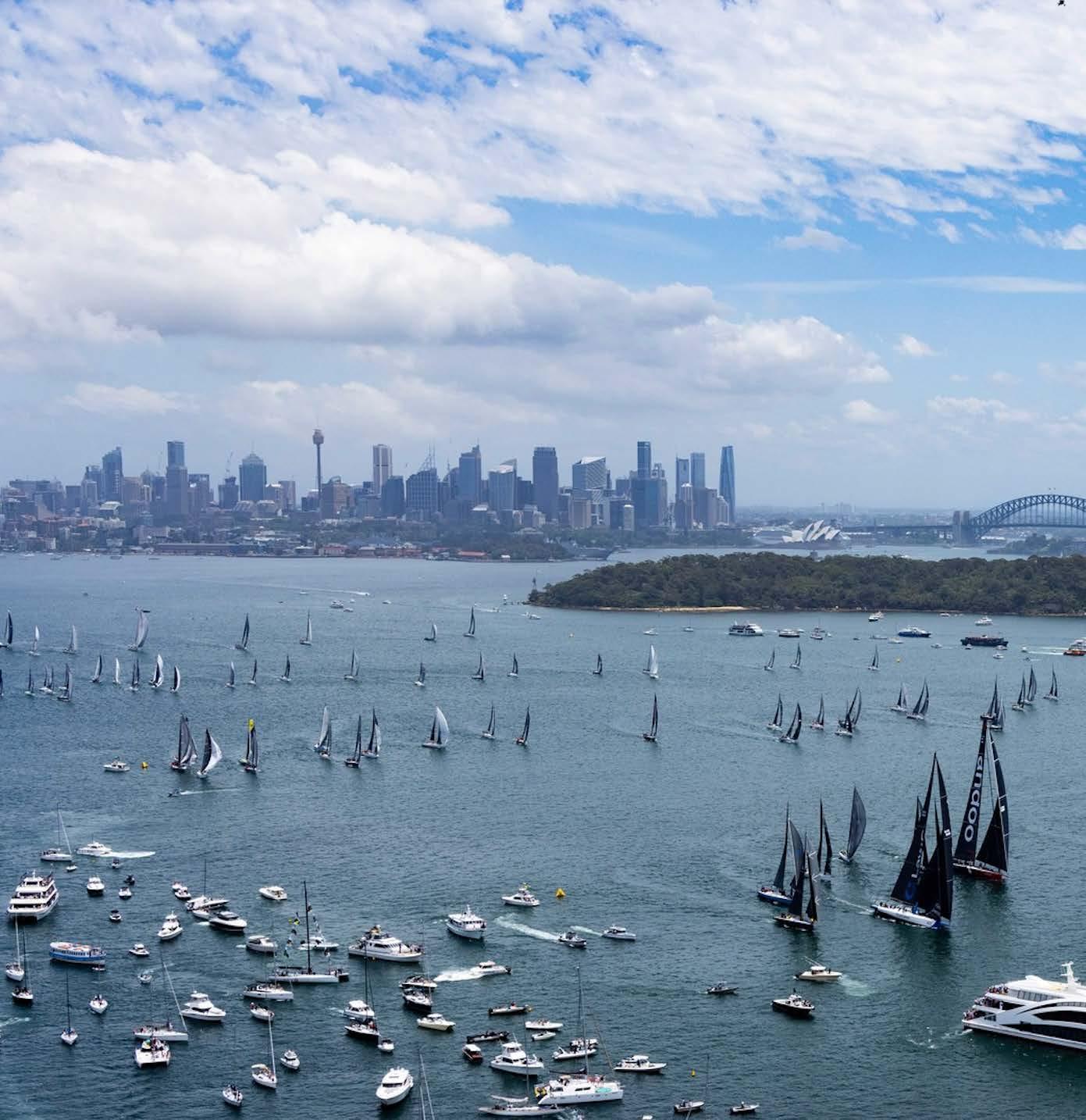
Two months after completing her first Sydney-Hobart race, Sharon FerrisChoat was still grappling with the impact of the harrowing ordeal.
A seasoned round-the-world sailor and Olympian, who’s held multiple world speed records, the Kiwi has experienced some gnarly moments at sea in her vast and varied career – but this race left her stunned.
“I’m a little more over it now, but I came home from that race feeling shellshocked. Almost numb,” the Kerikeribased skipper says. “It’s taken a wee while
to recover physically and mentally.”
A credit to her leadership and seamanship, Ferris-Choat’s crew on board the IMOCA Open 60 yacht Awen arrived in Hobart fit and well, with the boat in one piece. But the tragedy and carnage that struck the fleet on a storm-ravaged first night of the 79th edition of the famous race was haunting.
Yet Ferris-Choat still sees finishing the race, in 14th overall, as “a huge achievement”, with a rookie crew who sailed together for the first time three weeks before the Boxing Day start, on a boat that only made the startline after a fast and furious refit.
And it included some of the best sailing she’d done in her life: “It was epic.”
Her race against the clock began on October 18, when Ferris-Choat, yacht master for Ocean Sailing Expeditions, took on Awen
The boat has had an interesting past, including two circumnavigations. Built in 2003 by Southern Ocean Marine, as Ecover 2 for Mike Golding, the yacht finished third in the 2004-05 Vendée Globe. Later renamed Mutua Madrileña, she secured fourth place in the 2007-08 Barcelona World Race.
“When we took over Awen she was on the hard-stand in Whangārei, and she’d

only done 300 miles in five years. Luckily, she’d had an extensive refit, so she looked really smart, but all her critical systems like the canting keel and water ballast needed a good overhaul,” Ferris-Choat said.
“Then to get her into MCA Cat 0 survey was huge – we did in six weeks what normally takes six to eight months.”
Then she sailed Awen, owned by David Hows, across the Tasman, arriving on the day the crew training camp started. Ocean Sailing Expeditions takes paying guests sailing, so other than professional sailors

Ferris-Choat and Rob Barton, 10 crew paid to race the Sydney-Hobart on Awen.
“I met two of the crew the morning of the race,” she said. “But they were very confident crew, so that was a relief to see them shine throughout the race.”
With a raft of Australian maritime regulations to meet before the start, FerrisChoat was still answering race committee questions as the boat was about to leave the CYCA dock. “That’s hard, when you’re trying to concentrate on the race and the horrendous conditions forecast,” she said.
“Our whole mission from deciding

Continued from p35
to take her on was to finish the SydneyHobart – we knew it would be a huge achievement if we could do it in the tight timeframe we had. I just had to drum into the crew that everyone had to do their job.”
Sailing out of Sydney Harbour was a nightmare in itself: “As a big boat, we were on the fourth startline, and in the 26 minutes it took to exit the harbour, we did 12 tacks, three dips, passed 75 boats, and somehow steered clear of the spectator fleet. It was sheer relief to get out of the harbour chaos and head down the coast.
“Then we had everyone sitting on the stern to keep the bum in the water, and that first afternoon out of Sydney Heads was some of the best sailing I’ve done in my life. Surfing down waves in t-shirts and shorts, everybody happy and excited.”
But as nightfall and the storm arrived, things got hairy. “The waves were really short and steep, and if you went slow, you got into big trouble,” Ferris-Choat said. “We had this amazing lightning storm that I never want to experience again.
“We sailed conservatively, sailing Awen to 80 per cent of her potential and didn’t put the big sails up. We stayed with our code zero, like the 100-footers did, and we were still averaging 17 to 24 knots on that first night. We just did everything early so we had time to gybe, and we gave big safety margins to other competitors we passed.
“If anything, we were too conservative for too long, but we were safe. And that

was our game plan.”
Through the night, Ferris-Choat could hear distress calls on the VHF from other boats in the fleet, but it wasn’t until morning she learned two sailors had died, and another was washed overboard but rescued.
Nick Smith, a veteran of five SydneyHobart races, was struck by a mainsheet aboard Bowline roughly two hours before another Australian sailor Roy Quaden, was hit by the boom on Flying Fish Arctos Smith, 65, and Quaden, 55, became the race’s first fatalities since 1998.
Twenty-nine of the 104 yachts retired during the race.
“One of the tragedies was close to home, onboard a commercial yacht like ours. And there were a lot more serious injuries than we’ve read about in the media,” Ferris-Choat said.
She was keenly aware her paying crew looked to her for guidance during the testing conditions.
“As part of the crew debrief, I’ve taken huge satisfaction that at no time did they

feel unsafe or they were beyond the limits of themselves or the boat,” she said.
“They all had a blast. We came into Tasman Island doing 20 knots in flat water on a reach and passed six boats coming up the Derwent by just sailing in the pressure and sailing well.”
Awen evaded damage until the final approach to the finishline.
“We were neck-and-neck for line honours in our division [with Cookson 50 Extasea] and I tried to tack too quick, and we lost a little fairing off the board,” Ferris-Choat said.
They also lost the fierce tacking duel, by just two minutes; finishing with a corrected time of 3d 4h 17m 20s.
“But the mood in Hobart was incredibly sombre – more relief we’d finished rather than celebration.”
It was Ferris-Choat’s first official Sydney-Hobart, although she was a helmswoman on Amer Sports Too when the 2001-02 Volvo Ocean Race fleet used the race as the start of Leg 3 enroute to Auckland.
There’s a whole year of racing before the next one, with Ferris-Choat at the wheel of Awen for races up Australia’s east coast, Sydney to Noumea, and then Sydney to Auckland in October, in time for the Coastal Classic.
For the past 16 years, she’s spent Christmases at home with her husband and their two girls.
“But I think I’ve got the Sydney-Hobart bug now,” she laughed.

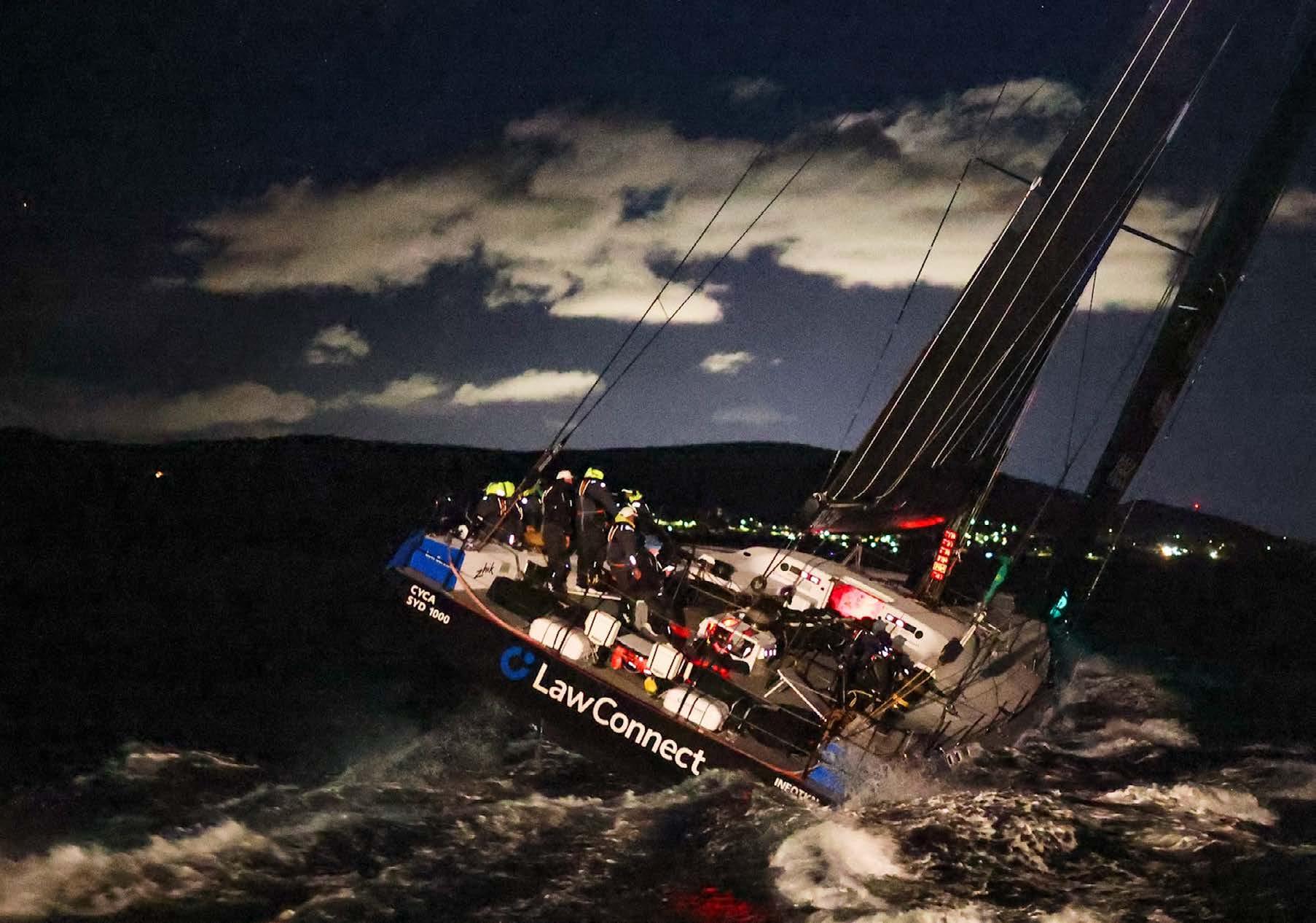
Astrong team performance by the crew was the foundation for LawConnect’s 2024 Rolex Sydney Hobart Yacht Race line honours – her second consecutive win.
The 100-footer crossed the finish line in the gruelling 628nm race after one day, 13 hours, 35 minutes and 13 seconds – more than four hours outside the race record set by LDV Comanche in 2017.
It was LawConnect’s third line honours and her second in as many races, following last year’s dramatic finish against rival Andoo Comanche (now Master Lock Comanche).
Kiwi sailing master Tony Mutter said there was only one change in Christian Beck’s crew from last year’s race.
“Crew continuity is a big help for us, especially if you know how everyone’s going to react in a situation, that makes a massive difference.”
It came to the fore on the first night, which he said was the toughest part of the race, “executing five gybes in 35 to 40 knots winds”.
“For us, 35 to 40 knots is about the upper end where we’re pushing it, but right on the limit,” he said of the race hosted by the Cruising Yacht Club of Australia.
“So, we had to execute those five manoeuvres in a really good way – and we did.
“Much more than that [speed] we’re in a different mode, where we’re probably reducing sail a lot more and slowing the
boat down, whereas in the 35 to 40 range, we’re right on the upper limit on what we can do on that boat.”
Mutter said the race was one of the tougher ones he had sailed.
“There were challenging conditions, probably the roughest race I’ve done out of the 11 that I’ve done. But we came through okay, we didn’t break too much stuff, and people are okay, just got a few bumps and bruises.
“I have done much tougher races though – around the world.”
He said as forecast; it was a wild ride out of Sydney.
“All the way to Green Cape and a little bit beyond for us.
“There were big waves, there’s always a lot of counter currents down there, which change the direction of the waves. You’ve got to keep on your toes, and then afterwards, once the front rolled through, we obviously had a big push from the west, which added another challenge, where we
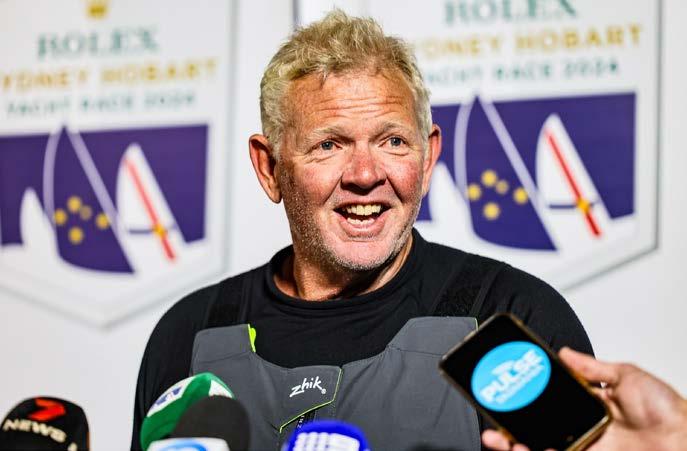
had to basically slow down for about four or five hours.”
Asked about the withdrawal of rival, Master Lock Comanche, Mutter said they knew “something was up”.
“I could see them when we both gybed pretty much at a similar time. So, we knew that we were closing without actually having any data on that.
“I figured they had some issue. But, I mean, it’s not easy to gybe one of these 100-footers.
“We had to do it five times. Luckily, we came through okay.”
Mutter said LawConnect wasn’t without its own mishaps.
“As you saw when we went out of the Heads, led out of there, we then made a rookie error with trying to unfurl the wrong side of the sail, which created a problem. But the rest of it after that, we had to re-evaluate, rethink, just think ahead and just double check everything, and go from there. And after that it went pretty well.”
He never felt that slip which let Comanche take the lead out of the Heads was going to cost them the race.
“They were going to come past us anyway,” Mutter said. “They’re way faster, probably going 3 or 4 knots faster in those conditions.
“So, we were just like waiting for the nighttime where we could use our skill, close in and try and be close to them for the remainder of the race.”


After almost paying the ultimate price on his first attempt at the Vendée, Conrad Colman has done it again. He shares his story.
When I crossed the finish line of the Vendée Globe, 85 days after setting off, I felt an overwhelming mix of exhaustion, relief, and absolute elation. This race isn’t just about endurance; it’s about survival, strategy, and a deep understanding of the ocean’s moods.

Looking back, I’m incredibly proud –not just because I finished, but because I finished strong, with my boat intact, my body still functioning, and my mind already racing ahead to what’s next.
The context of my race makes the result even more special. I was sailing a boat that was over 15 years old, launched in 2007, and my title sponsor came on board just two months before the start.
That’s an incredibly tight turnaround for a campaign of this magnitude. And yet, I finished just 13 and a half minutes behind Jean Le Cam – a legend of the sport – with the closest finish in the history of the race. That margin, after more than 24,000 nautical miles, speaks to how hard-fought every moment was.
The Vendée Globe is a test of resilience from the very first second. My start, in particular, was brutal. Just minutes before the gun, a crucial rope became tangled around my propeller, leaving me immobilised while the rest of the fleet sailed away. The rule is clear: at four minutes to go, a boat must be in race configuration, meaning solo. Instead, I was dead in the water, listening to the countdown over the radio, helpless.
It was devastating.
Years of preparation, every detail checked and double-checked – and then, a twist of fate. To make things worse, there was a live TV helicopter hovering above, broadcasting my misfortune to the world! But I had no choice. I had to reset, follow the protocol for a delayed start, and get back in the game.
By the time I finally got moving, I was an hour behind the fleet. Yet, in a moment of poetic justice, the wind filled in just for me, and I found myself sailing into the lead. From dead last to first in a matter of hours – it was a lesson in how unpredictable ocean racing can be.
Of course, the Vendée Globe isn’t a race you can expect to go smoothly. Three weeks in, just as I was gaining momentum, disaster struck again. One of my solar charge controllers malfunctioned, sending a massive electrical surge through my entire system. The result? A complete power blackout.
Losing power in the middle of the South Atlantic is catastrophic. My autopilot failed, my swing keel system burned out, and even my primary satellite communications were fried. In

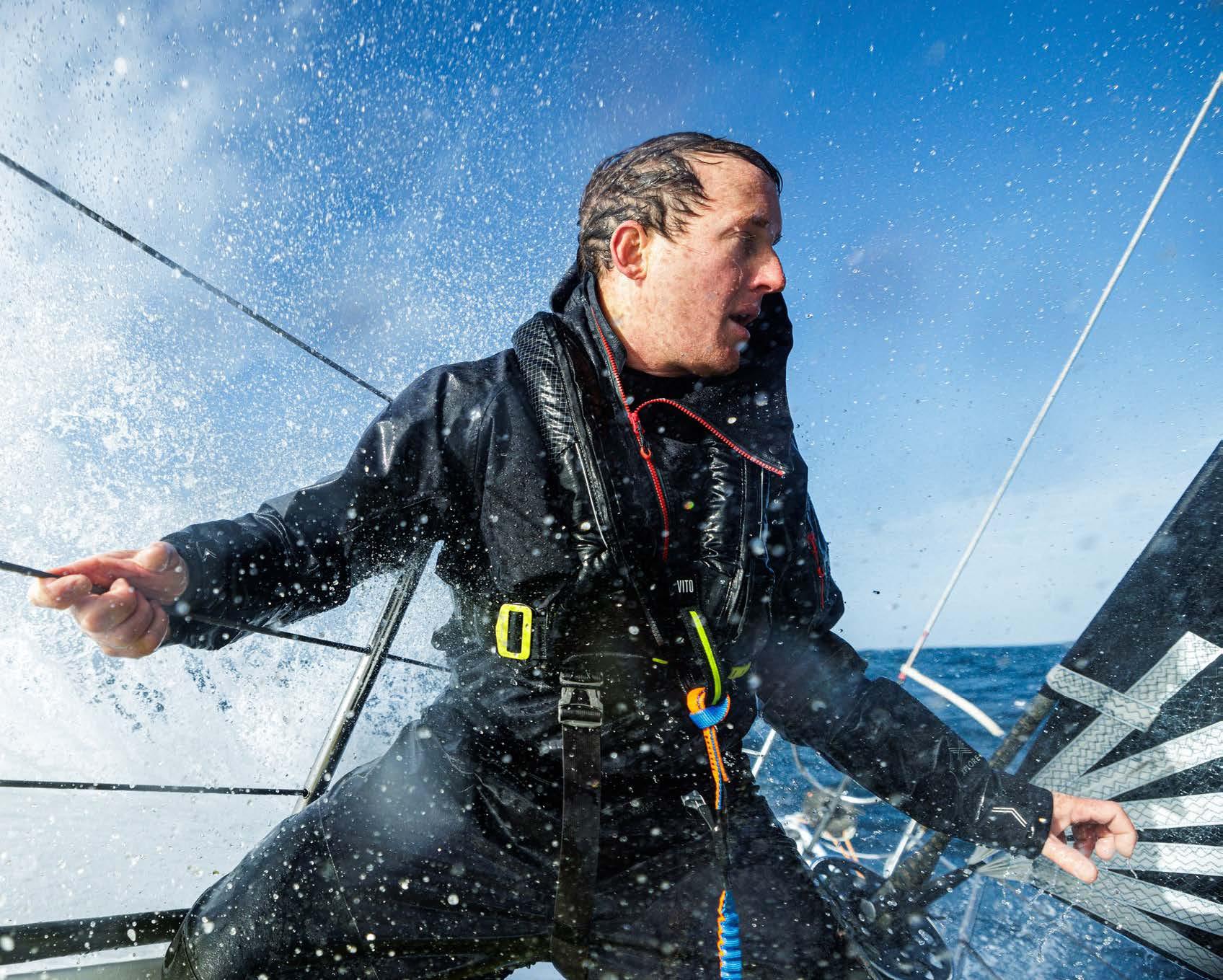
an instant, I was left effectively blind, steering by hand in a situation where even the smallest mistake could be fatal
The solution was painstaking. With the help of engineers onshore, I had to perform makeshift repairs, cutting out fried components with tiny shears – what I can only describe as brain surgery on the back of a bucking horse.
It took days to restore functionality, and by then, I had lost precious miles. The ripple effect of that one incident shaped my entire race, forcing me into a long, strategic comeback rather than a head-to-head battle with the front pack.
As if the technical challenges weren’t enough, the physical toll of the race also caught up with me. At some point, likely during my marathon of electrical repairs, I developed what doctors later called “compartment syndrome” in my knee. Constantly kneeling on a hard carbon fibre deck, in conditions where the boat was slamming through waves, took its toll. Before I knew it, my knee was swollen and painful to move. Antibiotics helped prevent infection, but the damage was done. For a stretch of the race, I had to shuffle around the boat rather than move normally – far from ideal when
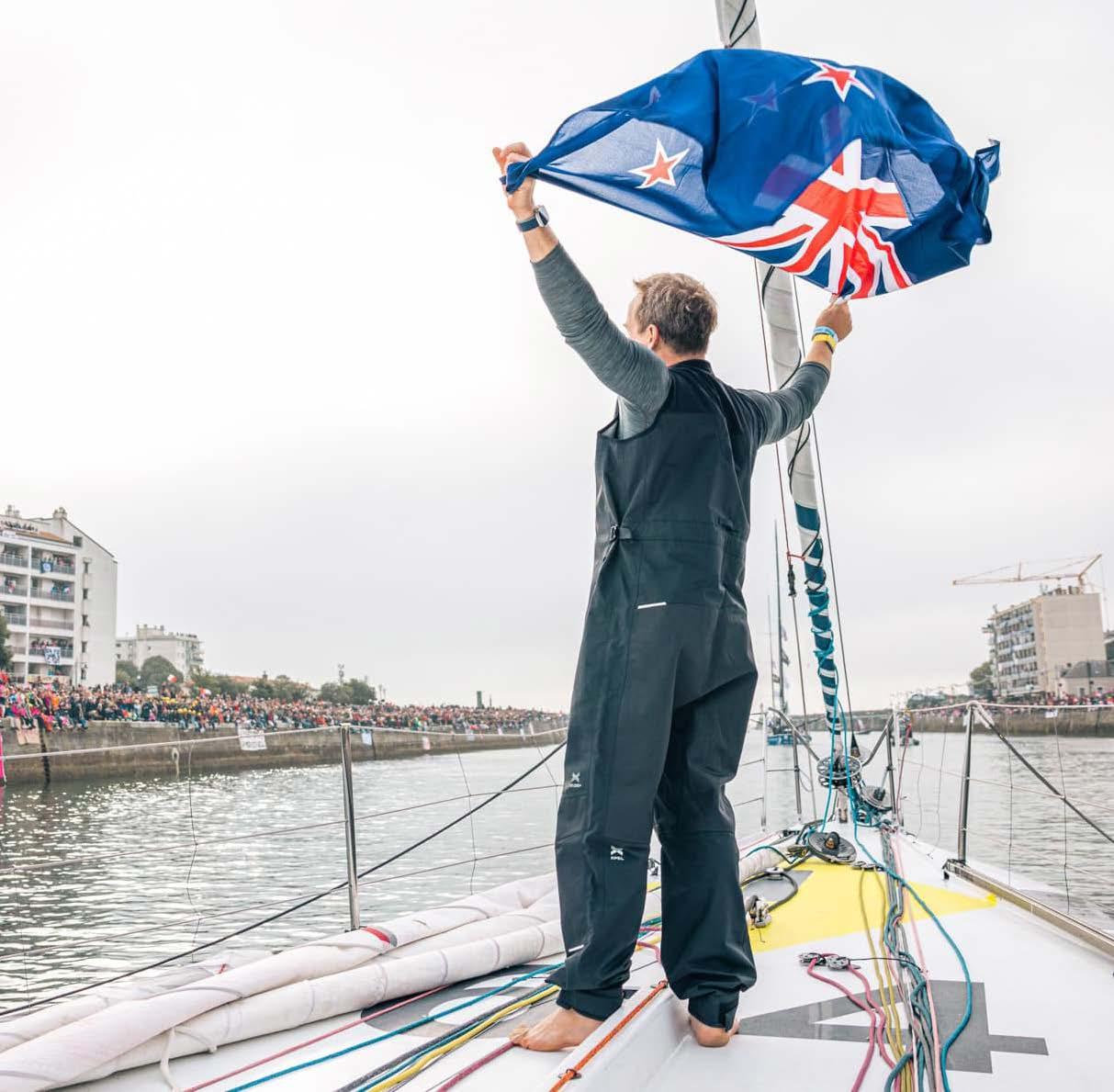
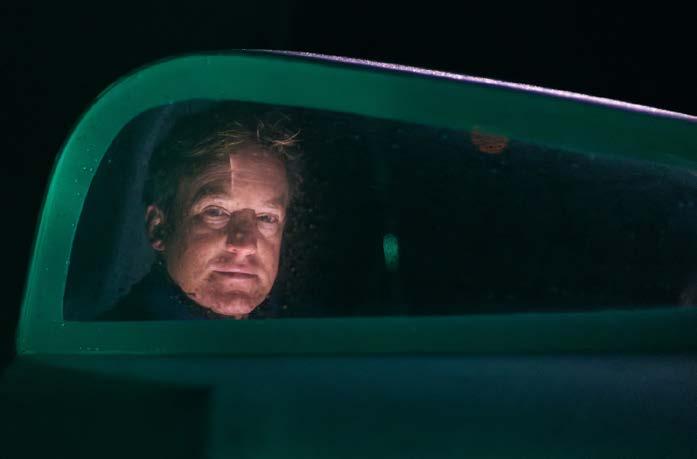
every second counts.
Despite all the setbacks, I never lost sight of the finish line. There were incredible highs along the way –moments when I was completely in awe of the raw beauty of the Southern Ocean, surrounded by albatross and waves the size of buildings. There were also moments of pure adrenaline, like when I found myself face to face with an iceberg, a stark reminder of how alone we truly are in this race.
And then, after nearly three months at sea, I crossed the line. Seeing my family, feeling the energy of thousands gathered at the finish – it was indescribable. But the Vendée Globe was never going to be the end. Now, my sights are set on something even bigger: bringing a Kiwi
team back into The Ocean Race. Growing up in Auckland, I watched the boats flying past and dreamed of sailing on the world stage. Now, I want to create that opportunity for the next generation of New Zealand sailors woth Aotearoa Ocean Racing.
New Zealand has a deep connection to the sea, but offshore racing has become financially and logistically out of reach for many.
My goal is to assemble a team that is proudly Kiwi, backed by local companies, and committed to showcasing our country’s sailing heritage. The budget might not be as astronomical as some of our competitors, but our spirit and determination will more than make up for it.
The time is now. New Zealand belongs in this race, and I’m ready to lead the charge.
Conrad Colman has completed two Vendée Globe races, both without using fossil fuels. He is also the founder of Aotearoa Ocean Racing, a new Kiwi team set to compete in The Ocean Race 2027. Click here to learn more about Aotearoa Ocean Racing and to support the team.
The NZ sailing community is mourning the loss of one of its greats.


There wasn’t a boat Matt Mitchell couldn’t race or a challenge he wasn’t up for. And, say those closest to the America’s Cup star and grassroots sailing champion, no one was spared his good-hearted quips.
Tributes have been pouring in for Mitchell, who died in Auckland in March after a brave battle with cancer. He was 53. Lifelong friend Craig Satterthwaite said Mitchell will be remembered for his incredible determination.
“Matt and I went to Playcentre, primary school and high school together, and we sailed many boats. But whether we were doing the America’s Cup or racing around the world on a J Class, a 100ft racing yacht, or an Elliott 5.9, he was always the same –the more intense it got, the more focused Matty became. Even in an absolute shit fight, he was laser-focused on doing his job,” Satterthwaite said.
Mitchell was a veteran of six America’s Cup campaigns and a winner with three teams – Team New Zealand, Alinghi, and Oracle Team USA.
“He was just a natural yachtie, and he could do anything on the boat,” Satterthwaite said. “He was a bowman in the America’s Cup, a mid-bow, a top Zephyr sailor, and he won a handful of nationals with us on the 5.9.”
Mitchell’s quick wit and infectious energy were equally impressive as his sailing skills.
“He was just so much fun to be around, and I can’t think of a time when he was seriously pissed off or grumpy,” Satterthwaite said.
“Naturally, we could cause a lot of strife together – in a good way! We had a colossal amount of fun, even in the biggest pressure moments. Matty would still be
taking the piss with his dry comments as we approached the bottom mark with 400 square metres of spinnaker to drop in five seconds!”
Kiwi America’s Cup great Murray Jones agrees.
“I had a huge amount of respect for Matt because he always kept it real. He had a balanced view on things and wasn’t afraid to say it as it was,” Jones said.
“And no one was off-limits when it came to getting told either. But you always knew that if he said something, it was because he was right.”
Jones recalls one moment during a highstakes J Class regatta when a race didn’t go to plan.
“I made a mistake and really screwed it up. Matt usually called me ‘Captain’, but that day he said, ‘C’mon, Jones, we’re better than that!’
“That was just how Matt was. He was super competitive – on the boat and off it – he wanted to win. He had an incredible work ethic, was incredibly fit, and was a natural athlete.”
Respected coach and race official Harold Bennett credits Mitchell with reinvigorating the Zephyr class, one of New Zealand’s oldest and most popular adult dinghy fleets. “He was an inspirational person. He came up through grassroots sailing and hit the big time,” Bennett said. “He touched so many lives, especially in the Zephyrs. He had some very clear ideas about what needed to happen with the boats, and many of those ideas were implemented and remain today. Thanks to him, many highprofile sailors are still sailing the boat.”
Mitchell sold his prized Zephyr, a multiple
national championship winner that he had meticulously refurbished, to Bennett’s daughter and family friend, Carla, shortly before his death.
“Matt put a lot of work into the boat, and he was very particular about who he wanted to sell it to,” Bennett said.
Carla Bennett brought the boat up to Auckland from Picton for the funeral at Royal Akarana Yacht Club, where Mitchell was honoured with a 21-canon salute.
Jones visited Mitchell at his Gulf Harbour home just before Christmas.
“I sat with him, and we had a good chat about all sorts of things,” Jones said.
“Family was super important to him. He stepped back from competitive sailing to spend more time with Andrea and his boys [Sam and Balin].
“Even though his health had deteriorated by Christmas, he still got out on his launch with the boys, and I know he loved it.”
Satterthwaite remembers the last time he and Mitchell sailed together.
“We did a 5.9 regatta in New Plymouth in the middle of last year – four races in a three-to-four-metre westerly swell in the Tasman Sea. Matty was a tough bastard, and he sailed with us even though you could tell he wasn’t a hundy,” Satterthwaite said.
“That’s the thing with Matt. Once you were with him, you were with him for life.
“He loved people, and he loved sailing – right till the end.”

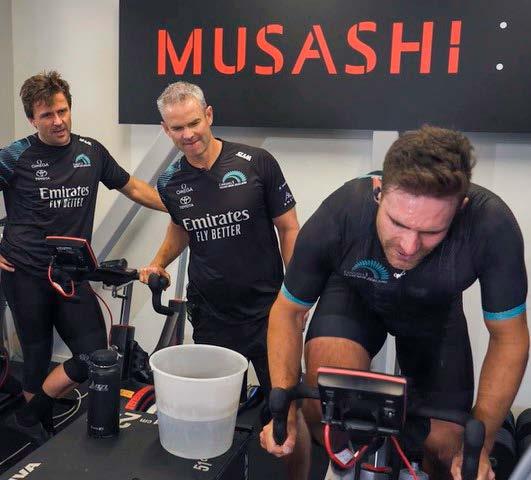

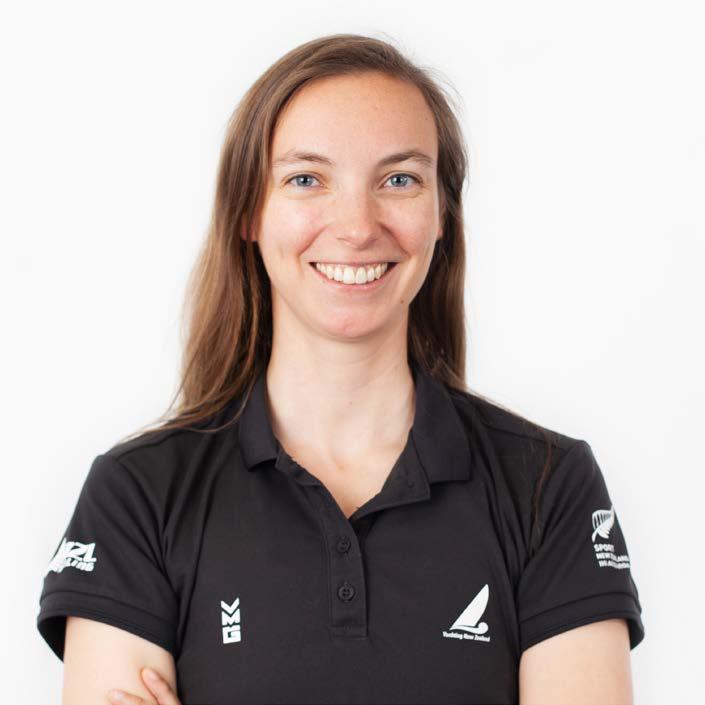

Picking the right sail types can be the difference between winning and losing – whether on a dinghy or a keelboat.
When it comes to sailing, few things are as crucial – or as endlessly debated – as sail selection.
From the rigid rules of onedesign dinghies to the expansive options available to offshore keelboats, a yacht’s sail inventory can mean the difference between glory and mediocrity.
Having spent years racing and finetuning my own sail choices, I’ve come to appreciate just how much strategy and science go into picking the right sail for the right conditions.
Typically, one-design racing dinghies have a very limited sail inventory. Singlehanded dinghies either have a strict onedesign sail or the option to choose between flatter and deeper sail shapes, depending on the skipper’s weight and local conditions.
More open classes, such as skiffs, offer greater flexibility, often carrying
multiple rigs and sail combinations to suit different wind conditions. However, these choices must be made before heading out, as in-race sail changes are generally limited to hoisting a spinnaker or gennaker for downwind legs.
Keelboats and trailer sailers have a far wider range of sail options. Some onedesign keelboats, such as the Young 88s, Farr 1020s, Noelex 22s and 25s, Magic 25s, and Elliott 5.9s, operate under strict class rules that limit sail choice to maintain close competition and keep costs down. These boats may have up to three jib options, allowing crews to adapt to changing wind conditions even while racing. Because these classes often compete in windward-leeward races, they have little need for reaching sails.
Unrestricted keelboats, on the other hand, can carry an extensive inventory of upwind, downwind, and reaching sails. Offshore racing boats may even have different mainsails for inshore and offshore conditions, featuring multiple reef points and heavier construction.
With headsails, the principle is simple: larger sails perform better in light winds, while smaller sails are more effective in stronger conditions. Sail shape plays a very similar role with deeper sails being more effective in light winds, and flatter sails in heavy winds.
Many keelboats carry four or more headsails and are designed for seamless sail changes by briefly setting the new sail before dropping the old one. Cruisers, in contrast, often rely on a single furling headsail, which allows for easy reefing but
sacrifices shape and performance as it is partially furled.
A growing trend in New Zealand’s short-handed racing scene is to limit the number of headsails carried. Frequent sail changes are both time-consuming and physically demanding, so many teams now favour an upwind furling Code Zero for light winds and a reefing all-purpose jib to cover a broad range of conditions.
A heavy-weather jib remains mandatory for safety regulations, though it is rarely used.
The Code Zero, or ‘flying headsail,’ is a fascinating sail type that bridges the gap between headsails and spinnakers.
These sails, flown forward of the forestay on an anti-torsion cable, come in various shapes and sizes, from upwind-oriented designs to reaching sails with higher clews. Their effectiveness depends on the yacht’s rig type – while mastheadrigged boats with overlapping genoas gain little from a Code Zero, modern fractional-rigged yachts with small jibs can see a significant boost in sail area.
Different types of Code Zero sails include masthead zero (MH0) for upwind, fractional zero (FR0) for reaching, and blast reach zero (BR0) for heavy wind reaching.
Handicap systems play a crucial role in sail selection.
In New Zealand, the performance handicap rating factor (PHRF) system assesses a boat’s performance history and sail inventory,


allowing for greater flexibility in sail size. In contrast, the international rating certificate (IRC) rating formula strictly penalises oversized sails, making sail selection a delicate balancing act.
You don’t want to carry large specialised sails with a high rating penalty if they might not even get used in some races.
The mid-girth measurement (the width of the sail at its midpoint) often determines whether a sail is classified as an upwind or downwind sail, influencing how it is rated.
These fall into two main categories: symmetrical spinnakers and asymmetrical gennakers. Symmetrical spinnakers, flown with a spinnaker pole, are optimised for deep downwind sailing, while asymmetric sails are designed for tighter angles.
Within these categories, there are numerous variations including (‘S’ for symmetric and ‘A’ for asymmetric):

S1/A1: A light-airs sail with a flat design and light fabric to fly easily when the boat is sailing higher angles in light winds (masthead).
S2/A2: The largest running sail (masthead).
S3/A3: Heavy reaching sail, flatter design (masthead).
S4/A4: Heavy, full-sized running sail (masthead or fractional).
S5/A5: Fractional reaching sail.
S6/A6: Small, heavy running sail (often called a ‘chicken chute’).
Sailmakers often develop hybrid designs that cover multiple ranges, such as an A1.5, which balances performance across a

variety of conditions. Lightweight fabrics excel in light winds but are more fragile, while heavier materials provide durability in strong conditions.
Staysails add another layer of complexity. These sails fall into two categories: genoa staysails and spinnaker staysails. The former serves as a heavy-weather upwind sail or an inside sail paired with a Code Zero, while the latter is designed for use within a downwind sail plan.
Both types can be either furling or hanked onto an inner forestay.
The art of selecting the right sail inventory is a blend of technical knowledge, practical experience, and adaptability. Whether racing a one-design dinghy with minimal options or managing an extensive offshore inventory, understanding how different sails interact with wind conditions and rating systems is essential to maximising performance on the water.

A new device has been described as a game-changer for sailing. Kathy Catton looks at what the Vakaros craze is all about.
Competitive sailing has always been a delicate balance between instinct and instrumentation. While seasoned sailors can read wind shifts and anticipate weather patterns with remarkable accuracy, the introduction of the Vakaros Atlas 2 instrument has revolutionised how sailors at all levels are approaching the sport. It is quickly becoming the must-have device for everyone from Optimist sailors to Olympic champions.
What makes Vakaros particularly revolutionary is its ability to integrate a wealth of data into
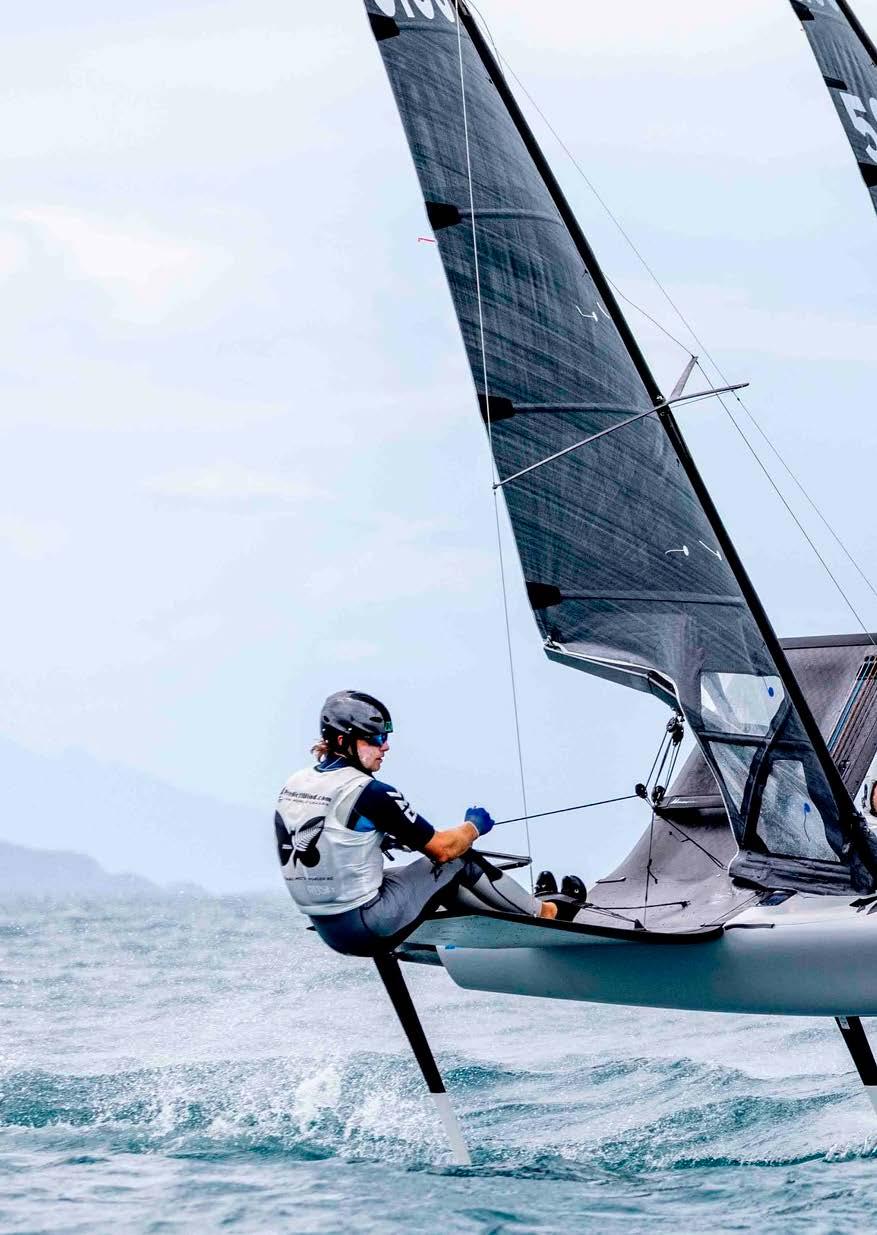
actionable insights. It’s labelled an ‘all-in-one’ instrument, featuring highly precise GPS, a magnetic compass, heel and trim measurement and more. Unlike traditional GPS devices, it also supports wireless links to select wind and water sensors, allowing a lightweight, wire-free experience, or a backup instrument on keelboats.
Yachting New Zealand’s Aon Fast Track sailor and former 49erFX junior world champion
George Lee Rush
embraced this technology in the recent Moth world championships, held in Auckland at the start of this year. Rush was one of several sailors to use the device, with eventual champion Mattias Coutts doing the same.
“They’re pretty foolproof for us,” he said. “The Moths come with a built-in bracket and mount. You literally just put it on, turn it on, and it records the data. At the end of your session, you upload it to the Vakaros app on your phone.”

What sets the Atlas 2 apart is how it transforms raw data into actionable insights. This has proven particularly valuable during training sessions, where sailors can analyse their tacks and gybes, and start sequences with scientific precision.
For competitive sailors, the ability to make evidence-based decisions has been transformative. Rush and his training partners in the 49er class use the Atlas 2 to compare different gear configurations under varying conditions.
“There was one particular day when it started off quite light and then got windier. Seb [Menzies] and I were using a different stiffness of mast, and we could see as the wind built when one piece of kit started becoming stronger than the other,” he said.
“You can recognise that anyway, but being able to put data to it and have some certainty is really interesting. It’s opened up a whole bunch of new opportunities”.
What’s particularly fascinating about the Vakaros system is how the sailing community has embraced and extended its functionality. Norwegian sailor Nicolai Jacobsen has developed an app called Vantage Sailing that works with Vakaros data to provide even more detailed analysis. While still in its betatesting phase, the app is due to hit the market in the coming months.
“You literally just upload your data to your phone from the Vakaros and then download that to a file, which you plug into the Vantage app,” Rush explained. “It gives you all your stats, like your speed and your VMG. It calculates an expected wind angle, analyses your manoeuvres, and it just does it all for you.”
This community aspect extends to training sessions as well. “Before the Moth worlds, when there were 20 boats out sailing, everyone was uploading their data. As long as you’re friends with them, you can compare. It’s pretty awesome.”
While training applications are clear, the use of the Atlas 2 during races depends on class rules. In development classes like the Moth, instruments are permitted, making the Atlas 2’s start line functionality particularly valuable. This feature provides exact distance to the line, meaning sailors have accurate data to improve their pre-start routine.
However, in classes with stricter rules like the 49er, the device can only be used for post-race analysis. “In the 49er, you can’t have it on when you race,” Rush said. “It would actually probably be detrimental to get used to using it and then not have it.”
Some classes have found a middle

ground, with the device offering a locked mode that only displays compass information while still recording data for later analysis.
One of the most significant impacts of the Vakaros Atlas 2 has been making sophisticated performance data accessible to a broader range of sailors. While similar technology has existed in high-end racing boats for some years, the Atlas 2’s intuitive interface means even younger sailors can benefit from the same type of data analysis once reserved for professional campaigns.
The price point, however, remains a consideration. “They’re not super cheap, and it’s quite a big investment to get one,” Rush admits. “It’s quite a big hit to the bank account when you first get it, but I’ve found it really useful. Especially if you have a mate that has one, it can level up your training quite a lot.”
As Vakaros continues to gain popularity, its influence on sailing education and competition is likely to grow. The company’s commitment to regular software updates means the device’s capabilities continue to expand, with new features added based on user feedback.

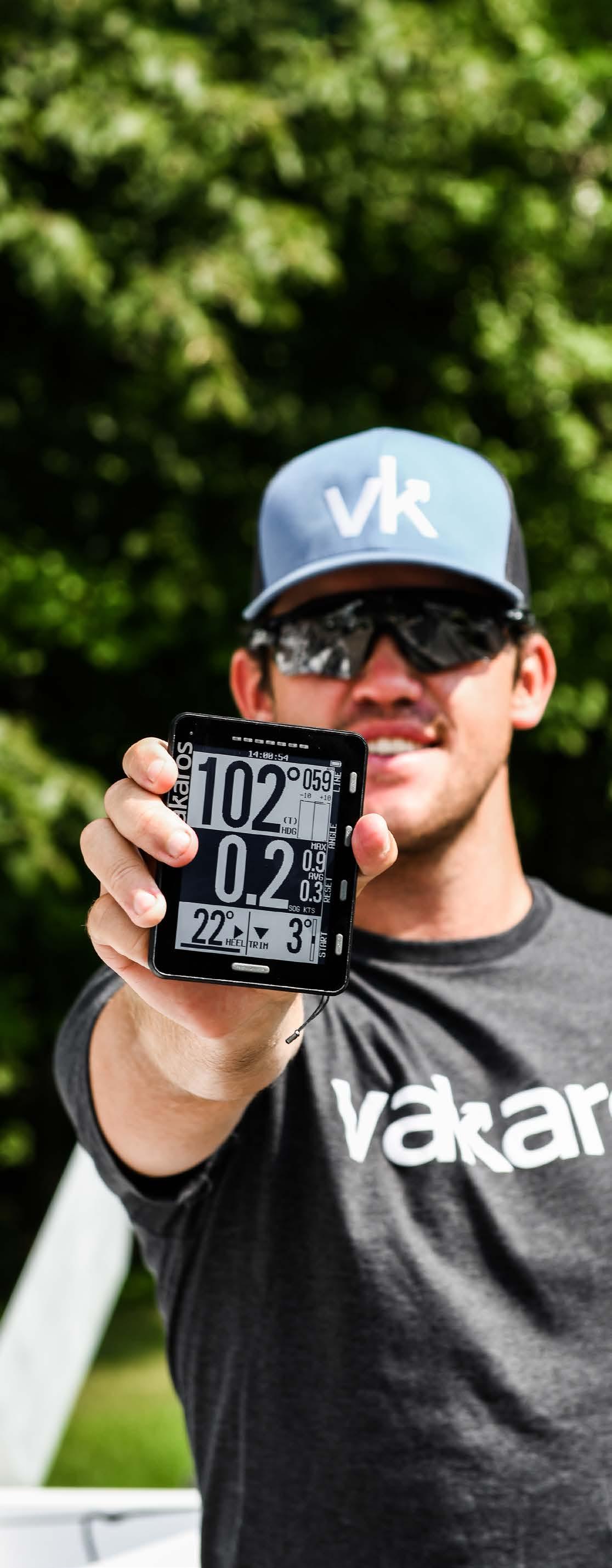



High contrast, sunlight-readable display
Data logging at 10 Hz
Run time: 100+ hours
256 MB integrated storage
Android and iOS compatible
Price: $1679.39
Available at Harken Fosters in Auckland
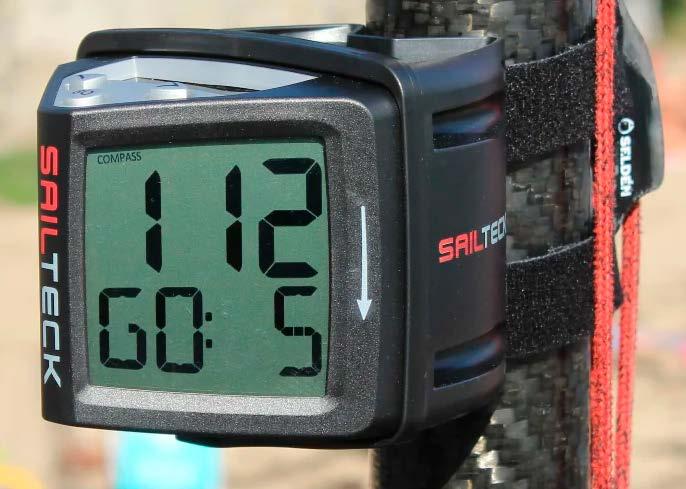
Two-line display that shows countdown and heading
Three-button countdown for easy operation
Class legal since it does not use GPS
Solar powered
Weight: 200g
Price: $695.00
Available at nzsailing.com and Harken Fosters
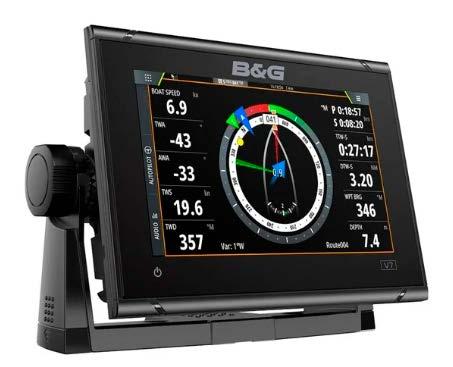
Sailing chart plotter designed for coastal cruising and club racing
7-inch multi-touch screen
Features include B&G’s SailSteer, SailingTime, Laylines & RacePanel
Weight: 1320g
Integrated WiFi
Price: $1179.00
Available at Marine Deals in Auckland

Multisport watch
Less sailing-specific; could also be used for kayaking or skiing
Multiple sensors including GPS, GLONASS, and Galileo
Activity profiles, including sailing and sail racing
Price: $1249.00
Available through many marine and electronics retailers
The 2025 Auckland Boat Show featured 1.3 km of boats on the water, 222 vessels overall, over 500 marine brands, four days of glorious sunshine – and plenty of positive exhibitors.
The 24th edition of the event, held from March 6 to 9 at Auckland’s waterfront, was again the annual launching point for many new releases with strong enquiries reported.
“It’s been a fun show with a great, high energy and we’re feeling a lot of positivity in the industry for the future,” said Nicky Malcon of JP CRAFTS, which
had its brand-new production RIB on display.
“Awesome,” said R Marine’s Craig Torckler. “If I had one word for this show it would be awesome. Great show, great weather, and great people.”
Organiser Stacey Cook is pleased with the show’s performance, reporting repeat exhibitors and plenty of new companies.
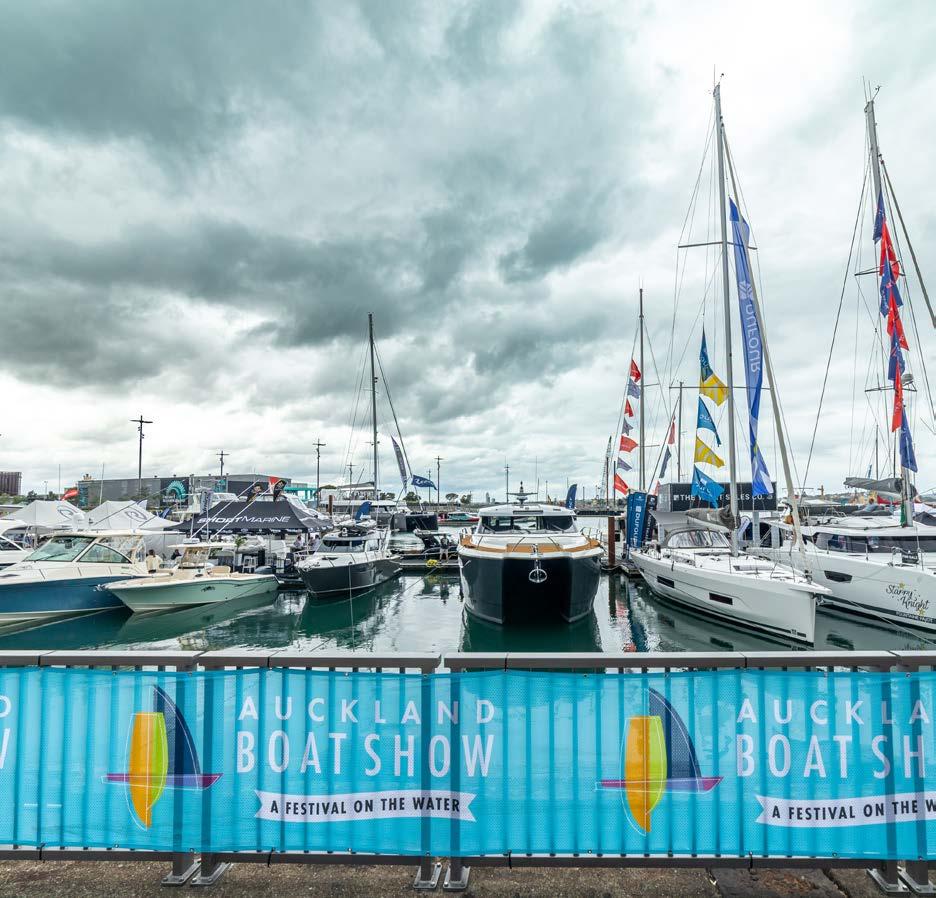
industry launches this year. From clever new tech products like Sea Turner’s tender launching and See-LEVEL’s innovative sea sickness solution, to head-turning boats like Lloyd Stevenson’s Catalyst tender, and the two Sunreef Yachts catamarans on show, we are so pleased with this year’s event,” said Cook.

“The show is fantastic at showcasing new launches and we’ve been thrilled with the quality of the marine
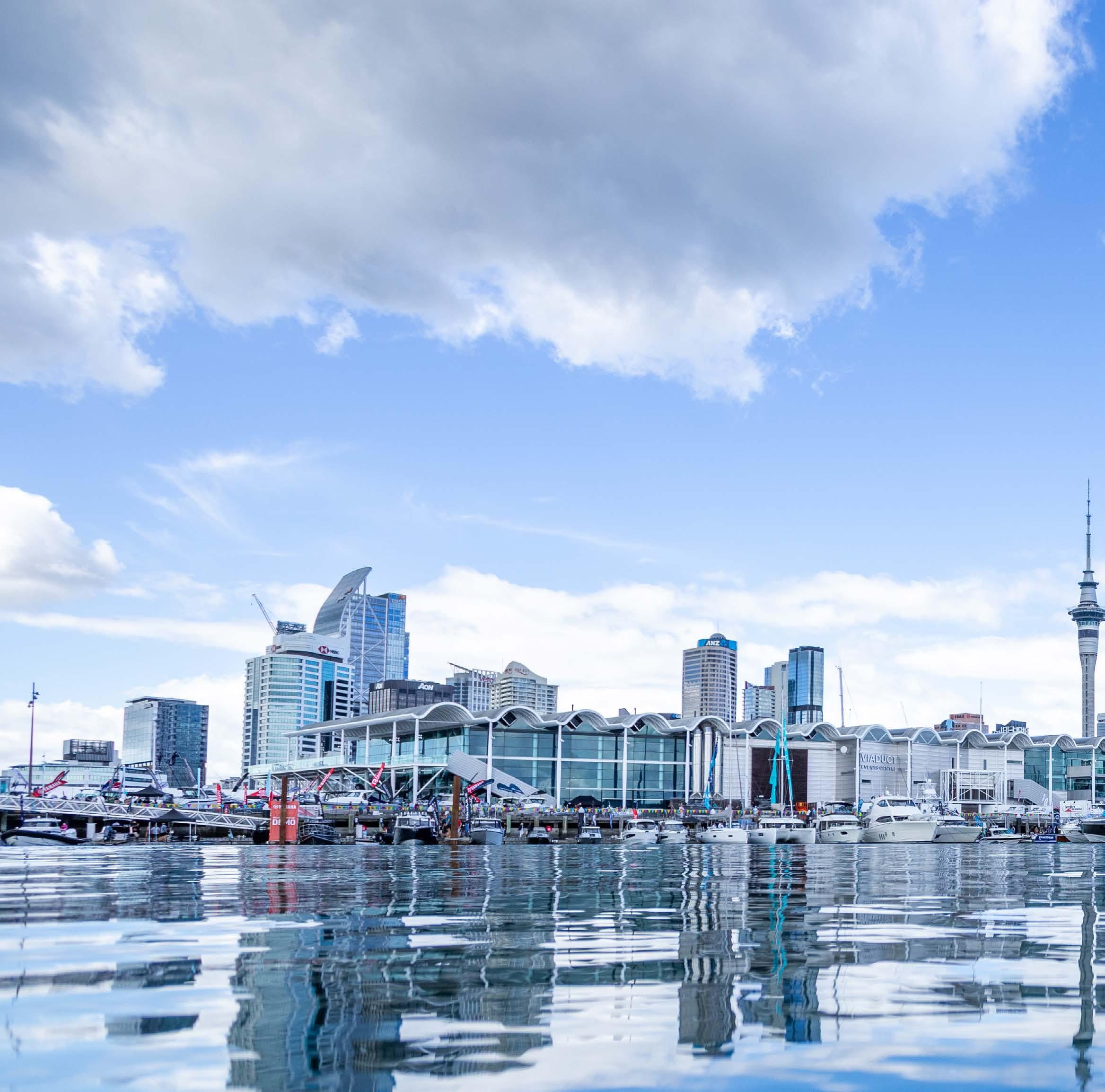
The Auckland Boat Show is designed to showcase marine industry companies on and around the water in central Auckland.
“This has been our first New Zealand

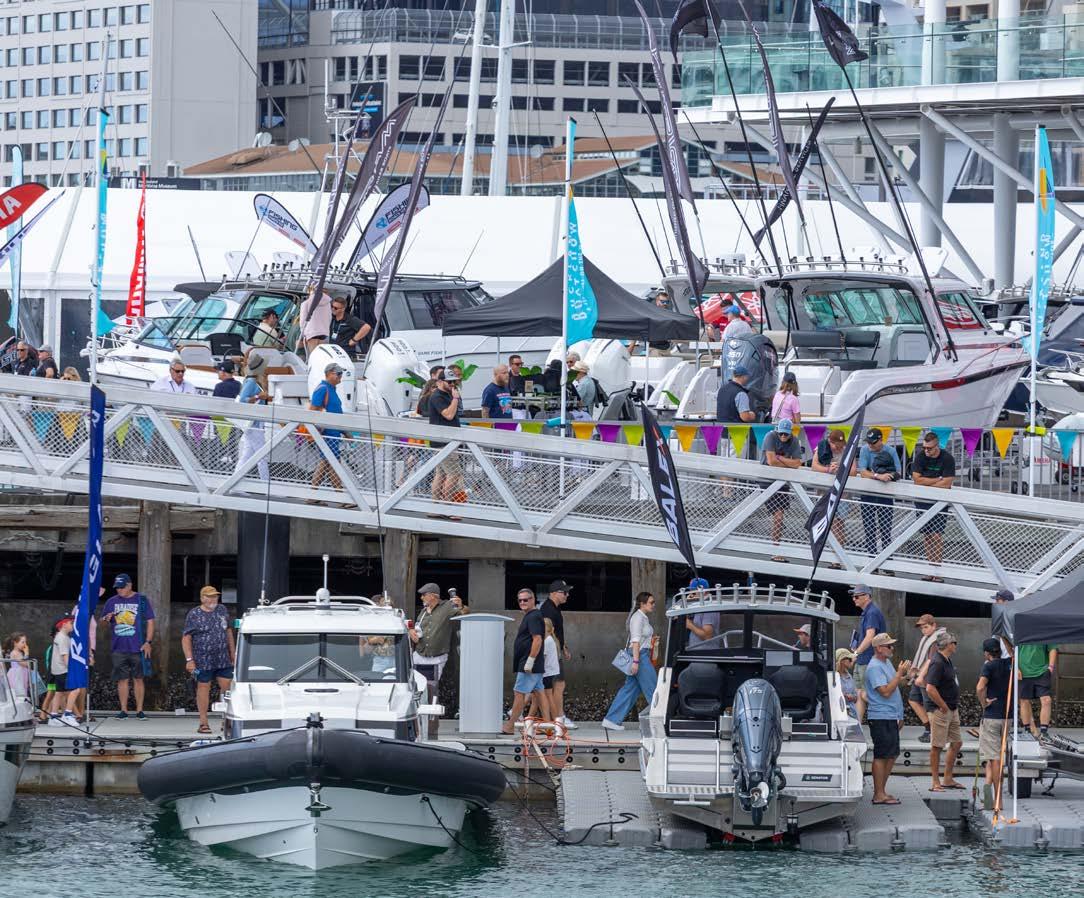
show, and we’ve been thrilled with the reception we’ve had here, and visitors’ response to the brands we represent,” said Short Marine’s Lauren Thomas.
“In our industry, we are collaborating and pushing each other forward,” said Tracey Stevenson, president of the NZ Marine Industry Association at an exhibitor function on the second day of the event.
“It’s been a challenging time for business but looking around the show we can see the resilience

of the New Zealand marine industry in innovating and meeting these challenges.”
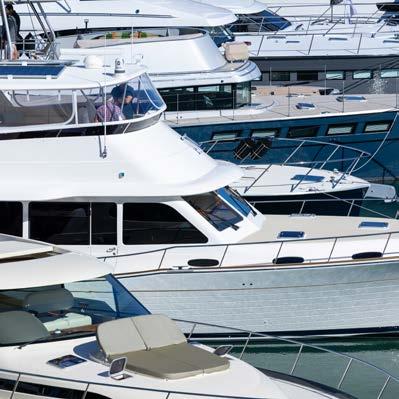
At the same exhibitor function, Auckland mayor Wayne Brown echoed Stevenson’s thoughts, welcoming the more than 200 businesses and organisations on site.
“It’s great to be here for the 2025 Auckland Boat Show. In New Zealand, we design, build, store, sell and service recreational and commercial vessels, and it’s great to be here for the 24th edition of the

show. It’s a moderately tricky market at the moment, but everyone here has been positive and friendly.”
The show is held in central Auckland and attracts brokers and marine companies from New Zealand, Australia and further afield.
“The people who have been coming through the door have come with targeted enquiries, and plenty of quality buyers coming through,” Cook said.
“We’re a marine nation and it makes sense that we lead the world in creating better ways to be safer, faster, and more sustainable on the water.”
Robotic buoys have taken the sailing world by storm –and they’re now also leaving a mark on our waters.
MarkSetBot, the awardwinning robotic buoy technology revolutionising sailing events worldwide, has now made its mark in New Zealand, featuring in two major recent domestic events.
With widespread adoption across 40 countries, these autonomous race marks have gained a strong following among elite sailing organisations and have already been used by figures such as Kiwi great Sir Russell Coutts and PredictWind, the global leader in marine forecasting.
PredictWind integrated its four
branded MarkSetBots as part of its title sponsorship of the FOIL Bay of Islands in February and the wingfoil national championships at Wakatere Boating Club in March.
The bots provided precise and flexible course management, enhancing efficiency and sustainability at both events. These events marked the first significant use of MarkSetBot technology
in New Zealand, following its success in major international sailing competitions such as the 52 Super Series, the World Match Racing Tour, and SailGP.
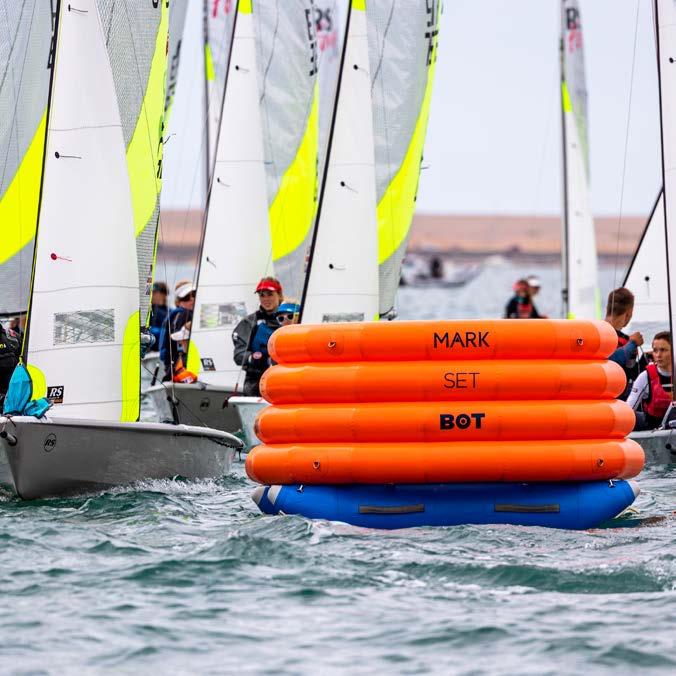
Founded in the US by the Morin family – Kevin, Michael, Matthew, and Marcie – MarkSetBot has quickly become the gold standard in racecourse management. The company’s self-propelled, GPS-enabled buoys eliminate the need for anchor lines, making course setup and adjustments faster and easier while reducing environmental impact.


Since its launch in 2018, MarkSetBot has undergone five major product iterations and over 400 upgrades.
Designed to withstand extreme conditions – including winds up to 30 knots and swells of 5-6 metres – the bots have been tested in high-stakes events such as the Pan American Games. Their patented submerged motor, positioned three feet below the surface, maximises stability and holding power.
“A key advantage of MarkSetBot is its user-friendly mobile app, which allows race officers to set, adjust, and reposition marks in real time. This has significantly reduced reliance on support boats and volunteer race committees, making regattas more efficient and accessible,” said sales and marketing director Michael Morin.
“Beyond performance, MarkSetBot’s environmental benefits have also driven its global adoption. Traditional anchored buoys require fuel-consuming boats and can damage sensitive seabeds. MarkSetBot eliminates these issues, offering a cleaner and more sustainable alternative.”
A study by Earth to Ocean confirmed that MarkSetBot has no direct carbon emissions and significantly reduces seabed disturbance. The technology has also received four consecutive Clean Regatta certifications from Sailors for the Sea and was a finalist for World Sailing’s 11th Hour Racing Sustainability Award in 2020, highlighting its
contribution to eco-friendly race management.
MarkSetBot has been endorsed by some of the biggest names in sailing, including Coutts, CEO and co-founder of SailGP and a five-time America’s Cup winner. The technology has also been embraced by major sailing circuits such as the 52 Super Series, the RC44 Cup, ClubSwan, and the SuperYacht Racing Association.
Top race officials, including Maria Torrijo (principal race officer for the 52 Super Series and ClubSwan) and Davide Casetti (president of RS21 race class Italy), have praised the product’s ability to simplify and improve regatta management.
Investor Stephen Polk, CEO of Offshore Spars, has long supported the Morin family’s vision.
“I have known the Morin family for many years and have spent time with them both in the boardroom and on the racecourse. Having spent much of my career in a family business, I can relate to their journey and we are excited to be part of the MarkSetBot story.”
In addition to its success in sailing, MarkSetBot is exploring new applications. The company has expanded into golf with GolfShotBot, an eco-friendly pop-up target paired with biodegradable golf balls.

The introduction of MarkSetBot into sailing events has been a gamechanger, particularly for foiling classes that demand highly adaptable course layouts.
A new adopter of this technology in New Zealand has been PredictWind, the leading provider of advanced weather forecasting for sailors worldwide.
PredictWind’s director, Jon Bilger, recognised the potential of MarkSetBot to transform regatta management, particularly for foiling classes, which require more frequent course adjustments than traditional fleets.
“At multiclass regattas, foiling fleets often don’t get the attention they need when it comes to course setup,” said Bilger. “With MarkSetBot, clubs can seamlessly cater to these high-speed classes without adding extra burden on human resources and mark boat personnel.”
Beyond enhancing course management, PredictWind has also leveraged MarkSetBot as a means of giving back to the sailing community. By providing the robotic buoys to clubs and events, PredictWind has supported regattas in a unique sponsorship capacity, helping to modernise race management while reducing operational costs.
The recent wingfoil national championships at Wakatere Boating Club was one of the events that utilised the PredictWind MarkSetBots, with the marks adding to the list of environmental initiatives in the Clean Regatta platform.

“It’s a win-win,” Bilger explained. “Clubs can run better regattas with fewer volunteers, and foiling sailors get courses that suit their needs, all while we continue to support the sport at the grassroots level.”
New Zealand’s marine conservation efforts have received a technological boost with the launch of a new app supporting Moanamana, Yachting New Zealand’s nationwide initiative empowering students to monitor and restore aquatic ecosystems.
The app, developed by sovereign cloud provider TEAM Cloud, ensures secure local hosting of environmental data, enhancing the programme’s research capabilities.
Moanamana is a key component of Yachting New Zealand’s RŪNĀ school engagement programme, fostering student involvement in marine conservation through partnerships with the University of Otago’s NZ Marine Studies Centre, the Coastal People Southern Skies Centre for Research Excellence, New Zealand’s SailGP team the Black Foils, and the Live Ocean Foundation. The app provides students with advanced tools to collect and analyse data on ocean health, strengthening their role as future environmental leaders.
Yachting New Zealand’s national sport development director Raynor Haagh highlighted Moanamana’s impact.
“For nearly two decades, the ‘Have A Go’ schools programme gave thousands of young Kiwis the chance to experience
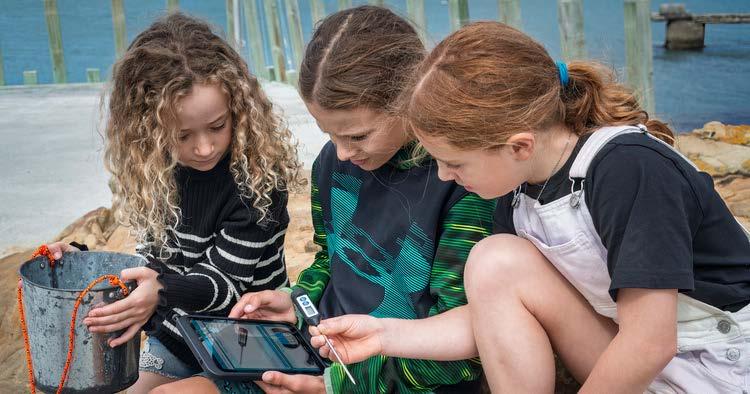
sailing, inspired by Sir Peter Blake’s vision,” Haagh said.
“With RŪNĀ, we’re expanding that legacy, reaching a broader and more diverse group of students to connect them with the marine environment. Moanamana is an exciting next step in that journey, using school-club-community partnerships to restore aquatic ecosystems and enhance the mana of Moana.”
The first major milestone for Moanamana came with the launch of the NZL Blue Belt initiative, which Yachting New Zealand is spearheading. The first NZL Blue Belt site was established at the Worser Bay Boating Club in Wellington, where local students have created a series of

innovative conservation projects, including a penguin hotel, an underwater art gallery snorkel trail, and a kelp forest restoration initiative. These hands-on projects help students build a direct connection to their marine environments while making tangible contributions to ecological restoration.
Leading Kiwi sailors Erica Dawson and Peter Burling have endorsed Moanamana, stressing the urgent need to protect New Zealand’s marine environment. With backing from multiple government and sporting bodies, the initiative continues to expand, inspiring young New Zealanders to take an active role in ocean conservation.
Yachting New Zealand has been steadily rolling out its new Moanamana module, starting with a hui at Nelson Yacht Club late last year.
The club has since acquired new kit equipment and held its first Moanamana experience this term with Nelson Intermediate School.
“Moanamana is all about engaging students in hands-on environmental education, connecting them with the marine environment and local conservation efforts,” said Yachting New Zealand education lead Alisa Torgersen.
The RŪNĀ website has also been refreshed with new online learning experiences for students. These take learners on a journey from assessing their prior knowledge to collecting data through citizen science activities at clubs. The programme then encourages students to report their findings and act in their communities.
“We’re also working closely with other environmental organisations across Aotearoa New Zealand, ensuring students gain real-world insight into marine conservation,” Torgersen added.
“A special thanks to Sally Carson from the Marine Studies Centre and Coastal People Southern Skies for her guidance in this space.”
In February, Torgersen and Carson led a Moanamana hui at Naval Point Club Lyttelton, where teachers and community members learned how to collect and analyse data, gaining the confidence to deliver lessons to students.
Upcoming Moanamana hui will be held at Tauranga Yacht and Powerboat Club on May 7 and at Bucklands Beach Yacht Club on May 8. The assembly of

The integration of scientific tools into the Moanamana programme further strengthens the educational experience for students. Tools such as Marine Metre Squared surveys, underwater transect surveys, and plankton surveys allow students to collect real-world data on marine biodiversity. In collaboration with the University of Otago’s NZ Marine Studies Centre and the Coastal People Southern Skies Centre for Research Excellence, students gain a comprehensive understanding of marine science and ecological restoration.
Dr Sally Carson, director at the New Zealand Marine Studies Centre, highlighted the significance of these experiences: “The
Moanamana kits is currently underway. Looking ahead, the programme aims to roll out the recently launched Moanamana app and expand it to four additional clubs starting the programme. Data collection from participating clubs will begin in April and May, followed by club conferences and RŪNĀ planning sessions. Other key initiatives include monthly RŪNĀ introduction Zooms, further development of Kōkōkaha and Kōrinorino learning experiences, and the establishment of more RŪNĀ clubs across the country.
For more information, click here

strength of this programme is providing students with the opportunity to investigate place-based questions of local significance. They learn how to use scientific equipment, collect and analyse ‘real’ data, and how to be environmental citizens.”
The Moanamana app will provide students across New Zealand with the technology needed to capture and analyse data on ocean health. By integrating the app with the Moanamana initiative, the programme offers a unique educational experience that leverages cutting-edge technology, marine conservation, and community involvement to foster a generation of environmental stewards.
The data collected is not only used for educational purposes but also contributes to national and international research on ocean health. By collecting and sharing data, students are actively involved in a global effort to understand and protect marine ecosystems.
As a sovereign cloud provider, TEAM Cloud ensures that all data remains securely hosted within New Zealand, providing a reliable and privacy-compliant platform for environmental data collection and analysis.

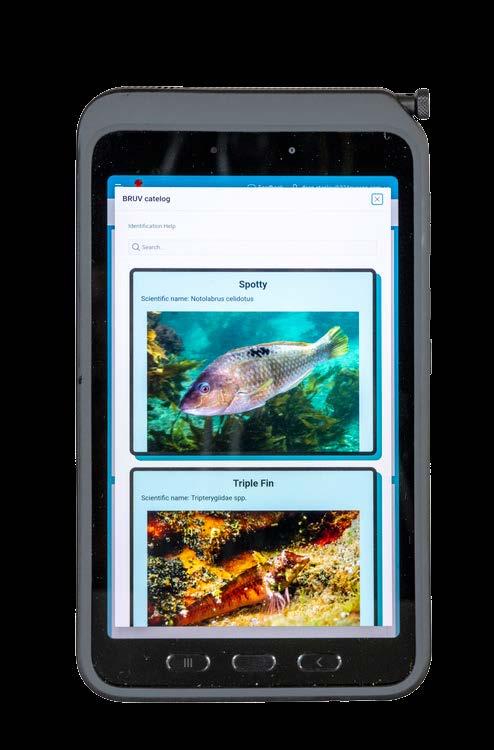
The Moanamana initiative is made possible by several key partnerships. It has received support from the Ministry of Business, Innovation and Employment’s Unlocking Curious Minds fund, as well as the Ministry of Education’s Enriching Local Curriculum fund. Additionally, Sport NZ’s ‘In Our Backyard’ programme has been instrumental in the development of the programme.
Burling, driver of the Black Foils and co-founder of the Live Ocean Foundation, stressed the urgency of taking action to protect New Zealand’s marine environments.
“The ocean is critical to our planet’s life support system, providing 50 per cent of our oxygen and absorbing 90 per cent of excess heat. But it is under threat. Aotearoa has a special role as guardians of one of the world’s most significant ocean spaces. As New Zealanders, we must act now.”

VMG Clothing is the manufacturer of elegant, highperformance crew wear for the superyacht and marine industry and also the proud clothing partner for Yachting New Zealand. Now, for the first time, club members can access the exclusive VMG range of NZL Sailing -branded gear via our website.
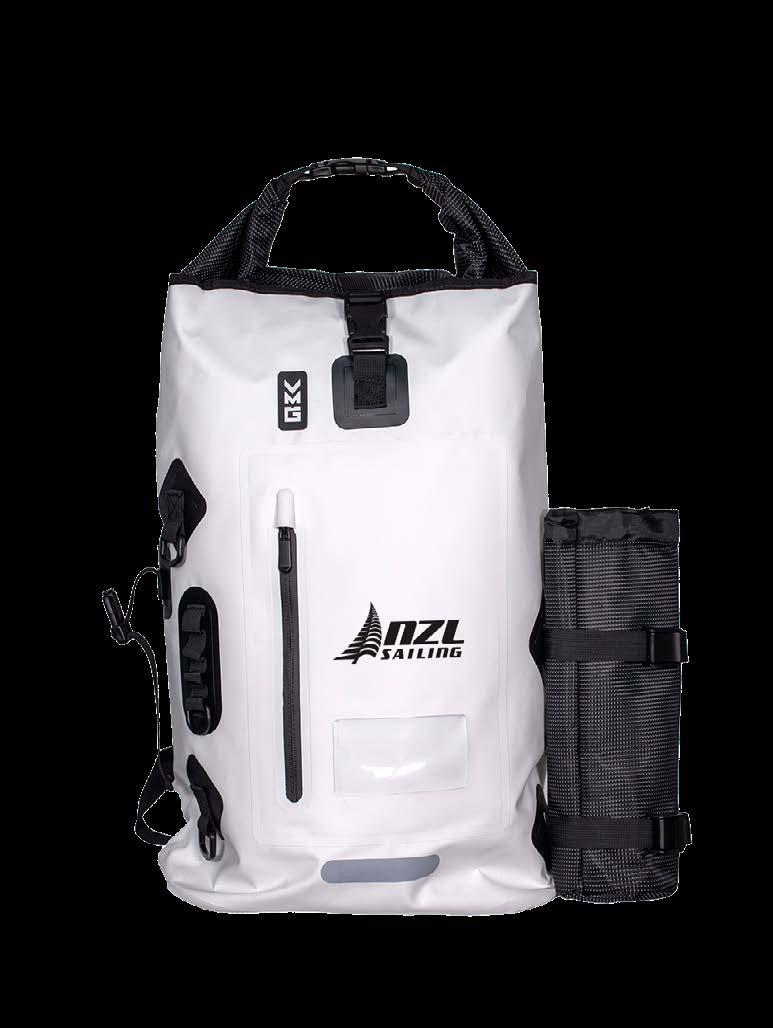

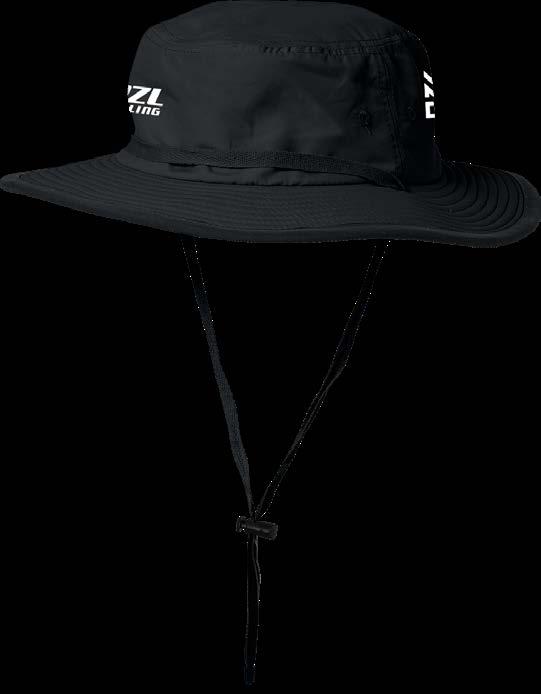




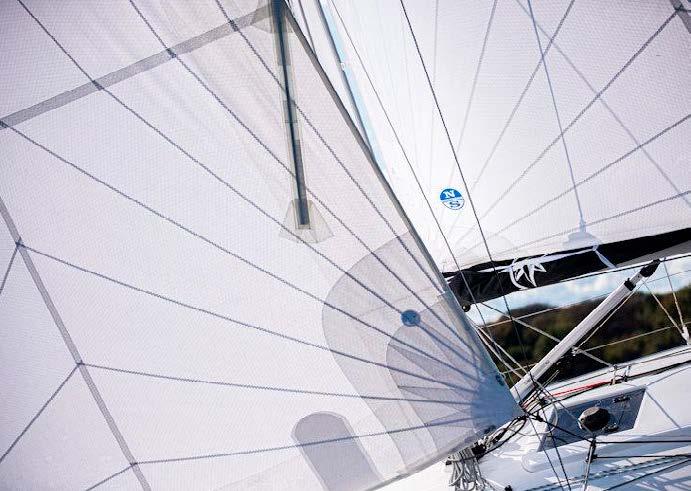
Chatham Backpack $145
Unisex (white)
25L volume waterproof backpack with adjustable straps, safety clasp and front zipper.
Chatham Gear Bag $169
Unisex (white)
65L volume waterproof gear bag with adjustable straps, safety clasp and front zipper.
Coaches Tech Jacket $395
Unisex (black)
Tested to withstand 40,000+mm of water over 24 hours with double seam-seal adjustable hood.
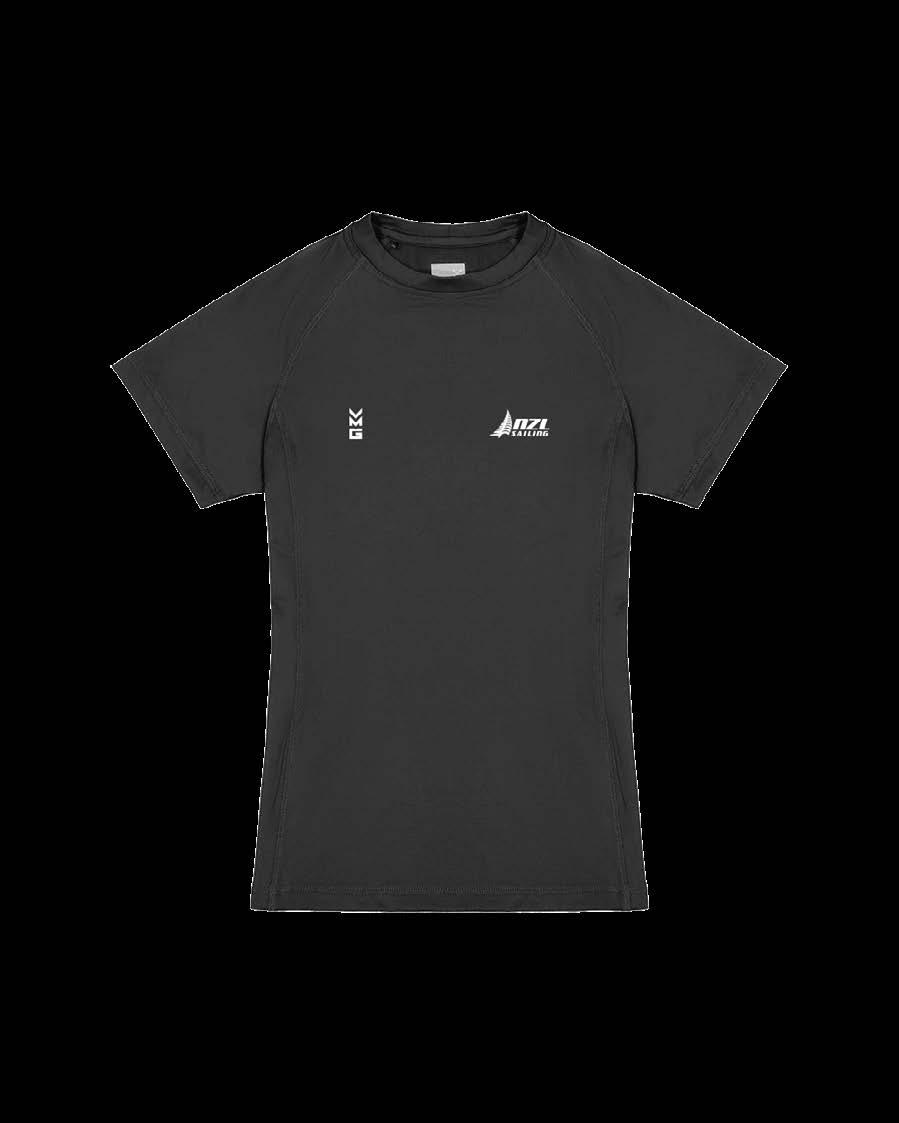

Tekapo Polo $85
Men’s and women’s (black/titanium)
Slim fit with moisture wicking and selffabric engineered collar with three-button placket. Recycled plastic fabric.
Moana SS Tee $76
Men’s and women’s (charcoal/white)
Lightweight, stretchy and breathable made from recycled plastic. Protects you from the sun and acts as a moisture-wicking layer.
Sandspit Hat $58
Unisex (black/white)
Wide brim sun hat with regular fit. Adjustable cord and sweatband lining.
Hauraki Shorts $133
Men’s (charcoal)
Quick-drying performance garment with stretch, made from recycled plastic, water-repellent fabric, adjustable waist and side cargo pocket.
8 Ozone Cap $26
Unisex (black/white)
Regular OSFA fit with crown peak cap, black Velcro strap and clip cord.
To view the full range and to make a purchase, click here
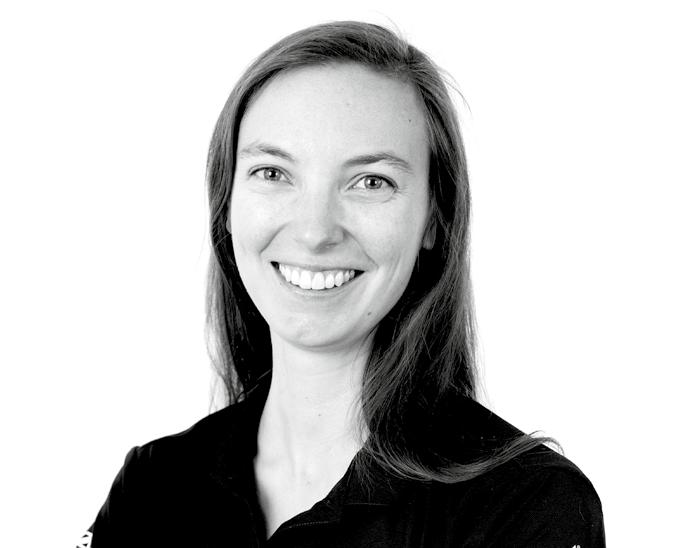
Nutrition should be an essential part of preparation, just like ensuring gear is ready or arriving on time.
Earlier this year, I had the privilege of attending the Core Knowledge programme at AUT Millennium, focusing on energy systems and athlete nutrition. This initiative aims to provide critical education to coaches, with the goal of embedding it permanently into our development calendar. Yachting New Zealand has since adopted learnings from this into its own programme tailored for sailing.
With 20 coaches taking part this year, we are already seeing the impact it can have on both our knowledge and our athletes’ performance.
One of the biggest takeaways from the workshop was understanding energy availability – how an athlete’s training load, recovery, and nutrition interplay to affect overall performance. We delved into the risks of low energy availability (LEA) and its more severe consequence, relative energy deficiency in sport (RED-S).
The signs are clear but often overlooked: persistent fatigue, gut issues, declining performance, and even mental health struggles.
In female athletes, missing periods can be a warning sign, but these issues are not exclusive to women – any athlete, regardless of gender, can suffer the consequences. Left unchecked, RED-S can lead to long-term health issues such as impaired metabolism, lower bone density, and infertility.
As coaches, we are in a unique position to
spot these warning signs early and address them before they escalate.
But first, we need to educate ourselves.
A fantastic resource for coaches on female athlete health is provided by the Australian Institute of Sport (AIS), and I highly recommend looking here.
The Global Alliance for Female Athletes (Gafa), recently formed by New Zealand, Australia, the US and the UK, is another excellent source of information. It aims to advance female health and performance worldwide and will see leading health practitioners and sport scientists join forces to help female athletes overcome prevalent health issues to reach their full sporting potential.
Unlike many other sports, sailors often spend long hours on the water, making access to food more complicated.
Photo / Supplied
It was eye-opening to realise how many of our athletes arrive at training having last eaten at lunchtime. After a full day of school or work, they are already in an energy deficit before even stepping into the boat.
Without sufficient fuelling before, during, and after sailing, their bodies struggle to recover, let alone build the strength needed for performance gains.
Thomas Crook (pictured), one of the Yachting New Zealand coaches in the programme and a recent international windfoiler, shared insights from his own campaigns, discussing the sheer volume of calories he burned, and the effort required to maintain proper fuelling.
Many sailors, he noted, simply don’t prioritise eating, whether due to time constraints or a lack of awareness.
A study we explored during the workshop illustrated just how quickly a lack of proper nutrition can impact an athlete. Two groups of female athletes, all in the same phase of their
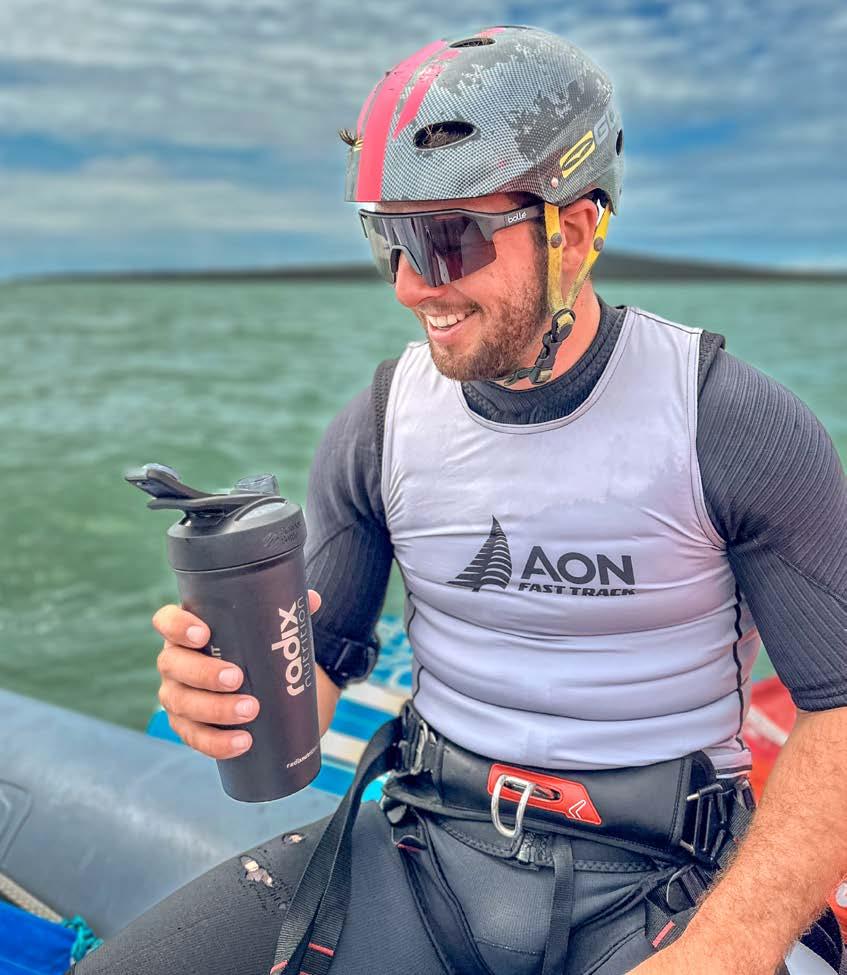
menstrual cycle, were put on different calorie intakes – one with sufficient nutrition, the other with nearly half the required intake. Within just three days, the under-fuelled athletes experienced reduced insulin levels, increased cortisol, and hormonal imbalances, despite feeling full.
This underscores a crucial point: athletes may not always feel undernourished, but their bodies tell a different story.
The responsibility falls on us as coaches to shift the culture around fuelling. We need to treat nutrition as an essential part of preparation, just like ensuring gear is ready or arriving on time.
Creating an environment where sailors feel comfortable discussing their nutrition is key. If we don’t feel equipped to have these conversations, we must find the right people who can.
If we can instil these habits in our athletes from an early age, we set them up for long-term success.
Our next workshop, Performance Impact 2, will see six Yachting New Zealand participants diving deeper into these critical areas.
The follow-up Zoom session will provide another opportunity to reflect and implement these learnings. The more we educate ourselves and our athletes, the better equipped we are to foster a healthier, stronger, and more resilient sailing community.
‘Performance in sailing is about consistency across multiple days. To achieve that, aerobic fitness is absolutely critical to maintaining both physical and mental performance for the duration of long, multi-day regattas.’
Dr Kim Simperingham


Kathy Catton talks to a leading sport scientist about fitness training for sailors of all ages.
He’s one of New Zealand sport’s most experienced strength and conditioning coaches, has worked with some of the most famous sporting teams on the planet, and has witnessed first-hand how researchbacked science can directly impact sailing performance.
Dr Kim Simperingham believes he has perfected the formula for sailing success across classes, genders, and ages.
With over 25 years of experience preparing elite athletes, Simperingham has worked across a range of sports, including eight seasons with the All Blacks and, most recently, as Head of Physical Performance for Emirates Team New Zealand.
He previously led the strength and conditioning team at High Performance Sport New Zealand, which continues to play a leading role in Yachting New Zealand’s high-performance programme.
With a PhD in sports science and published research on speed development, biomechanics, and exercise physiology, Simperingham’s online fitness coaching business, Fit Crew Performance, supports Kiwi sailors at all levels, from youth to professional, ranging from 14-year-olds to masters sailors.
This includes training some of New Zealand’s top sailors – like Peter Burling, Jo Aleh, Molly Meech, and Erica Dawson –and, late last year, sharing his expertise with emerging young talent at the Aon youth camp at Manly Sailing Club.
Simperingham’s unique perspective highlights the distinct fitness demands of sailing compared to other sports, particularly the self-directed nature of sailing, which requires athletes to make rapid on-the-water decisions.
“It’s a super athlete-led sport where the sailors are totally involved in their own campaign, planning and driving it themselves,” Simperingham explained. “With rugby, campaigns are very much coach-led – it’s interesting to note the
differences.”
Sailing requires a unique combination of physical attributes, he said.
“Performance in sailing is about consistency across multiple days. To achieve that, aerobic fitness is absolutely critical to maintaining both physical and mental performance for the duration of long, multi-day regattas.”
But endurance alone isn’t enough. With evolving boat classes, such as foiling boats and F50 catamarans, strength and power have become increasingly important.
“Our top sailors need strength and power for crucial bursts of effort,” Simperingham said. Perhaps most uniquely, sailors require exceptional balance and proprioception.
“It’s about the ability to move in response to what’s happening in the environment. For me, it’s that interaction


between a really high decision-making sport and really unique physical demands that makes sailing so fascinating.”
Simperingham’s approach is highly individualised.
“Women are not small men,” he said. “There are hormonal differences that need to be considered in their training plans, and it’s important to be responsive to physical changes across a woman’s cycle.”
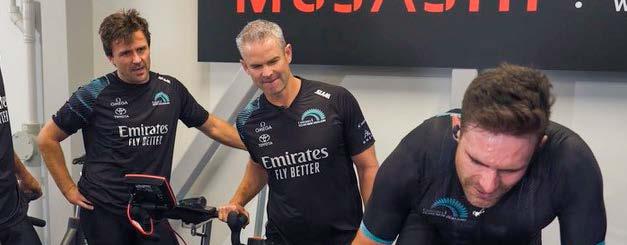
However, he stresses that personalisation is key for all athletes, regardless of gender.
“Thankfully, in sailing, I work with a small enough number of athletes that I can spend time with each individual, communicating quite clearly and tailoring the programme to them and their unique situation.”
He follows the Long-Term Athlete Development (LTAD) model, originally developed in Canada, which prioritises sustainable growth over short-term gains.
“When we start working with teenage athletes, it’s about learning how to train safely and effectively and developing good habits around nutrition and recovery,” Simperingham said. “Athletes progress through different phases, from learning to train, to training to compete, and finally to training to win.”
For masters sailors, the focus shifts towards longevity.
“It becomes about being ‘fit for life’– use it or lose it – and maintaining the mobility, strength, and fitness to keep setting new sailing goals.”
Simperingham played a key role in Emirates Team New Zealand’s victorious America’s Cup campaigns in 2017 and 2024, physically preparing sailors aboard Aotearoa and Taihoro, as well as the youth and women’s crews.
Sailing at this level presents its own challenges, particularly when it comes to weight management.
“Each athlete has quite a strict body weight target,” he said. “We have a crew weight that we have to be within.”
To manage this, careful planning is essential, ideally avoiding the need for lastminute weight cuts before weigh-ins.
During the America’s Cup regatta, the daily routine is highly structured.
“The helms and trimmers would do a
short physical primer session in the gym right before they jump on the water,” he explained.
“The cyclors would do some time on the bike and often do strength work before they go out.”
Post-sailing recovery is equally precise, with tailored recovery shakes and a mix of cycling, massages, ice baths, and stretching, depending on each sailor’s role and weight requirements.
Having worked with both the All Blacks and elite sailors, Simperingham has observed key similarities and differences between two of New Zealand’s premier sports.
“The really strong drive to continually evolve and develop is really clear in both sports at the top level,” he said.
However, the approach to recovery varies significantly.
“Sailors are much more active in their recovery time – they’ll be out spending time on the water, winging, or playing games like padel tennis. Rugby players get bashed up so much they really have to prioritise a very passive recovery.”
When asked how sailors can avoid injury, Simperingham highlights the importance of fundamental fitness.
“Poor aerobic fitness, poor strength –especially core strength and pulling strength – can quickly get exposed on the water and then lead to niggles and injury,” he said.
However, the solution doesn’t require an overwhelming time commitment.
“Two or three short sessions a week can make quite a big difference for sailors in fitness, strength, and resilience to injury.”
Dr Kim Simperingham offers fitness coaching for all levels of sailors at Fit Crew Performance – visit www.fitcrewperformance.com
Focus on maintaining regular training sessions – even just 2-3 short sessions per week off the water can make a significant difference in fitness and strength on the water and in injury prevention.
Incorporate mobility work, yoga or Pilates to improve range of motion, proprioception and ability to respond to changing conditions on the water.

For weight-sensitive classes, plan body weight targets well in advance of regattas to avoid dramatic last-minute changes.
Active recovery, including proper nutrition and mobility work, is crucial for maintaining performance across multiple days of competition.
Back issues are among the most debilitating injuries for sailors. Prioritise core work and strength training to prevent these problems.

Whey Protein DIAAS Complex 1.61 is scientifically formulated to provide a complete amino acid profile with exceptionally high bioavailability. Build muscle and aid recovery.
Try 5 free samples. Just pay for shipping.

Female skippers on record-breaking Pacific Rally 66
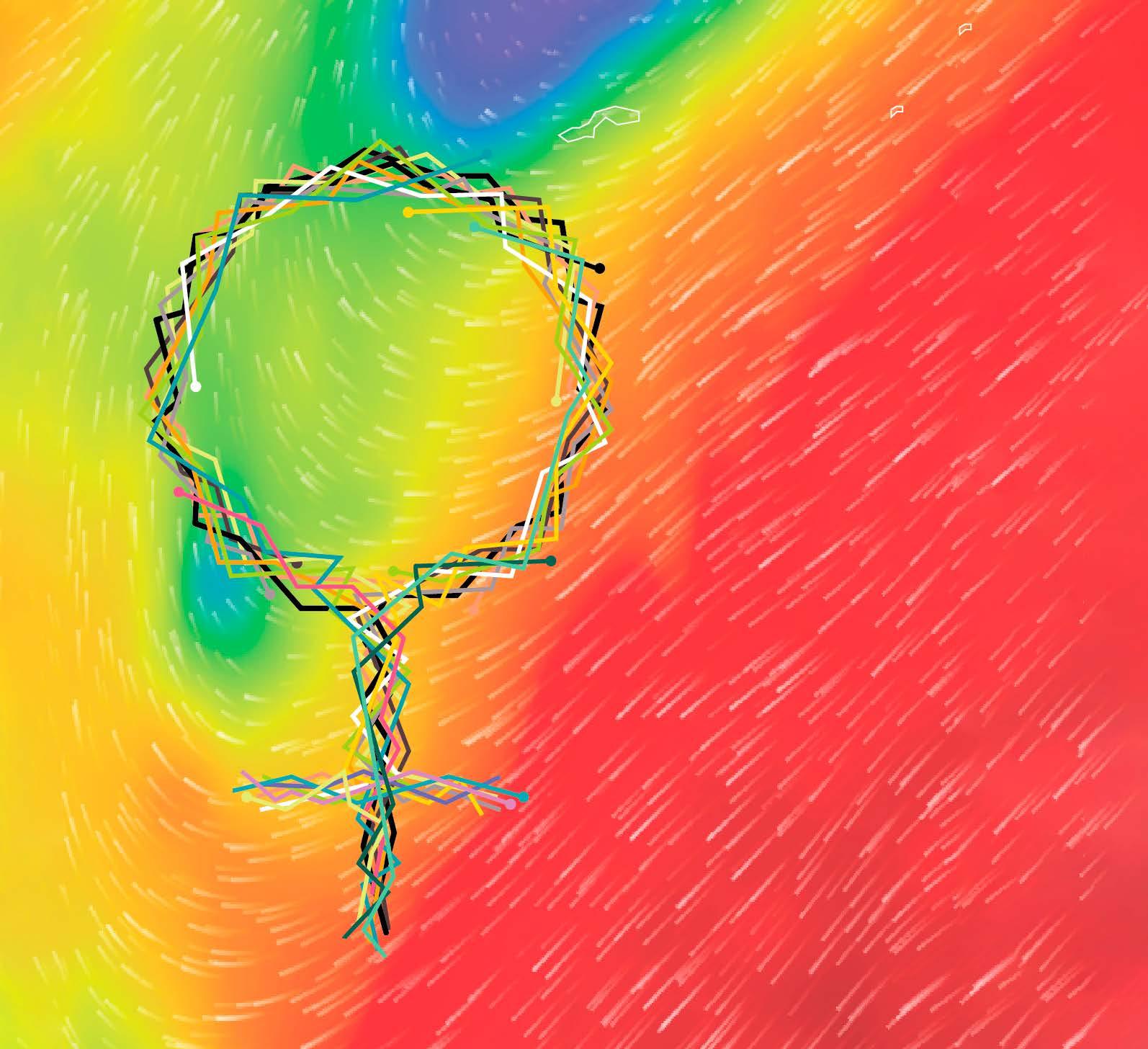

CAPTAIN’S CALL
My takeaways from 14 years at the helm 62
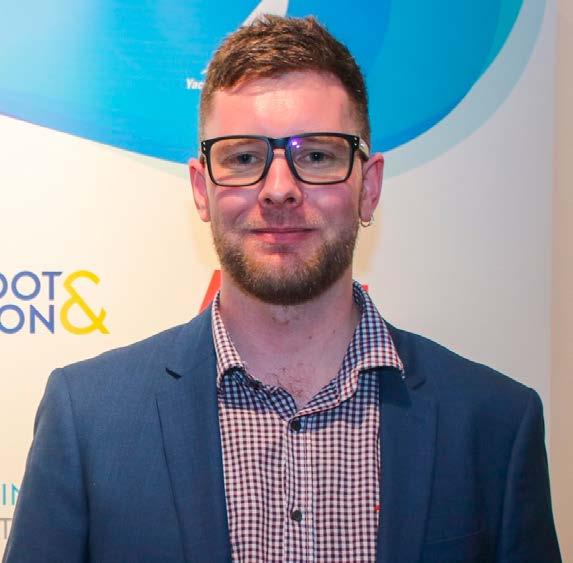
The coach inspiring next generation of stars 66

David Abercrombie FROM THE SKIPPER
Funding, retention of sailors remains key for next leader of sport’s governing body.
Reflecting on my 14 years at the helm of Yachting New Zealand, I’m struck by how quickly the time has passed. It feels like just yesterday that I first stepped into our then head office in Westhaven in January 2011.
A lot has happened since then – far more than words can fully capture – and one of the reasons I remained in this role for so long was the sheer breadth of work. Every day brought new challenges and opportunities. The dynamic nature of the job mirrored the vibrancy of our sailing community, and that energy kept me engaged.
Yachting New Zealand has always evolved to keep the sport strong, from grassroots participation to highperformance. Watching our sailors succeed on the world stage has been immensely rewarding, with nine Olympic medals over the last four Games. Hosting the 2016 youth sailing world championships in Auckland –still regarded as one of the best ever – was a highlight, as was delivering the 49er, 49erFX, and Nacra 17 world championships three years later.
Beyond elite competition, I’m equally proud of our efforts in the sailing community. The launch of our schools engagement programme RŪNĀ, replacing Have a Go after many years, has
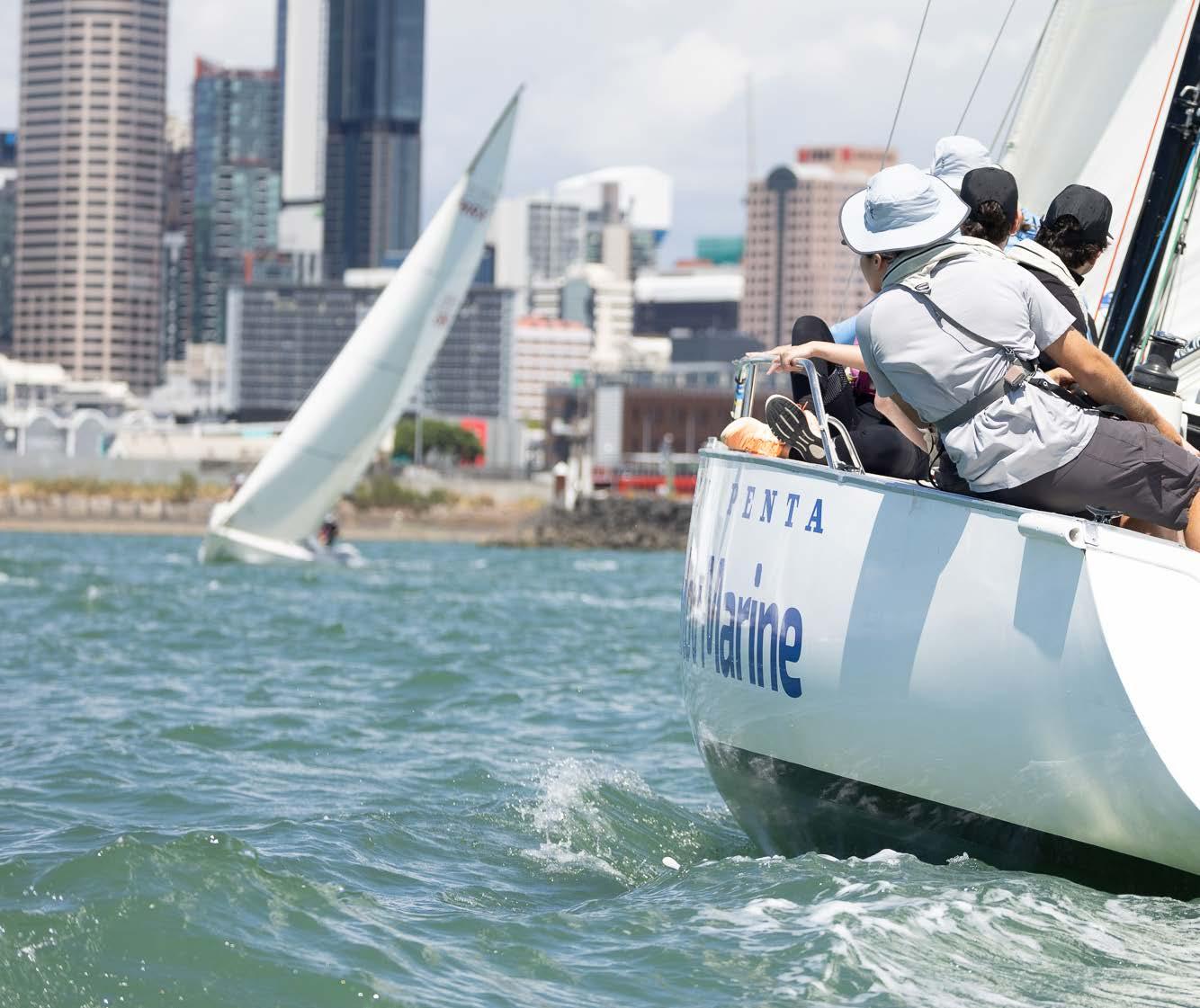
grown inclusivity and provided top-tier development pathways that will sustain the sport’s future.
Of course, there were challenges. The Covid-19 pandemic tested our resilience, making communication more critical than ever. Webinars became our lifeline to clubs and members, and while the period was difficult, we emerged stronger.
Less positive has been the rise of social media issues, particularly among younger sailors. Unacceptable online behaviour – sometimes from parents as well – has presented new challenges, highlighting the need for more education and greater accountability.
Funding remains an ongoing concern for all national sports organisations. There’s a misconception that Yachting New Zealand is flush with resources, but financial constraints are a constant reality. Despite this, we’ve built strong commercial partnerships, and the establishment of the Yachting New Zealand Youth Foundation in 2016 is a major achievement that will continue to support young sailors for years to come.
Looking ahead, sailing is changing. Younger generations engage with the sport differently, and we must adapt.
Wingfoiling, for instance, is growing rapidly and could soon be an Olympic discipline. Embracing these shifts while maintaining accessibility is crucial. Sailing isn’t just about the elite pathway, however. Not everyone aspires to be an Olympian and that’s okay. Sailing should always be fun, affordable, and open to all.
To the wider sailing community: respect each other, embrace diversity, and remain open to new opportunities. Club leadership is vital in fostering an inclusive and welcoming environment.
This role has been more than just a job – it’s been my passion. For over a decade, I’ve devoted myself to it seven days a week. But as I near 70, the time is right to spend more time with my wife, Michelle, my children and grandchildren who are spread across Gisborne, Melbourne and Sydney. I’m ready for this next chapter.
Before I go, there are still a few final tasks I hope to complete. Top of the list is Project Arotake, the independent evaluation led by Kereyn Smith. As we recently announced, Smith has been appointed by the Yachting New Zealand board to lead a transformation oversight group to implement the recommendations from the Project Arotake report, which is
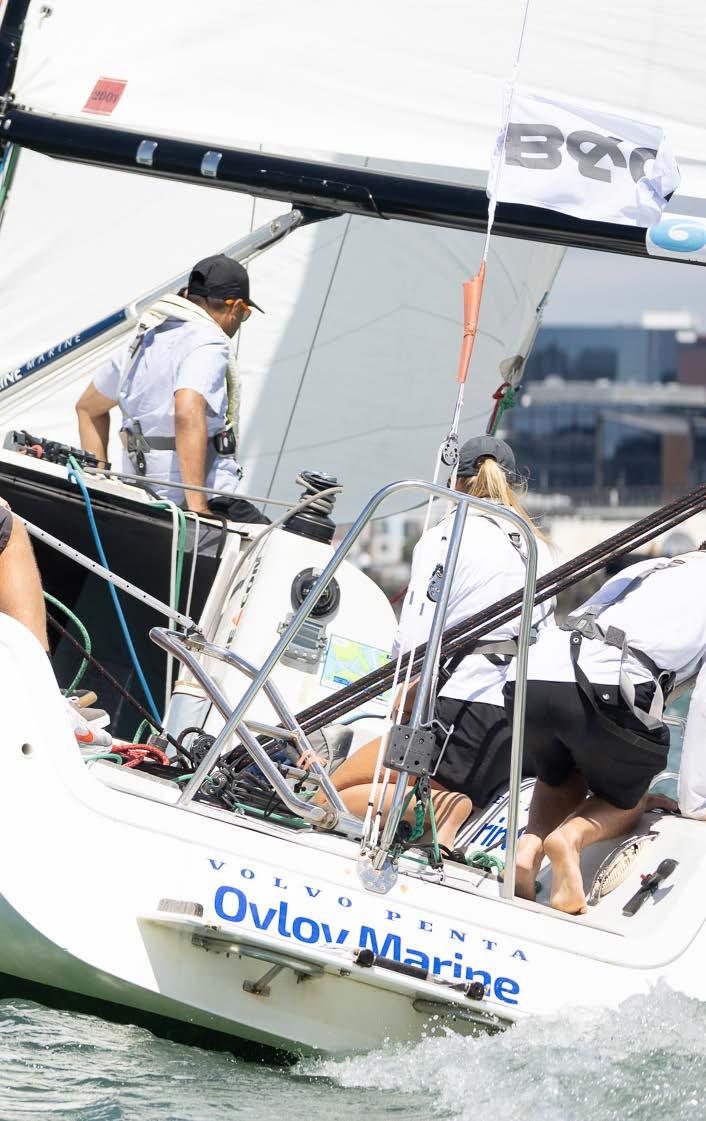
already well underway. We are also putting the finishing touches to two critical new groups – the high-performance advisory group and the athlete leadership group, we hope to secure the bid to host the ILCA world championships in 2028, and we will hold our biennial club conference in May. After that, I’ll take a break – play a lot more golf and get back on the water simply for the joy of it. But I won’t disappear completely; I plan to stay involved in sport in some capacity.
This has been an incredible journey, and I’m grateful to everyone who has been part of it. To our athletes, coaches, volunteers, colleagues, commercial partners, and past and present Yachting New Zealand board members – thank you.
As I prepare to walk out of 4 Fred Thomas Drive for the last time on June 30, I do so knowing I’ve given my all to ensure our sport is stronger than it was when I first took the reins.
I have immense confidence in the future of New Zealand sailing, and I look forward to watching the sport continue to thrive. With the passionate, hardworking, and capable people in our community, how can it not?
Continuing the series on the origin of quirky boat names, Kathy Catton delves into the story behind Drinks Trolley.
Originally destined to be called Trolley Dolly, the name of this modified Thompson 30 sloop hit some turbulence when a friend who worked as an Air New Zealand flight attendant took offence.
“She thought that was quite rude,” recalls the boat’s builder, Phil Houghton, known in the industry as ‘Phizzle’. And thus, Drinks Trolley was born – a name that would prove appropriate for a vessel that saw its fair share of after-racing drinks on board and general good times.
with the second race doubling as its delivery voyage to new owners in the north.
Drinks Trolley’s journey hasn’t always been smooth sailing. After being sold to a family in Kaitaia, she “had an intimate encounter with a rock,” said Houghton. However, like any good spirit, she proved resilient.

Being professionally repaired, she then spent many years racing in Wellington with Greg ‘Waggy’ Wagstaff at the helm.
The boat became an iconic name in the Wellington racing scene. She went for a time to Waikawa before returning to Auckland under the current ownership of sailmaker Nick Gardiner.
Built in Houghton’s Mount Eden backyard about 22 years ago, Drinks Trolley started life as a modified Thompson 30 ultralight sailboat mould plug, that he purchased “for nothing, basically” from boat designer Steve Thompson. The modification process extended the boat by 700mm and added creature comforts like bunks and a diesel engine – a significant upgrade from the original race boats that relied on outboards.
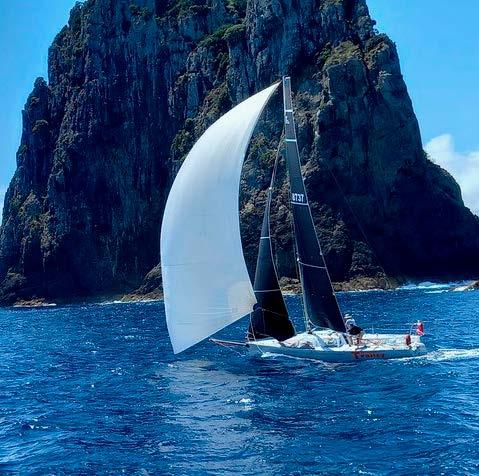
“It took about a year to build,” said Houghton, who completed the project while running Doyle’s sailmaking business in Auckland at the time. The boat’s racing career included two Coastal Classics, gaining honours,
Back in Auckland, she had a major refit, including adding water ballast, rig upgrade, sail wardrobe and systemising for double-handed sailing. She is now back sailing in her home waters around the Hauraki Gulf, sailing many SSANZ races, including Round North Island, SSANZ Triple Series, Northern Triangle, and Coastal Classic.
Drinks Trolley continues to serve up good times on the water – living up to her name and the spirit in which she was built.
If you have any fun or quirky stories about your boat’s name, please send them through to eduan@yachtingnz.org.nz

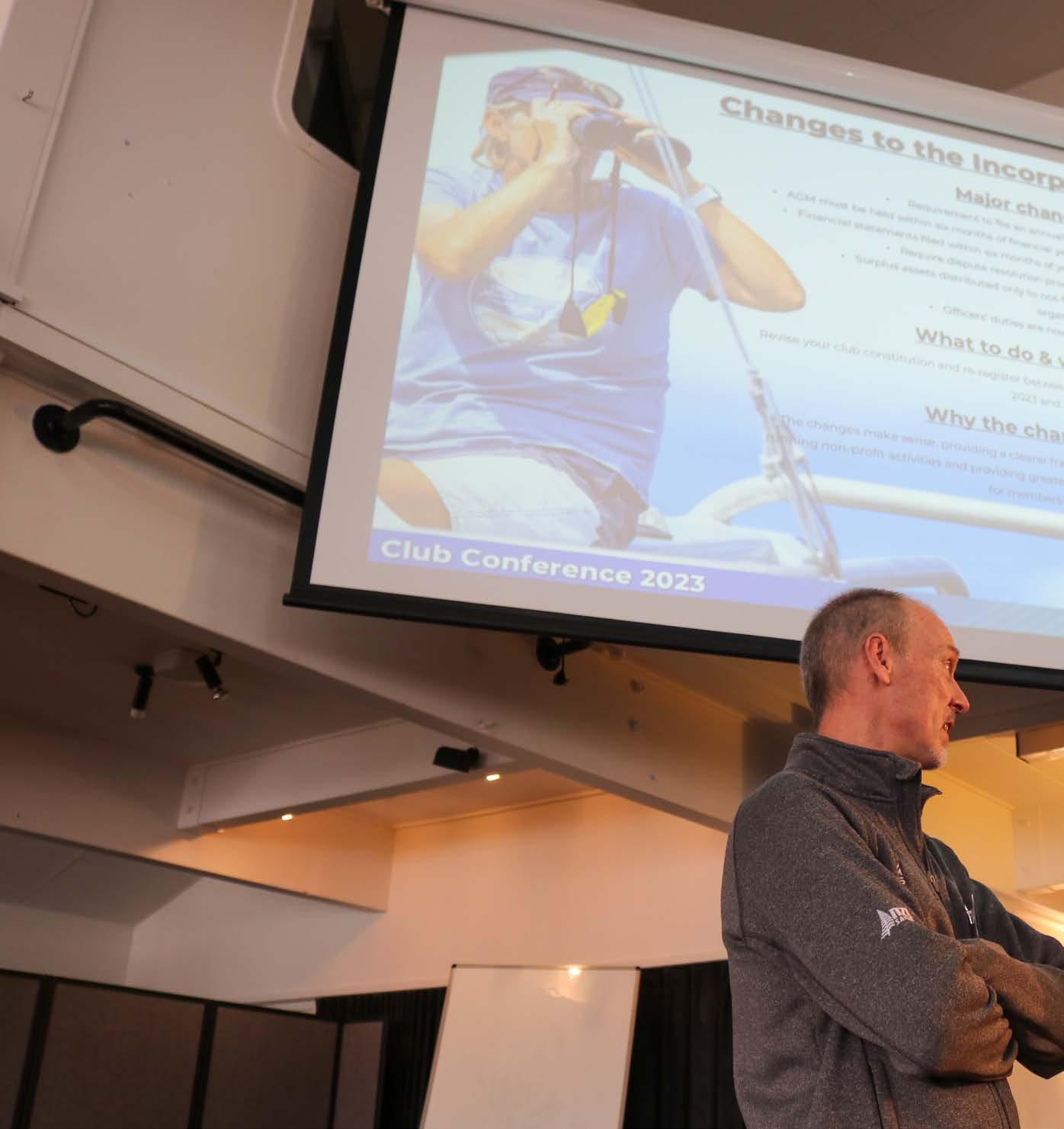
The latest edition of the biennial event will focus on networking and information sharing.
Bolstering club coffers, further increasing engagement with local communities, and Yachting New Zealand’s future strategy are three of the topics that will be discussed at the club conference in May – and the 2025 edition of the popular biennial event will have an even greater focus on connecting club leaders and information sharing than ever before.
This year’s conference is free and takes place at Bucklands Beach Yacht Club on Saturday, May 24, 2025. It will start at 9.30 am and conclude at 4 pm.
“The Yachting New Zealand club conference is a valuable event for commodores, providing an opportunity to connect with other club leaders, share knowledge, plan, and network,” said the organisation’s national sport development director Raynor Haagh.
“Feedback from previous conferences has highlighted the value of networking and sharing ideas and experiences with other attendees and this year we will allow ample time for that.”
As in previous years, the conference will canvas a wide range of topics relevant to yacht clubs. Survey data collected after the last club conference in 2023, highlighted areas of particular interest and these will be a big focus of this year’s conference.
It includes presentations by and discussions with experts in areas including gaming and grant funding, environmental sustainability, Yachting New Zealand’s school and community engagement programme RŪNĀ, safety systems for clubs and keelboats, women and girls in sailing, Sport New Zealand’s new integrity code, Yachting New Zealand’s strategic direction for 2025-2028 and club communication and social media.
“We will conclude the day with a facilitated Q&A session with Yachting New Zealand board directors and leadership team members, who will answer questions from clubs,” Haagh said.
“This invitation is extended to the
commodore of each of our affiliated yacht and boating clubs. If in 2025 your club has a new incoming commodore, we encourage you to consider sending them.”
There may also be an opportunity for a second club representative to join the conference and clubs with employed managers are encouraged to invite them as time will be allocated for this group to discuss issues specific to larger clubs.
These clubs will, however, be required to cover the additional cost of a second representative or manager attending the conference. If numbers are limited, priority will be given to a representative from each club before confirming a second participant.
Haagh urged young people who are active in their club’s committees to also attend.
“We want to see more young people in club leadership roles and any clubs who would like to bring a young leader to the conference should apply, outlining the individual’s role and how the club supports them.
“Successful applicants may receive a contribution towards travel and
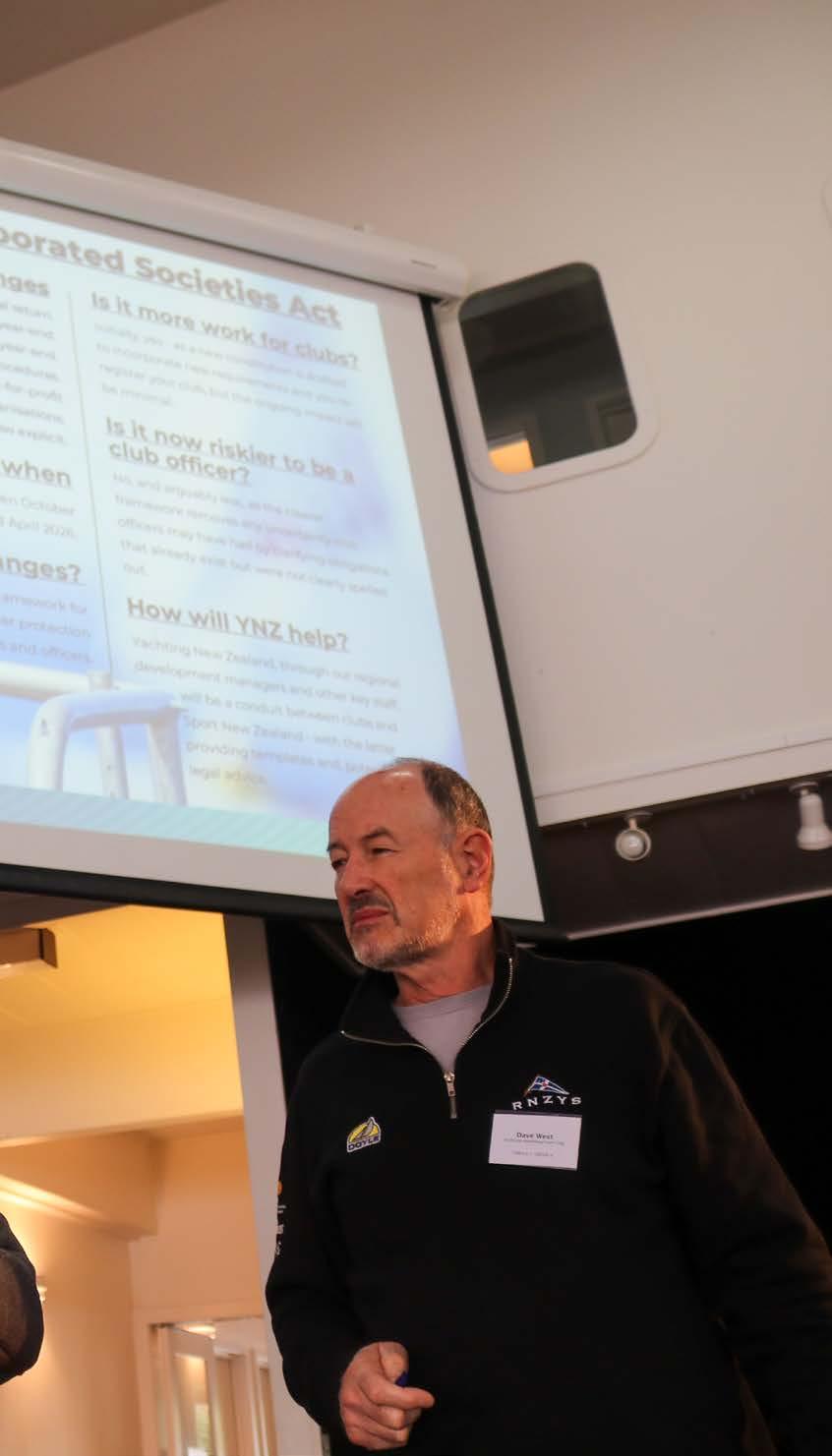
accommodation costs.”
Commodore and club representatives can register online here
Registration closes on Friday, May 2, 2025.
If you have any questions, please contact your regional development manager.
Yachting New Zealand will contribute as follows to travel and accommodation costs for clubs outside Auckland:
• North of Auckland (clubs north of Auckland, including Sandspit Yacht Club) - $150.
• South of Auckland (clubs south of Auckland, including Thames Sailing Club) - $150.
• Lower North Island (clubs in the central region) - $300.
• South Island clubs - $450.
This contribution will be deposited into a nominated bank account three weeks before the conference, once the club’s registration is confirmed.
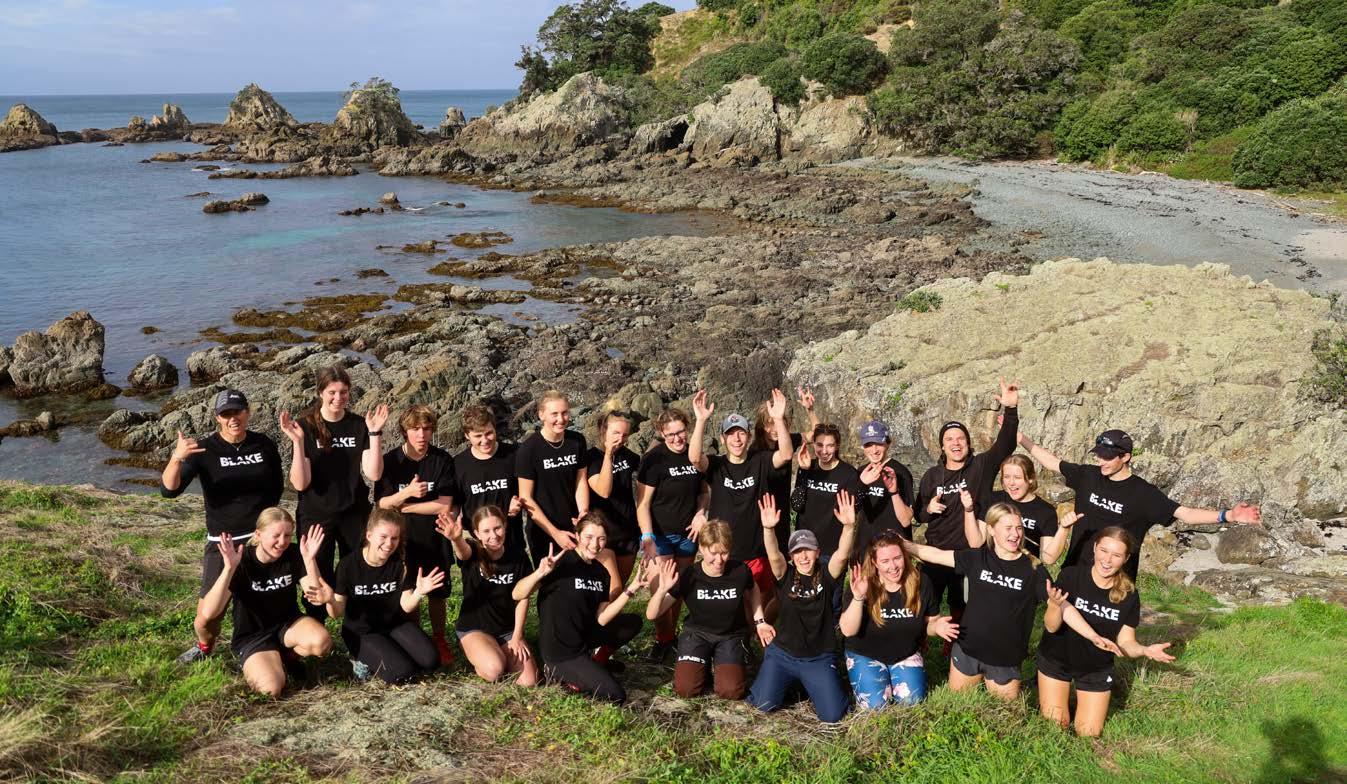
Yachting New Zealand and Blake NZ have teamed up to give two young club members the opportunity of a lifetime – and we need your help to decide who will receive it.
Clubs are encouraged to nominate a young member (school year 11, 12, or 13 during 2025) to represent their club at the Blake Inspire programme in December.
The programme is a week-long residential leadership development programme in which students work with scientists, environmental experts, a diverse range of leaders, and other like-minded students to develop strong leadership skills while learning about topical environmental issues and how they can tackle them.
Participation, adventure and learning are all key requirements for delegates. They will take part in environmental and marine science activities and visit businesses and local organisations to learn about what they are doing to reduce their impact on the environment.
Two scholarships are available for the programme from December 1 to 5, 2025 and will be awarded to recipients nominated by a Yachting New Zealandaffiliated club.
“The ideal candidate will be a club member who is active in club committees, involved in your club’s Clean Club programme, or is an instructor delivering RŪNĀ,” said Yachting New Zealand national sport development director Raynor Haagh.

“In addition to attending the Blake Inspire programme at no cost, Yachting New Zealand will also cover the costs for the successful candidates to attend the 2025 Yachting New Zealand club conference.”
The club conference is a biennial event that brings together club leaders from across the country to plan, network and help improve the quality of experience your club provides.
Applications for the Yachting New Zealand Blake Inspire scholarship close on April 14, and you can submit your application by clicking here
Wade Tresadern is the latest recipient of Yachting New Zealand’s Emerging Coach award. He talks to Kathy Catton about his coaching philosophy, influences and making sailing fun.
Wade Tresadern’s idea of what makes him a great coach is simple and understated: “I’ve just blended the best qualities from all the great coaches I’ve had and worked with, constantly reinventing my approach”.
What this means for Tresadern is crafting a “coaching persona” that embodies all the different aspects of coaches he’s had in his sailing journey. Among the names he draws on are Adrian Mannering, Dave Munroe, Grant Beck, Ollie Steiner and his dad, Lyle Tresadern.
Tresadern’s journey with sailing began at age six, crewing for his father in a Phase 2. By nine, he had his own wooden Optimist, and by 15, he’d moved from sailor to coach.
What followed was extraordinary dedication – at one point, coaching seven days a week, five afternoons after school and weekends, working with multiple schools and clubs simultaneously.
This commitment laid the groundwork for international success, including coaching New Zealand Optimist teams both nationally and internationally, and the RS Fevas at the world championships in 2019 and 2022.
Last November, he was also honoured with the Emerging Coach of the Year award at the annual Barfoot & Thompson

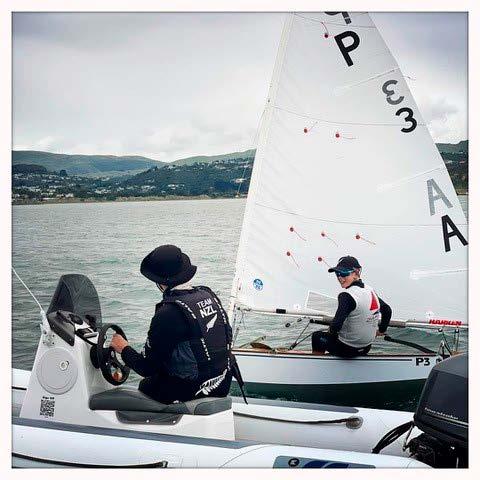
Yachting New Zealand Excellence Awards – the second recipient of the new gong.
Those who’ve watched Tresadern, 33, on the water will know his remarkable presence with young sailors. His approach combines analytical precision with creative spontaneity – qualities he attributes partly to his father’s influence.
“My dad is basically the ultimate sports fan. When I was growing up, we’d sit down and watch sports, deep diving into the technicality of it all,” Tresadern explained.
“That analytical brain stayed with me. I’d be at my job thinking about what I was going to coach that afternoon and how I was going to make it fun for the young sailors. I’d say it was an obsession.”


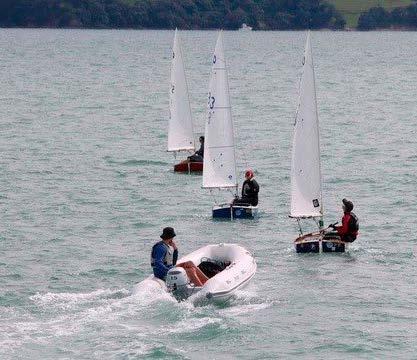
lots of kids, sailing is that thing where you get to test yourself in varied ways.”
Tresadern also understands the power of sailing – that for many children and teenagers, it represents freedom. An escape from everyday constraints into a realm where they control their destiny.
“Sailing is liberating because it’s just you, the boat and the elements,” he said. “For
This understanding manifests in his somewhat unorthodox coaching style.
Tresadern describes himself as “a hard taskmaster, but the most fun taskmaster” –setting clear boundaries while maintaining an atmosphere of playful rebellion.
His sailors follow quirky superstitions


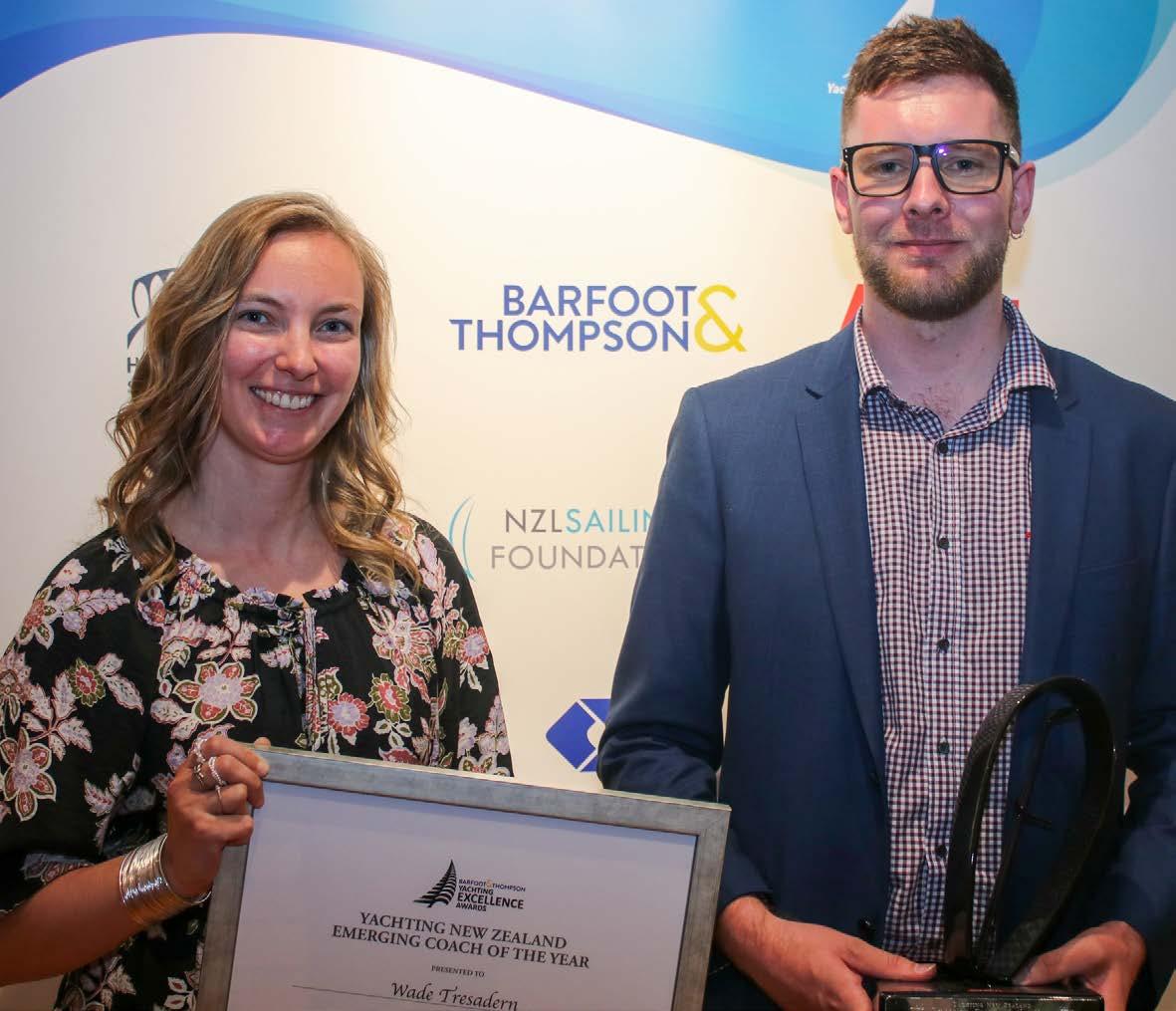
Excellence Awards are all about. It is about more than just high-performance sailing – it is also an opportunity to honour the often-unsung heroes of our community, those people making a difference every day at their clubs.”
In Wade Tresadern’s case, the recognition is well-deserved – and long overdue.


(“no white sunglasses”), collect random inside jokes, and focus on building confidence and a lifelong skillset, rather than just competition results.
“I never really cared about highlevel winning,” he said. “It’s a byproduct of successful training and structured coaching. I mainly wanted my sailors to come back to their club or to New Zealand (when overseas) saying, ‘We had the most awesome fun and learned heaps’.”
Having a focus on fun over winning has been the mantra of Yachting New Zealand coach development manager Kirsten Moratz’s approach for the past three years.
“Wade has done a tremendous job in making coaching fun for his sailors and their success – both in terms of results but, more importantly, retention – has been plain for all to see,” Moratz said.
Tresadern’s method often involves distraction…
“Sometimes it can be gnarly on the
water. When the kid’s just capsized, in their world, everything is wrong. So, I might ask them, ‘What’s for dinner?’ or ‘Tell me a joke.’ Talking about something totally random that isn’t anything to do with sailing, can be the small reset they need before giving it another go.”
After almost 18 years of coaching junior sailing across multiple classes (Optimist, P Class, Starling, RS Fevas, 420s), Tresadern is now transitioning towards mentoring youth coaches at Kohimarama Yacht Club.
He’s also considering joining his 72-year-old father at Bucklands Beach, helping the man who inspired his sailing journey and ensuring youth sailing continues there.
While Tresadern’s off-the-water professional career in packaging takes more of his time these days, his impact on New Zealand sailing continues to ripple outward through the sailors, parents and coaches he’s mentored.
As one of the unsung heroes shaping future champions, Tresadern embodies exactly why the Emerging Coach award was created.
“The Emerging Coach of the Year award was first introduced in 2023 as we identified the need to recognise and celebrate the coaches who don’t work in the high-performance environment but whose contribution is no less important to the sport,” Moratz explained.
“It exemplifies what the Yachting
Orbit World Travel Sailor of the Year: Isaac McHardie and William McKenzie
Barfoot & Thompson Female Sailor of the Year: Erica Dawson
Barfoot & Thompson Male Sailor of the Year: Micah Wilkinson
NZL Sailing Foundation Young Female Sailor of the Year: Greta Pilkington
NZL Sailing Foundation Young Male Sailor of the Year: Joe Leith and Josh Ferrissey
Aon Emerging Talent Award: Matteo Barker, Chloe Turner
Millennium Hotels and Resorts Official of the Year: Jamie Sutherland
B&G Performance Coach of the Year: Matt Steven
Yachting New Zealand Emerging Coach of the Year: Wade Tresadern
Lawson’s Dry Hills Outstanding Contribution Award: Gary Smith
Evocean Sustainability Award: Sheryl Lanigan
North Sails Sportsmanship Award: Flying Fifteen New Zealand
MAST Academy NZ Young Leadership Award: James Swinney

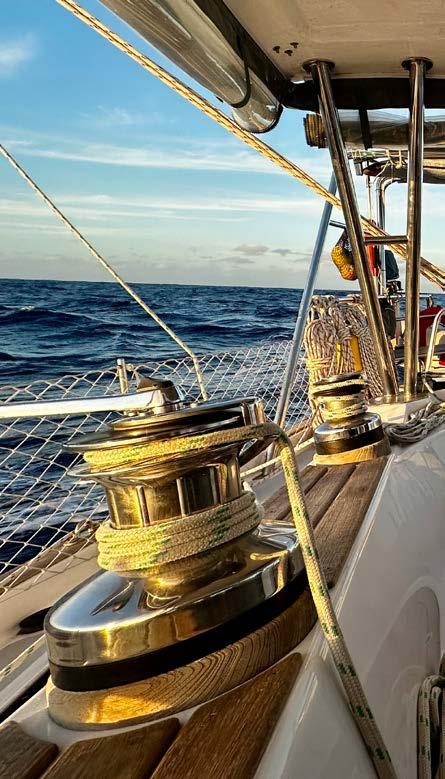
The 2025 Pacific Rally will have the largest number of female skippers in its 40year history. Kathy Catton finds out what is behind the sea change in cruising attitudes.
The 2025 Pacific Rally, due to depart New Zealand this month, marks a significant milestone for the 14 female skippers among its 125 registered vessels.
This year’s event, organised by Island Cruising New Zealand, will feature the most female skippers in its 40-year history.
The upward trend has been building steadily, from two female skippers out of 42 boats in 2022, to six out of 93 in 2023, and six out of 160 in 2024.
The 2025 rally’s numbers represent not just a statistical jump, but a shift in inclusiveness of a previously maledominated sport, according to Island Cruising New Zealand director Viki Moore.
“Each individual skipper has her own unique story. Often the women are the ones who’ve had the dream, they’ve got the boat, and their partner is along for the ride – just as you see in many male-skippered boats, with their partners as first-mates,” she said.
Moore, who took on the Island Cruising Rally business after obtaining her offshore yacht master qualification in 2021, has witnessed the evolution of attitudes firsthand.
“Initially I did experience some resistance when I took on the business, particularly from old-school cruising men,” she recalls.
“But now, I really feel accepted by what was traditionally the ‘old boys’ club’. The success and growth of the rally have certainly silenced any critics.”
The rally organises intensive education and specific initiatives to support all sailors, including women’s catch-ups pre-departure – particularly valuable for those new to the sailing community.
This network proves especially important during challenging moments at sea.
“Last year, when one of our sailors was having a tough time after a difficult crossing in Tonga, we were able to connect her with other women on nearby boats,” Moore said. “Sometimes you just need to talk with others who understand the experience.”
The rally also connects experienced sailors with newcomers, fostering a supportive environment that benefits all participants, regardless of gender.
Naval Point Club Lyttelton, where Moore first began sailing over four decades ago, has long been a supportive environment for women sailors.
“There have always been some really strong female skippers out of Lyttelton,” she

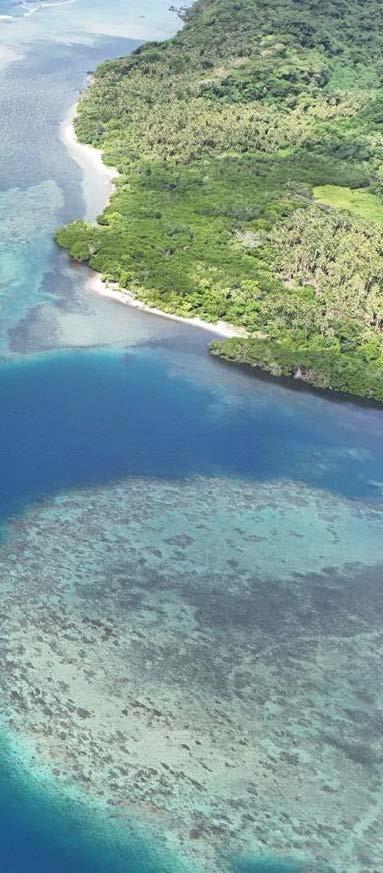
said, citing Irene Hayward, a competitive racer, and Sue Stubenvoll, who extensively cruised the Pacific.
“They were certainly trailblazers who helped pave the way for future women at the helm.”
Moore’s approach to running the rally emphasises inclusivity for all participants. “I make sure to communicate with both partners in sailing couples, ensuring everyone has the information they need.”
Looking ahead, Moore sees the increasing number of women skippers as a natural progression rather than an anomaly. Her focus remains on supporting all sailors in achieving their blue-water dreams while acknowledging that different skippers bring different strengths to their roles.
“What’s exciting is seeing how the community has evolved,” Moore said.
“It’s not about making a big deal of women skippers – it’s about creating an environment where everyone is taken seriously and supported in their sailing

Murdoch was first introduced to sailing at 3 but took a break when her father died until she was reintroduced in her early 20s.
She has owned multiple boats, from Smokey, a Young 88, to Ocean Alley, a Dufour 485 GL cruiser.
Sailing and boats are clearly in her blood.
“I don’t think there is a difference between male and female skippers on the water,” Murdoch said. “It’s just our attitude can sometimes be different.”
She notes that female skippers often excel through methodical preparation: “I’ll plan the next step, they’ll be reactionary to conditions.”
While she’s encountered occasional scepticism – “I got told once we could die because it could be really rough, and we wouldn’t be strong enough” – she’s seen the sailing community evolve.
Her advice for aspiring female
skippers?
“Pick your boat wisely. Make sure it’s not more than you can handle, and the systems aren’t going to be fully brutish.”
She emphasises the importance of setting up your boat for easy handling: “For instance, if you add more purchases to your mainsheet, it can make the loads easier to handle, however, there are many other examples and options.”
‘I don’t think there is a difference between male and female skippers on the water, it’s just our attitude can sometimes be different.’
Victoria Murdoch
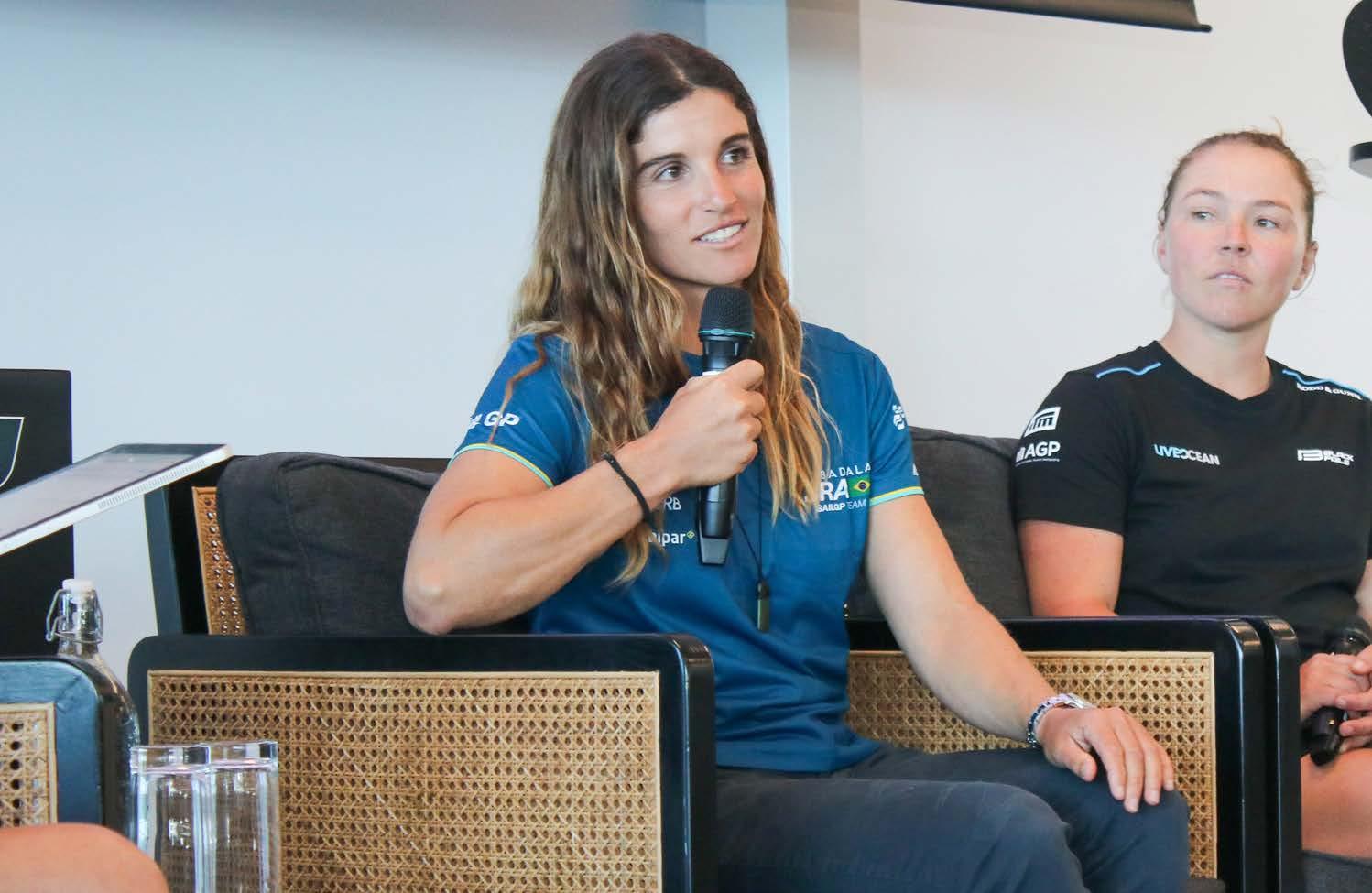
Success is impossible without failure – even for the world’s most decorated sailors.
This was the message from Brazilian trailblazer Martine Grael to dozens of young female sailors at the Breaking Boundaries forum, held at the Royal Akarana Yacht Club ahead of Auckland’s debut of the ITM New Zealand Sail Grand Prix in January.
Co-hosted by SailGP and Yachting New Zealand, the event celebrates women in sailing, showcasing progress made across the sport and highlighting the achievements of female athletes.
Grael, a former 49erFX world champion, double Olympic gold medallist, and round-the-world sailor, recently
became the first female driver in SailGP history.
At the forum, she was joined by New Zealand SailGP veteran Liv Mackay and Denmark team strategist Katja SalskovIversen, with Kiwi winter Olympian Anna Willcox hosting the event.
“Many may not realise how many times we failed before we succeeded. In 2016, I did an Olympic campaign and fell just short of qualifying. It was devastating, but it made me determined never to be in that position again. That failure eventually led to success,” Grael said.
“Even earlier, I failed at many things. I was terrible at sailing an Optimist. In my first regatta, I was so far behind that they removed the mark before I could finish
the course!”
Grael helmed the Brazil team at the Auckland event, her second outing after debuting in Dubai in November, where the team struggled to adapt to the F50 catamarans, finishing 10th overall with a best result of sixth in five fleet races.
“We still fail today, but the key is not letting it hold you back. Focus on the next thing and do it well. Sailing often involves making mistakes and recovering. Some
‘Even earlier, I failed at many things. I was terrible at sailing an Optimist. In my first regatta, I was so far behind that they removed the mark before I could finish the course!’
Martine Grael
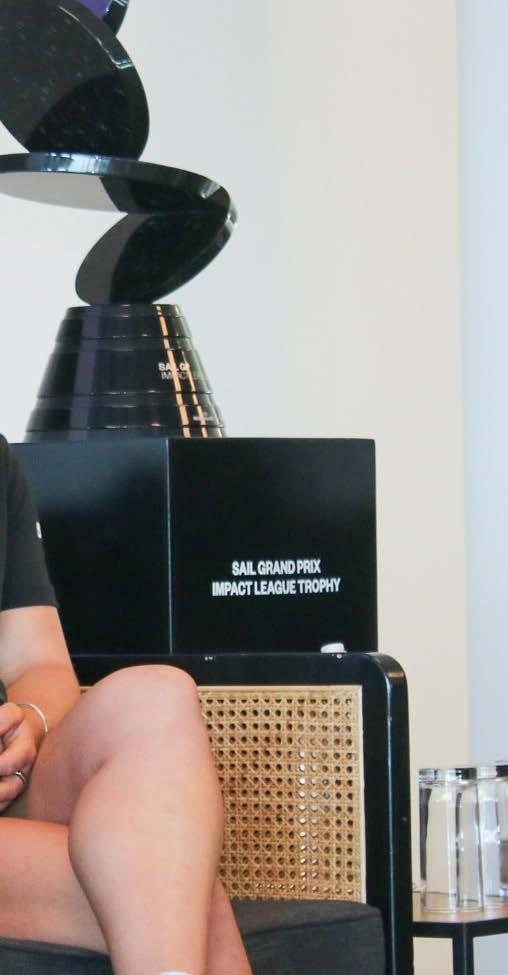
of my best races weren’t when I finished first but when I overcame a poor start and worked my way up.”
While Grael has broken new ground as the first female F50 driver, Mackay and Salskov-Iversen have been integral to their teams since SailGP’s inception.
“SailGP deserves credit for creating pathways for women in professional sailing,” Mackay said. “In Dubai, 18 women trained on the F50s over two days, which gave many of us a real taste for it. There are so many avenues in the sport now, from data analysis to wingfoiling. It’s about finding what you love.”
Salskov-Iversen also acknowledged the progress made.
“When I first joined SailGP, integrating with a team of men wasn’t easy. But as more women joined, the dynamic shifted. That’s why we need more women in all areas - as sailors, coaches, and engineers. Martine becoming the first female driver will definitely make it easier for the next driver, and the one after that.”
Another of this year’s Rally participants is American sailor Morrison, who runs her vessel independently of a life partner and instead works with rotating crew members.
After nearly five decades of sailing experience, 69-year-old Morrison has been living her dream since 2016, spending six to eight months annually aboard her 42-foot Catalina.
It was early experiences with sexism in the sailing industry that inspired her independent path: “I decided that I would just buy my own boat eventually and sail off on my own terms.”
While Morrison acknowledges certain challenges, particularly in a few boatyards where staff can be dismissive, and treat her differently than male crew, she says that cruising brings universal rewards regardless of gender.
“Cruising on a sailboat is a wonderful
From a young age, sailing was “like a religion” for Shrewsbury, who started sailing at 3. After years of dinghy and keelboat racing, she purchased Cerulean, a 43-foot custom-built Sea Stream, and embarked on blue-water adventures with her husband, whom she introduced to sailing.
Shrewsbury notes that female skippers often bring unique strengths to leadership, particularly in their inclusive approach to decision-making. “Women skippers are a lot more inclusive when they make decisions,” she says. “They tend to explain the reason why they’re asking you to do something.”
This teaching style helps build crew confidence and capability over time –but persistent challenges remain.
“It seems women have to not only do things as well as men, they have to do it better. It can feel degrading,” Shrewsbury said.
Yet she sees positive change happening – like Martine Grael, a
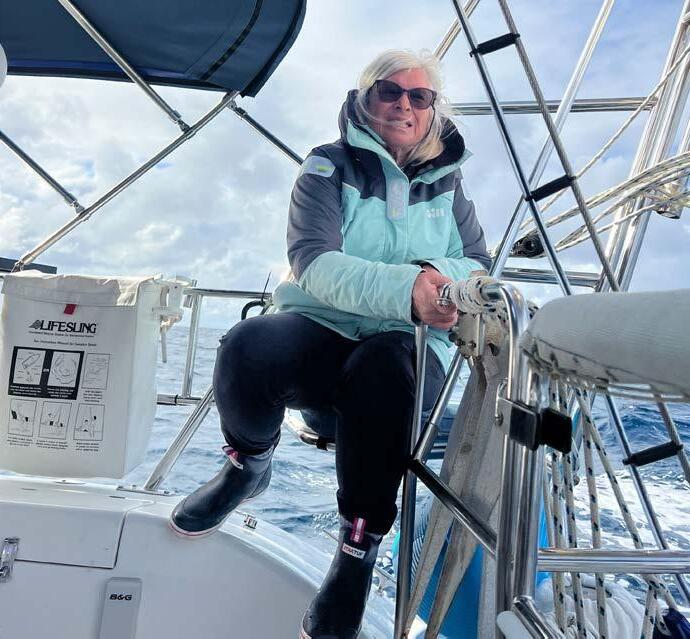
experience, and you have wonderful interactions,” she said.
“Have a boat you’re comfortable with and decide how you want to sail.”
After experiencing crew challenges, Morrison has developed a formula of sailing exclusively with friends and family, ensuring both competence and respect.
Above all, Morrison encourages all women with sailing aspirations: “Make sure you’ve got the skills and then go and do it.”
former 49erFX world champion, double Olympic gold medallist, and round-theworld sailor, who recently became the first female driver in SailGP history.
“To see a helmswoman on Brazil’s SailGP boat is another step in the right direction.”
Her advice for aspiring female skippers is emphatic: “If they have a dream of doing it, do it. My mantra is that I want to die with memories, not dreams.”
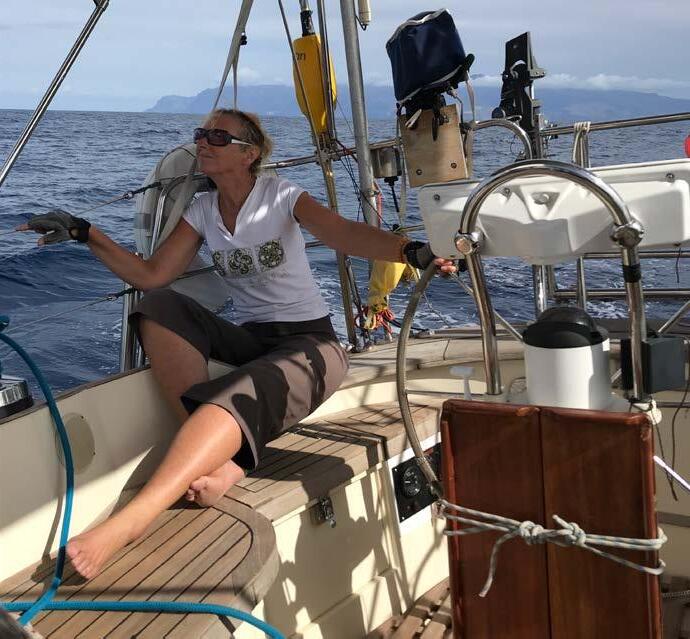
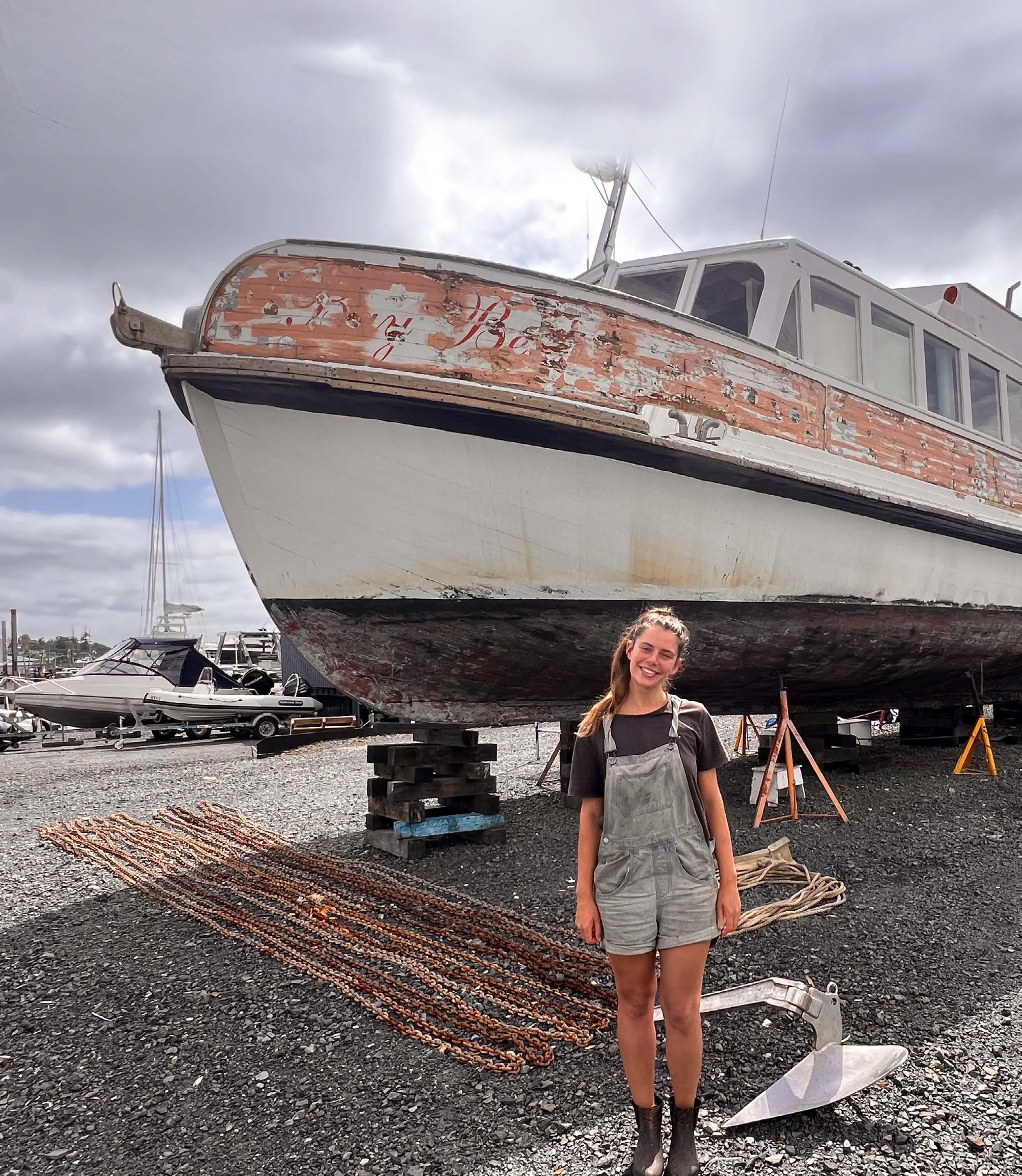


Suzanne McFadden tells the story of how an historic kauri launch got a new lease on life – and how it gave a young Auckland woman a fresh purpose.
As Kate Farrant stands on the deck of Bay Belle, enveloped in a cloud of sanding dust, she feels a connection to the generations of strong women who stood here before her.
Over the summer, the 29-year-old Aucklander has been hard at work at the Hobsonville Marina, bringing the historic kauri launch back to her former glory.
It’s her dream to turn Bay Belle – which for 50 years plied the waters of the Bay of Islands delivering passengers and collecting cream – into a floating restaurant, delivering pizza to hungry boaties in the Hauraki Gulf.
It’s been a labour of love getting Bay Belle, which has carried millions of passengers and travelled the equivalent of 28 times around the equator – back into commission. But a cast of hundreds of friends, family and volunteers have helped Farrant throughout the restoration project.
She’s proud to join a stream of women who’ve steered Bay Belle – like Jane Taylor, the first female commercial skipper in the Bay of Islands, and possibly New Zealand, and fellow Fullers skippers Jean Semmens, Gail Pawley and Charlotte Ebbett (who’s given Farrant ferry driving lessons).
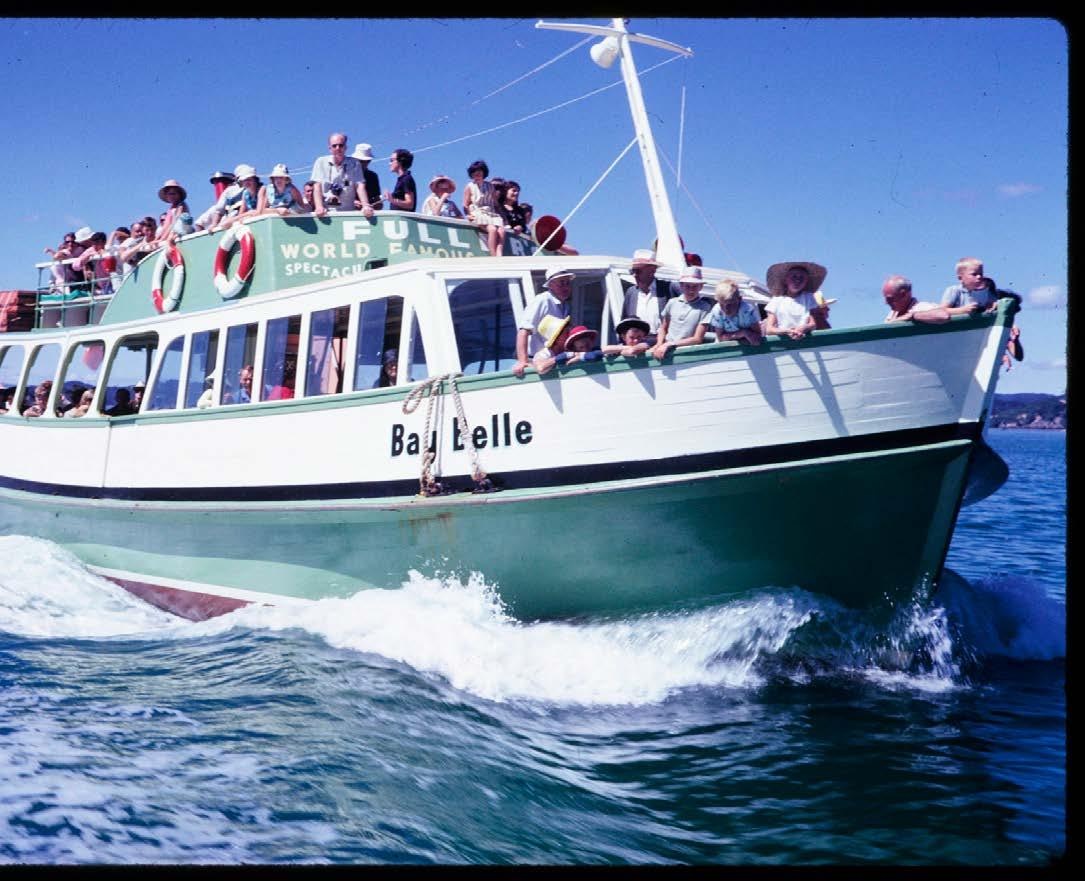
in mid-March, with her exterior makeover virtually complete, and it’s Farrant’s plan to have her operating on the Hauraki Gulf, with up to 100 passengers, by October this year.
“We will provide a congregation space for boaties; a hub that enables a sense of community and collaboration,” said Farrant, who’s getting her captain’s licence.
“We’re doing it as fast as we can, but as correctly as we can to get her operational. We’ve had many challenges, but we keep overcoming them.”
So why would a young woman want to spend months chipping away at a massive project like this?
“I wanted to do something amazing with my life and I really want to make people happy.”

FWomen who remember Belle as reliable, safe and a beloved old friend.
“She’s beautiful. She’s a good girl,” Farrant said. “It’s evident through all the messages I’ve received how loved she was as a vessel.
“I’m really excited to share her with the world again. She’ll be back in service, and people will be able to talk about their memories on her.”
The 17.3m Bay Belle slipped back into the water
arrant didn’t grow up on the water; sometimes sailing her dad’s Sunburst on summer holidays. But a long string of events, starting during the Covid-19 pandemic, led her back to sailing.
“I started going out on other people’s boats in [lockdown] level 3, because we could. And I was like, ‘I’d love to have a boat, if only I could afford one’,” Farrant said.
“At the time I was getting my glider pilot’s licence, learning to use the elements to get from A to B. And the idea of doing that on the water was really appealing, and more social.”
So, she bought a Raven 26.
While she learned how to sail her new keelboat, Farrant met Captain Geoffrey
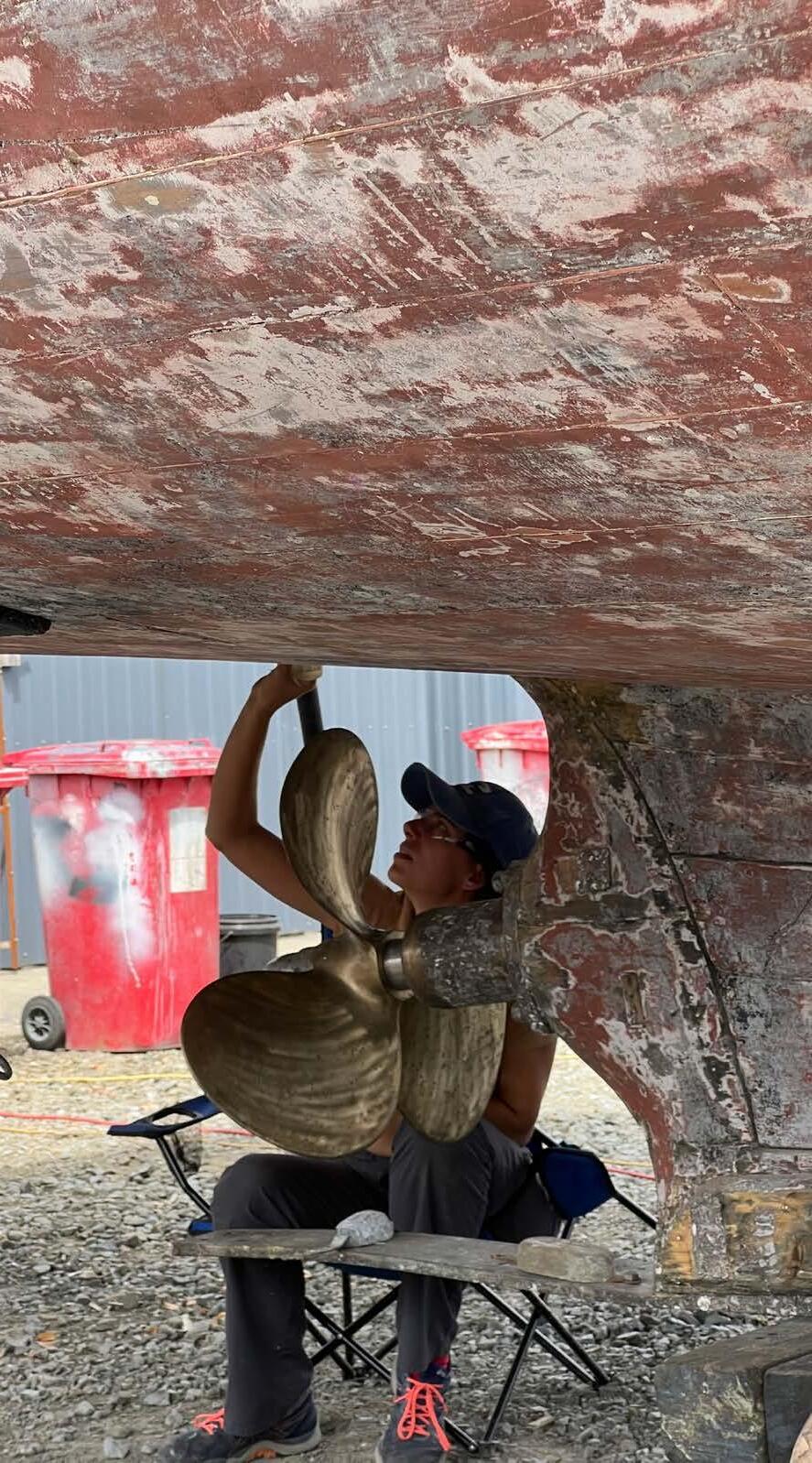
Jones – an American seaman, owner of a 100-year-old schooner called Alvei, which was in Auckland at the time. Alvei is part of a non-profit sailing cooperative, making its way around the globe on old sailing ship routes, carrying out relief projects and teaching crew the traditional arts of sailing.
Farrant, who owns a house on Rakino Island, quit her job in sales and flew to the US to join the Alvei crew for a three-month refit. They then sailed to Nova Scotia, Suriname and the Caribbean. She returned home after nine months to reconnect with her family, before rejoining Alvei as the onboard cook in Ireland.
On sailing into Amsterdam, Farrant saw a slew of boat-based businesses in the city. “So many people are doing really cool things on the water there,” she said.
“And we have more boats per capita in New Zealand than anywhere else the world, and the Hauraki Gulf, which is an absolute boat-lovers’ paradise. But not a lot of amenities for boaties to grab food or a drink or have a change of scenery.”
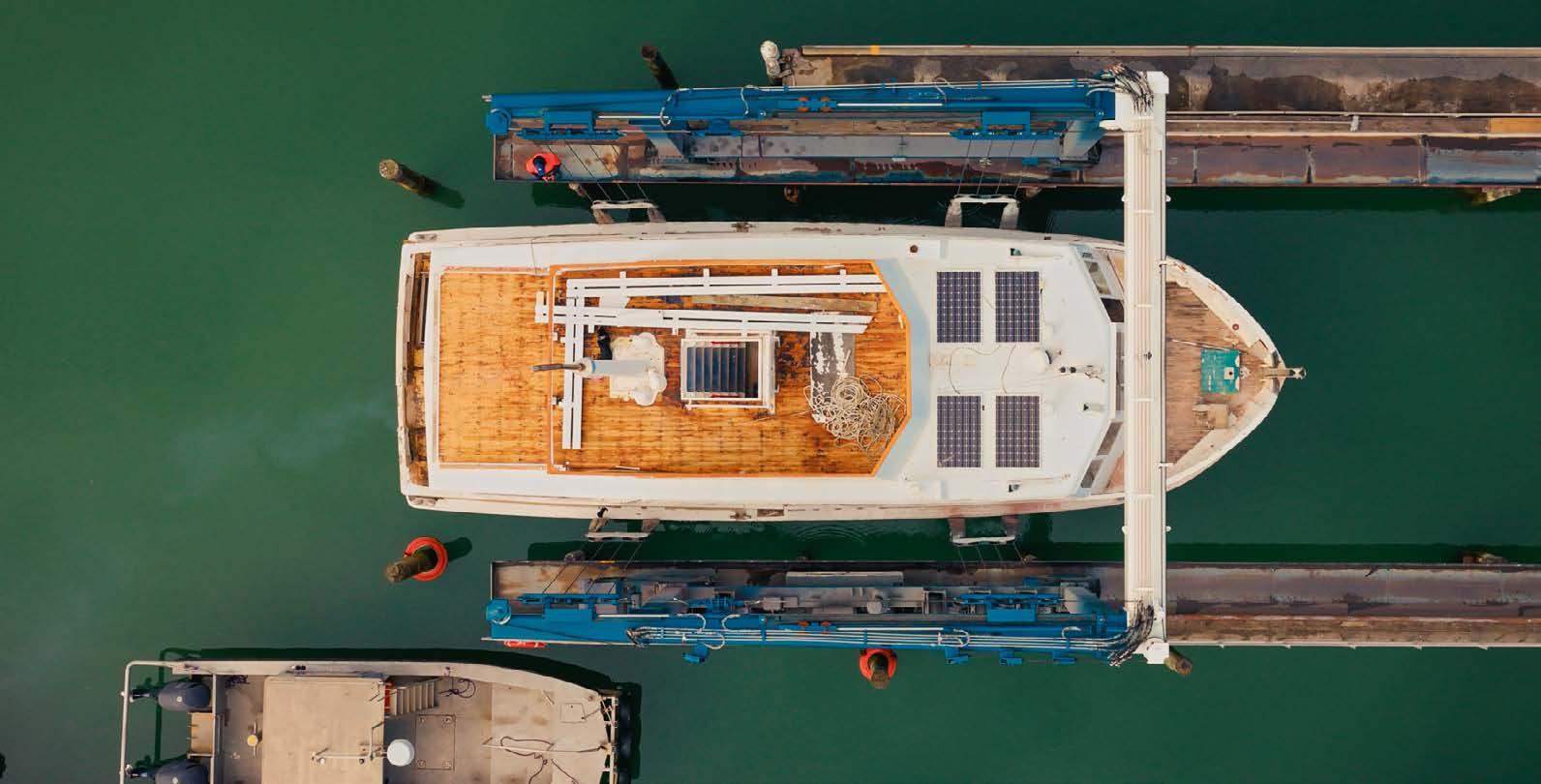

Then Farrant came up with her “grand dream” – to run a floating pizzeria. She was impressed by the Woody Bay Pizzeria on Rakino, run by local Alf Newton, serving pizza to boaties who called into the bay.
“I’d seen his business grow to hundreds of boats coming into Woody Bay. But it wasn’t particularly viable because the weather didn’t always allow good anchorage. So, my idea was to take that business model [with Newton’s blessing] and move it around the Gulf.”
Farrant needed to find a boat to fit the bill of a floating restaurant, and it had to be
‘I got teary-eyed when one of Jane Taylor’s granddaughters messaged me and said, ‘My nana will be smiling down on you’.’
Kate Farrant
a vessel built to survey.
“You can’t just turn any old boat into survey because there are so many regulations,” she said. “The boats I found were hundreds of thousands of dollars, or too big or too small. I didn’t want it to be a pizza takeaway – I wanted it large enough for people to sit down and enjoy.”
She found Bay Belle, sitting in Whangārei, in a deceased estate sale listing on TradeMe. “It was deteriorating on its mooring, but the family wanted to see it go to the right person,” Farrant said.
The Bay Belle was built from kauri by the Deeming Brothers in Opua in 1961 to carry passengers on the Cream Trip – for five shillings, visitors could spend all day on the launch while she collected cream cans from isolated farms. From 1973, she became the main passenger ferry on the Paihia-Russell crossing – carrying her last passengers in 2011.
In those 50 years, the Bay Belle covered
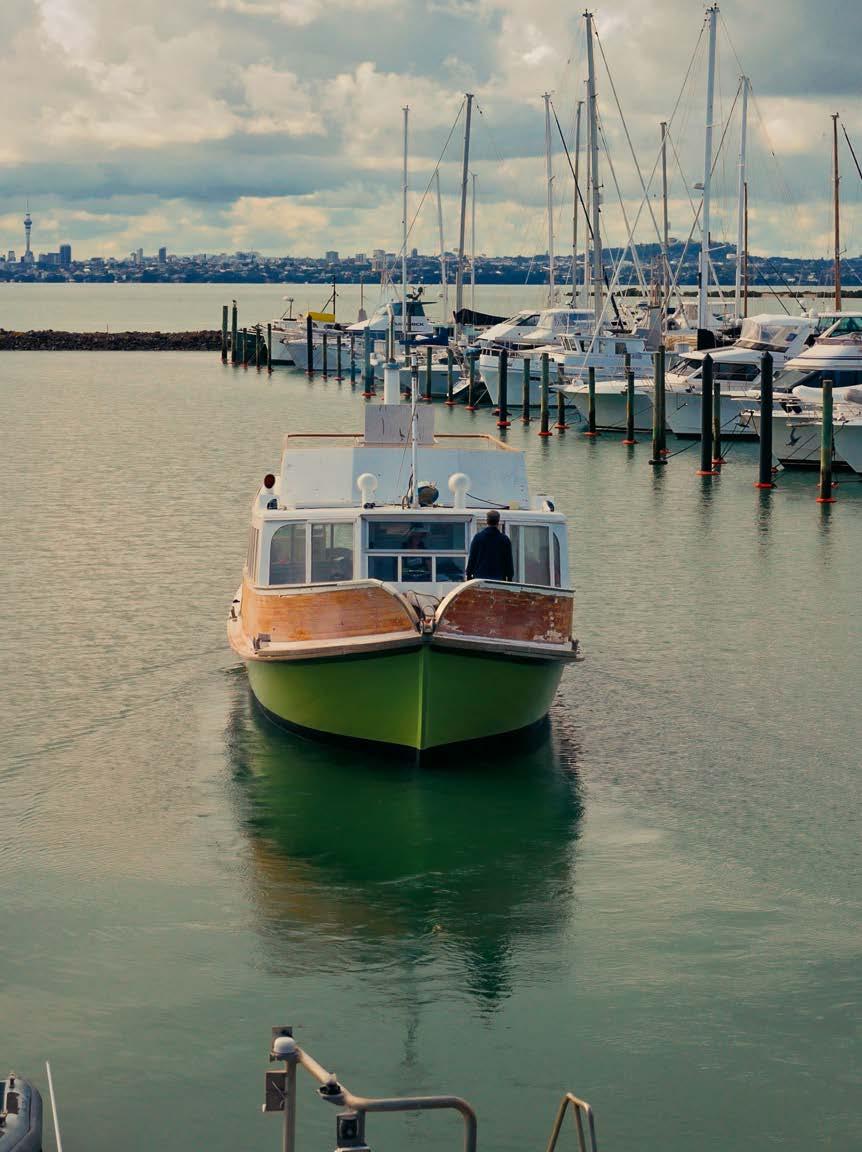
610,000 nautical miles and ferried 5.3 million passengers.
Farrant did her due diligence on the boat. “I just took my time. I looked into the viability of the business and all the different laws surrounding it and just made sure it was something that would work,” she said.
“We got the surveyor in to help guide us through exactly how we were going to do it.”
Her 18 months on Alvei, cooking for 16 and helping with the refit, gave Farrant the skillset and confidence to go ahead.
Since collecting the launch in October, Farrant has devoted all her time to the refit. She’s had no trouble finding others to helpfrom engineers to boat builders, friends and WWOOFers.
“A boatbuilder friend has given us three days a week, and a marine engineer in Nelson had a couple of months up his sleeve, so he’s donated his time to work on replacing the entire exhaust system,” she said. A furniture maker wants to donate a beautiful piece of carpentry for the

wheelhouse.
Farrant’s parents have contributed, too. Her accountant mum is teaching her how to run the business, and her architect dad has drawn up the design plans. They’ve also opened their house to the WWOOFers.
“The only money we’ve had to spend on technical expertise is on the survey and the approvals we’ll have to get,” Farrant said.
AFacebook post appealing for caulking attracted hundreds of comments, from people offering to help with materials or their time, through to those who simply

recalled once travelling on Bay Belle She’s received hundreds of images of the boat in her heyday, to work out Belle’s original colour scheme, but most photos are black and white. The boat was sanded to bare wood in 2014, so the first hull colour remains a mystery.
Farrant plans to take Bay Belle back to the Bay of Islands for a “pizza party”, where locals can advise her on the right colour.
Although she’s recently been a “toothpaste white”, Farrant is painting her cream for now.
“When I look at all the different iterations of her colour scheme and layout, I think they actually got it right in the 60s.” other than the pink marble lino floor, which she’s taken back to hardwood (though she might do pink lino in the bathrooms) …
“I love history, and you feel it in Bay Belle. She’s got a lot of warm, positive memories,” she said. “I got teary-eyed when one of Jane Taylor’s granddaughters messaged me and said, ‘My nana will be smiling down on you’.”
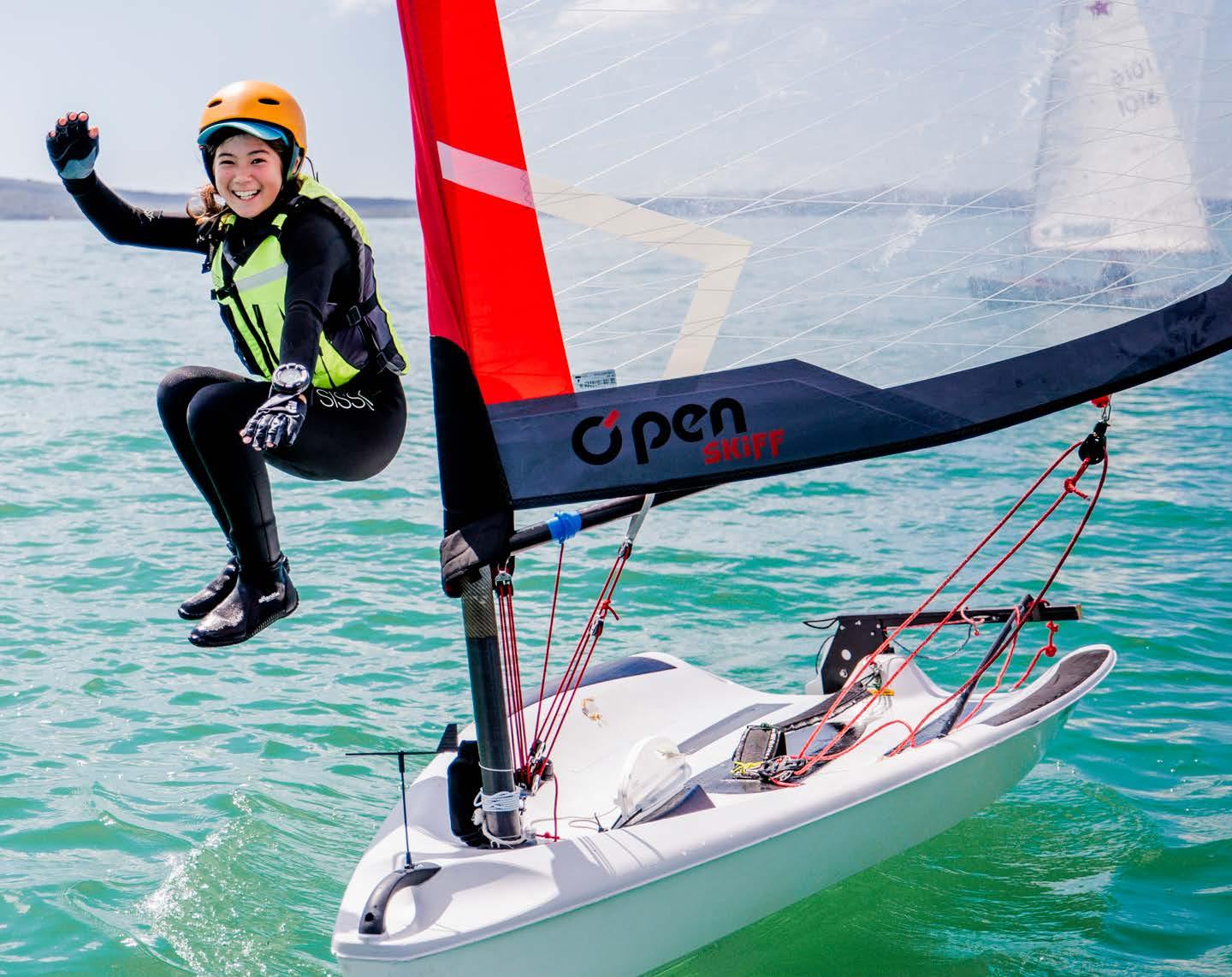
Five of New Zealand’s Olympic sailing heroes are set to guide a handful of the country’s rising stars through Yachting New Zealand’s latest mentorship programme.
Olympians Veerle ten Have, Erica Dawson, Molly Meech, Jo Aleh and Greta Pilkington will each dedicate an hour to a young sailor, offering insights on pathways, challenges, and opportunities within the sport. The selected sailors, who competed at the PredictWind Girls Champs at Kohimarama Yacht Club in March, were chosen by a panel including Yachting New Zealand’s national sport development director, Raynor Haagh.
Each participant can bring a friend to the session, ensuring they gain maximum benefit from their interaction with the experienced Olympians.
Over 100 girls participated in seven classes and across 10 fleets at the PredictWind Girls Champs, the biggest allfemale youth regatta in Australasia.
Now in its 35th year, the regatta has become a cornerstone of New Zealand’s female sailing community, fostering connections, and inspiring the next generation. Supported by PredictWind


Suellen Hurling, founder of Live Sail Die and a renowned sailing photographer, the forum provided invaluable advice for young sailors.
for the past decade, the event provides a unique platform for girls from diverse sailing classes not only to compete but also to forge lasting friendships and mentorship opportunities.
Manly Sailing Club’s Ruby Peters, winner of the O’pen Skiff fleet, will receive guidance from Olympic windfoiler ten Have. Gretel Satterthwaite from Murrays Bay Sailing Club, an ILCA 6 sailor, will work with Meech, 49erFX silver medallist at the Rio 2016 Olympics. Tauranga Yacht and Powerboat Club’s Elsa Daum, who placed fifth in the Optimist open class, will learn from double Olympic medallist Aleh. Julia Nguyen and Lauren Arnold from Kohimarama Yacht Club, winners of the RS Feva fleet, will connect with Paris 2024 bronze medallist Dawson. Bailey Robb from Queen Charlotte Yacht Club, a Starling sailor, will engage with Pilkington, who last year became the first Kiwi to compete in the ILCA 6 at the Olympics since 2012.
The PredictWind Girls Champs also featured a forum, a highlight of the event, where Meech, Dawson, and Rebecca and Nicola Hume shared insights into their experiences as female sailors. Hosted by
The prestigious Osbournes Trophy was awarded to Jo Kensington, commodore of Kohimarama Yacht Club, and Bronwynne Howse, organiser of the PredictWind Girls Champs.
This trophy is presented annually to individuals significantly contributing to female sailing.
Haagh praised the event.
“As always, this year’s PredictWind Girls Champs was a celebration of women and girls in sailing and the progress we’ve made in ensuring females are more visible and valued in our sport,” she said.
“The forum, in particular, provided an excellent platform for young sailors to hear from experienced athletes.
“Molly, Erica, Rebecca, and Nicola shared inspiring stories and valuable advice, reinforcing the many exciting opportunities available - not only in performance sailing but in other areas such as sailmaking, race officiating, design, media, and many others.”
For the complete results from the PredictWind Girls Champs, click
Molly Meech (top right) is one of five Olympic sailors who will mentor six rising stars.
Photos / Live Sail Die


Heading offshore soon?
Cris Brodie highlights four things that should be top of mind – and your checklist –before you depart.
If you’re setting sail for the islands this year, no doubt you’re deep in preparation mode! While it may not feel like it now, thorough preparation is one of the most vital aspects of seamanship. Ensuring that your vessel and crew are ready for anything can make all the difference when the unexpected happens.
Here are four of the most important things for the person in charge (skipper) to keep in mind.
Before you depart, meticulous checks of your inventory, spare parts, and vessel equipment are crucial. This includes engines, mast and rigging, steering systems, portlights, hatches, and safety gear. A well-
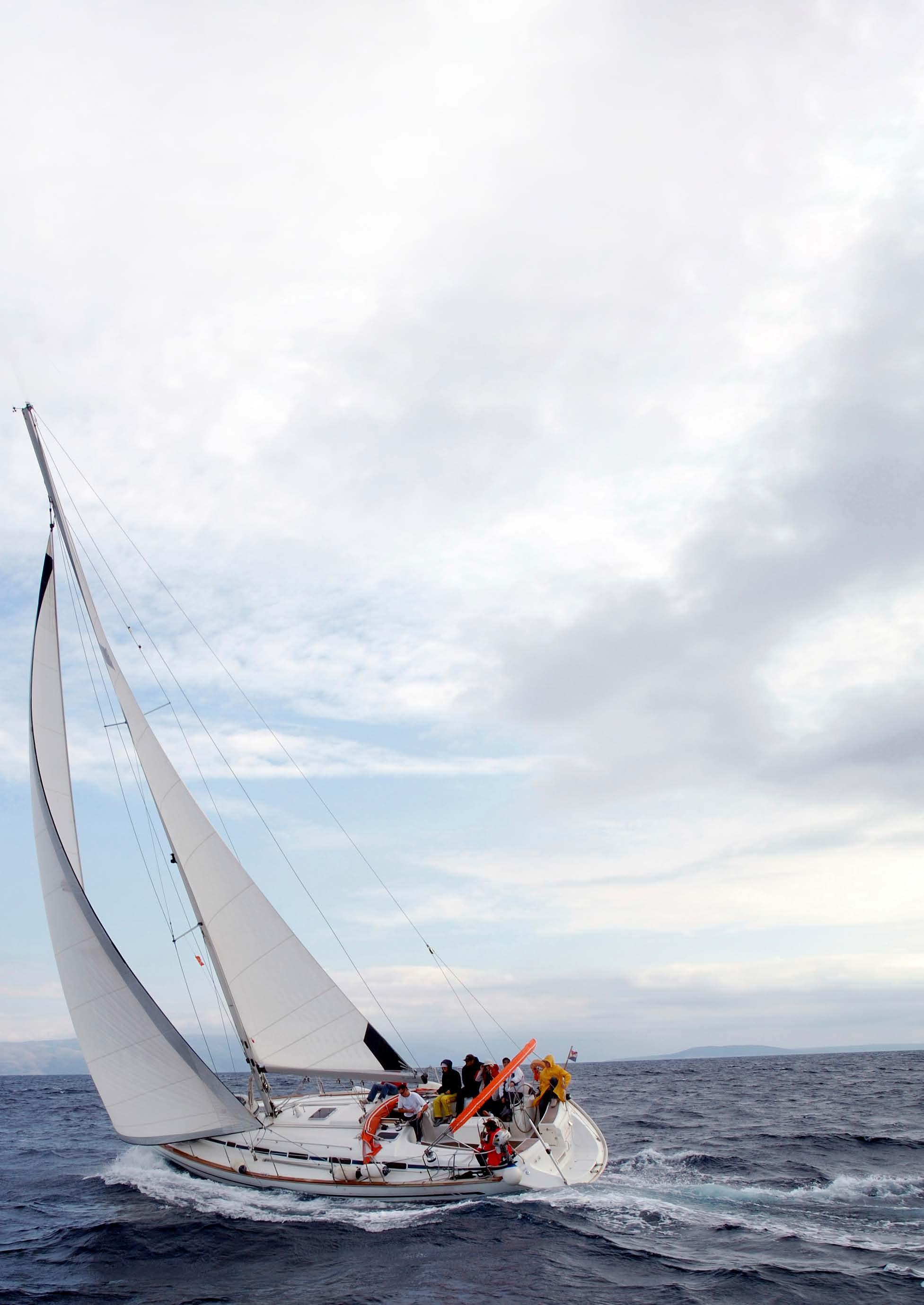
maintained engine, a watertight ship, and a reliable reefing system could prove invaluable when facing a challenging situation, such as a sudden squall near a reef pass in the dead of night. Being proactive now could mean the difference between safely managing the situation or being caught unprepared.
Your crew is your greatest asset, and their preparation is just as important as the vessel’s. For those less experienced, it’s vital to set realistic expectations about offshore sailing. The first few days at sea can be physically demanding – seasickness, difficulty performing simple tasks like cooking and dressing, and the challenge of getting on deck for a watch, especially in cold, stormy conditions, can be overwhelming.
Encourage open discussions about concerns and mix experienced crew with newcomers during watches. Assign everyone roles for both routine and emergency situations. Clear communication and shared responsibility help create a more cohesive, confident crew.
The skipper is ultimately responsible for the safety of the vessel and crew. Offshore passages come with inherent risks, and it’s the skipper’s duty to mitigate them. This includes providing essential training such as man overboard procedures, lifejacket use, fire drills, hazard awareness, and abandon ship protocols.
I recently attended the Offshore Personal Safety course, run by Phil Bishop of Skipper Training NZ,
where we analysed real-life offshore incidents. Many of these tragedies could have been avoided with better risk assessment and preparedness. Discussing such incidents with your crew can be an eye-opener, helping them understand potential dangers and how best to react.
Navigation is another key responsibility. While many crew members may be techsavvy, offshore sailing is not simply a straight line from A to B. Electronic navigation has limitations, and not all hazards are always visible. Clearly define who is responsible for navigation, and if delegating, maintain open communication throughout the trip, as ultimate responsibility remains with the skipper.
A comprehensive pre-departure briefing is essential, but training should be continuous. A daily sundowner meeting on deck is a great way to review the past day, check in with the crew, and discuss upcoming weather, sea state, course adjustments, and contingency plans.
Leadership at sea requires decisiveness and confidence, but it is equally important to explain decisions and consider crew feedback. Everyone on board should understand what’s happening and feel reassured that they are in safe hands. Regular drills and training will ensure calm, measured responses in highpressure situations.
At the heart of every decision should be the safety of your crew and vessel – even if that means altering your planned destination. With preparation, training, and teamwork, you’ll be well on your way to a safe and successful voyage.
Cris Brodie is a seasoned offshore sailor and Yachting New Zealand’s safety and technical officer.


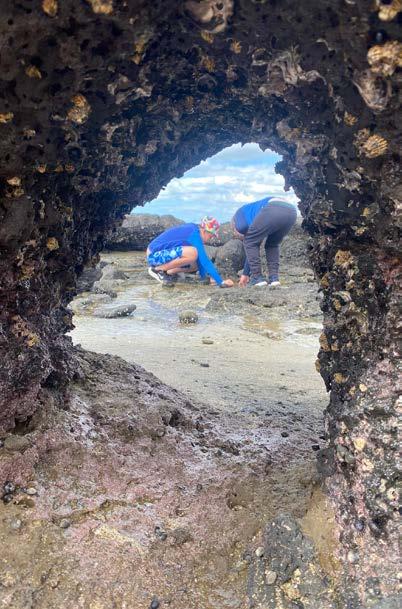

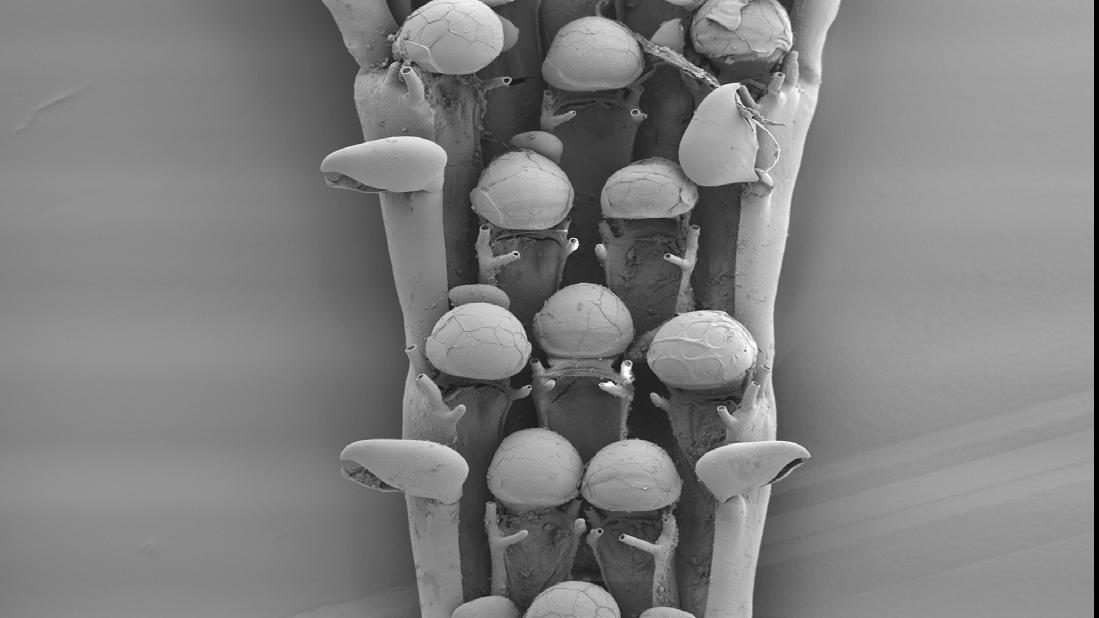
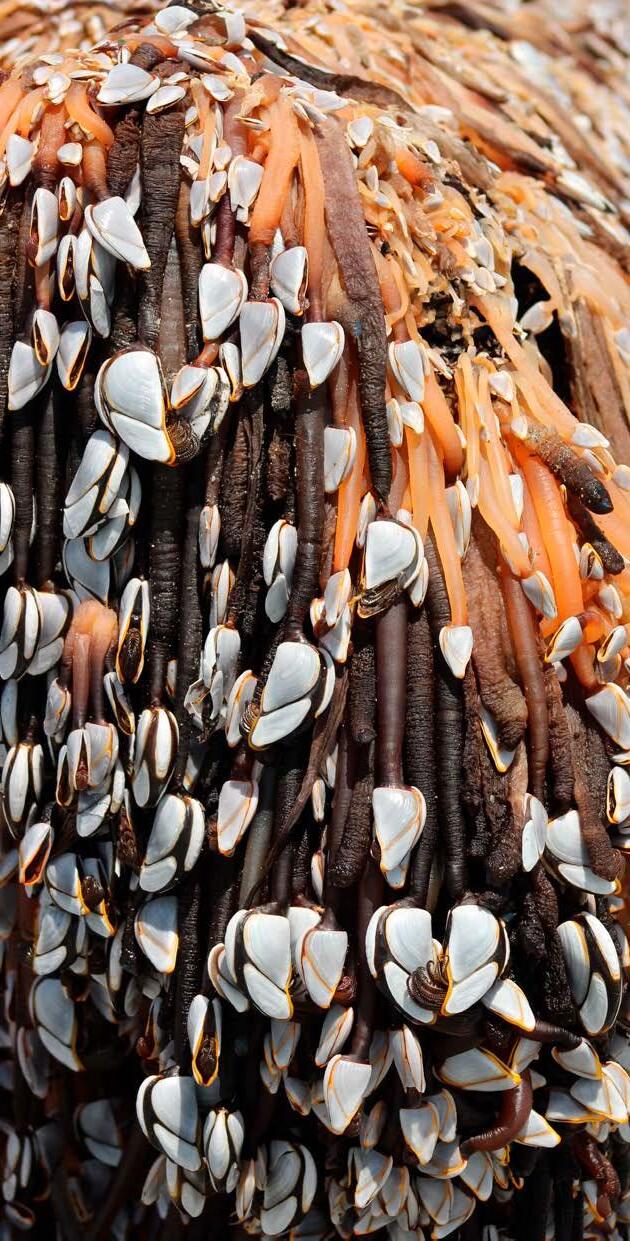
March 1 to 9 was New Zealand Seaweek and we asked YBQ readers to show us how they were connecting with our oceans through photography. With one of the longest coastlines in the world – over 14,000km ranging from sheltered sandy beaches to rocky and rugged wilderness – there certainly was enough to showcase! Here we feature 13 of our favourite shots, with Katy Smith’s photo of a juvenile elephant seal resting up at Long Beach in Otago the winner. Katy is the lucky recipient of the striking The New Zealand Seashore Guide, as well as the educational and entertaining Marine Invaders card game and a Yachting New Zealand prize pack.
5 8 6 7 9 10 11 12 13
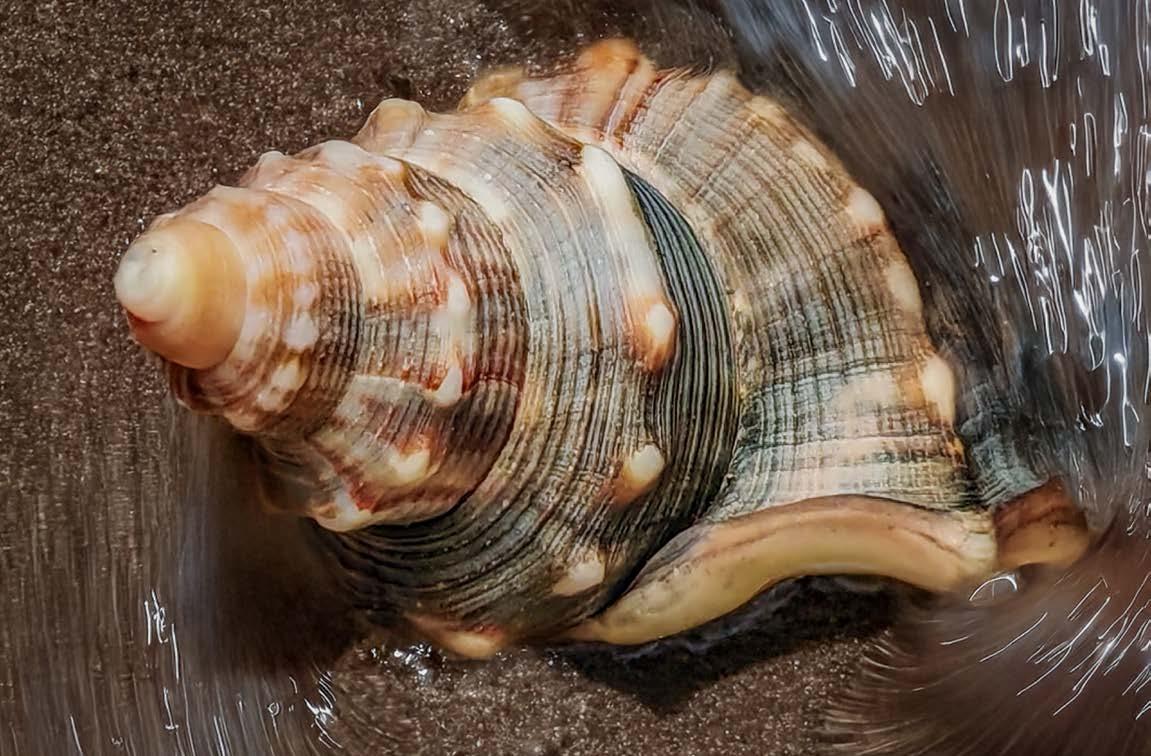

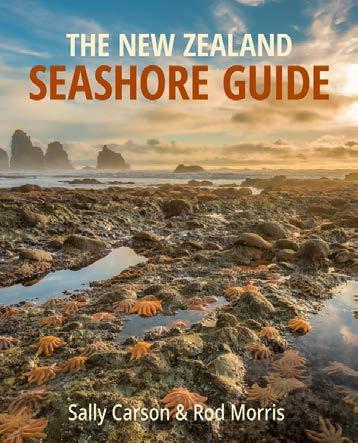
to get





2 3 4

1
Entries are now open for the 2025 Whangaroa Race and Cruising Rally, set for April 25. The event will see sailors race from the Bay of Islands Yacht Club to Whangaroa Harbour, welcoming both competitive racers and cruisers. Participants can look forward to an exhilarating day on the water, followed by a relaxed evening with a raft-up sundowner. Click here for more information and to register.
2
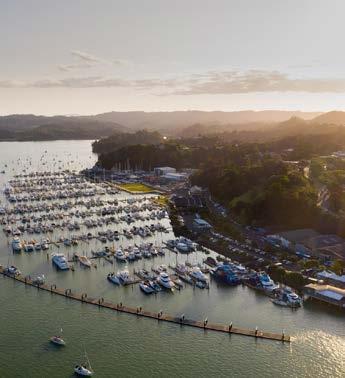
Opua Cruising Club (left) hosted the Otehei Bay Cup over the last weekend in March. Open to keelboats, multihulls, trailer sailors, foilers, dinghies and launches, the event saw 19 competitors and some “very fun, tight racing off the sandbar”. Organisers described it as a “fantastic” day which also included plenty of foiling, cricket and a shared BBQ at Paradise.
3
Manly Sailing Club held its Wenderholm Adventure Sail in February, with 40 sailors making the journey in light southerlies. A parent-run sausage sizzle greeted them at the park before a fresh southwesterly provided fast sailing back to the club. Sailing mums Kelly Peters and Michelle Torbet claimed line honours in the 29er, while sailors and supporters enjoyed a great day on the water. The club thanked Russell Coutts Sailing Foundation head coach Matthew Rist (right), along with parents and volunteers, for making the event a success.
4 The NZL Sailing team hosted a sausage sizzle at Milford Cruising Club in February to recognise the club’s outstanding support of the 2024 NZLST Sports Gear Collection Drive. The event, which aims to repurpose sports equipment for those in need, is run in collaboration with Replay NZ and the
Kindness Collective Foundation and encouraged Auckland yacht clubs to donate used and unused sporting gear. Over 200 items were collected across 15 different sporting codes.
5
Northcote Birkenhead Yacht Club (right) stole the spotlight at Auckland’s SailGP debut in January with their metre-tall F50 model. Built using recycled materials, the intricate replica earned them top marks in the SailGP Next Gen Challenge, an initiative promoting sustainability and inclusivity in youth sailing. The project saw junior sailors repurpose old sails, coat hangers, and even bike handlebars with their efforts securing them a visit to the Black Foils’ base.
6
Devonport Yacht Club is looking for new members to help organise events. Meetings are held once a month on Thursdays at 5.30pm at the club and
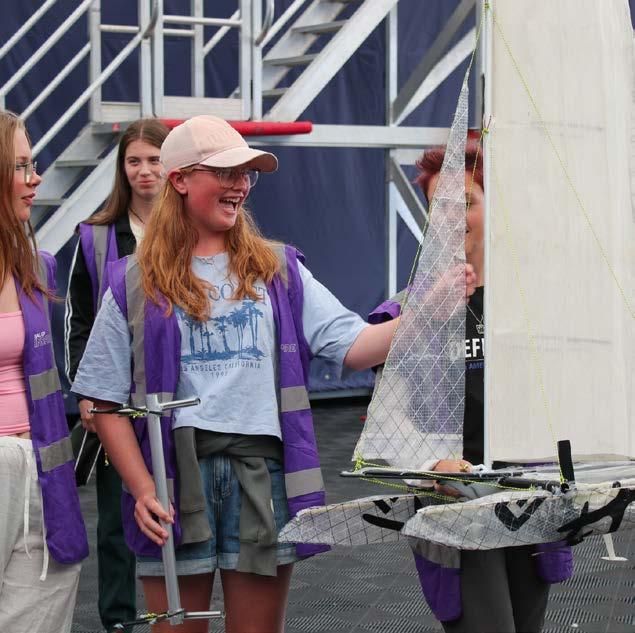

Winners included Matteo Barker and Greta Hutton (Optimist), Leo Brown and Alexis Heckler (Starling), Hugo Smith and Louis Quere (29er), Sam Clarke and Chloe Turner (ILCA 6), and Lara Davies and Megan Schussler (RS Feva).
8

volunteers of all backgrounds are welcome to join. Those interested can contact Mandy Bullard at mandy. mandyann@gmail.com.
7

Junior Sail Auckland saw 155 young sailors compete in Optimist, Starling, 29er, ILCA 6, and RS Feva fleets at Kohimarama Yacht Club in February.
Glendowie Boating Club’s annual Starling Camp took place in February, with sailors heading to Motuihe Island for a weekend of swimming, biscuiting (below), and island adventures –alongside some sailing. The camp remains a highlight of the GBC calendar, with organisers thanking the parents who made it possible. Planning is already underway for next year’s event.
9
The Waikato Yacht Squadron’s Gulf Classic regatta saw 34 boats take on challenging courses across the Hauraki Gulf from March 14-16. Competitors tackled three routes: a 40-nautical-mile race for trailer yachts, a 60-nautical-mile course for experienced sailors, and an 80-nautical-mile challenge for keelers and A Class trailer yachts. Winners include Audrey, Reggae Shark, Escargot and Winsome II

10 Port Ohope Yacht Club (left) has received four new O’pen Skiff boats, thanks to a generous donation from the Bay of Plenty Sailing Academy Trust (BoPSAT). In a social media post, the club expressed its gratitude to the trust and said it was looking forward to putting the new boats to good use.

11
The 78-year-old Lexia Cup has been returned to Gisborne Yacht Club by Englishwoman Dr Jenny Forbes. The trophy was awarded in perpetuity to her late father, Dr Robert Forbes, after he won it three consecutive times from 1947 to 1949. Forbes took the cup to Britain in 1951, where it remained until his daughter returned it, fulfilling his long-held wish.
12
The Heretaunga Boating Club’s junior harbour cruise and raft-up took place on March 29, giving Learn to Sail kids a chance to experience sailing on a keeler. Despite a lack of wind, the event was still a success with a short sail and raft-up at Somes Island.
13
The Interislander Optimist Challenge and Port Marlborough Starling championships attracted 97 sailors to Queen Charlotte Yacht Club in late February (below). Local sailor Charlie Bridger won the Starling, while Luca Blundell claimed the Optimist title. Top female finishers were Lucy Luxford and Mila Blundell in the Starling, and Alina Romanenko in the Optimist. Full results here

14 Nelson Yacht Club hosted Nelson Intermediate School’s Year 8 students for Sea Week 2025,
Send your club or class association news to eduan@yachtingnz.org.nz
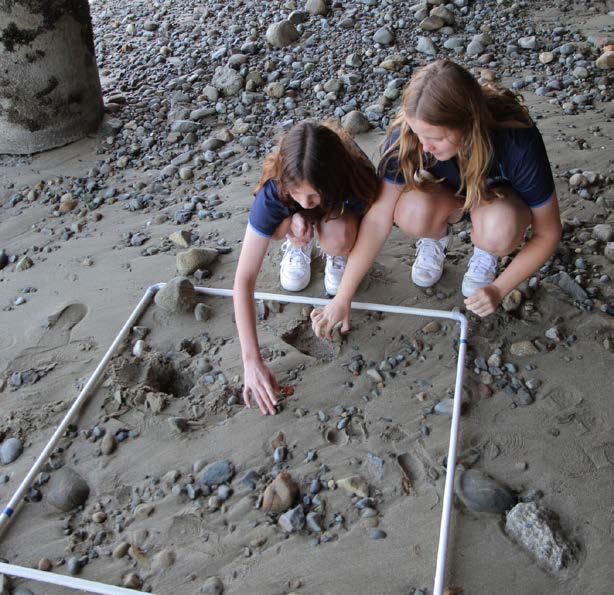
combining an introduction to sailing with Moanamana learning modules from RŪNĀ (right). Students acted as citizen scientists, monitoring the water and shore to gather data that could inform future marine conservation efforts.
15The Lake Mahinapua Aquatic Club hosted its annual regatta over the first week of February, drawing sailors from Pleasant Point Yacht Club, Waimakariri Sailing Club, Stewarts Gully Sailing Club, and Naval Point Club Lyttelton. The event once again featured the Firebug class West Coast championships, with six Firebug sailors making the trip. Cate Ambury took first in the junior division, while Ian Douglas won the senior category. Other divisions included open senior dinghies, won by John Kennedy, and open trailer yachts/multihulls, where Kim Humphreys finished first. Full results here
18

16Pleasant Point Yacht Club members took a break from traditional sailing in late February, visiting the Christchurch Model Yacht Club at Ferrymead Ponds for a day of radio-controlled yachting. Despite light, shifty winds, competition was intense as members battled for top spots.
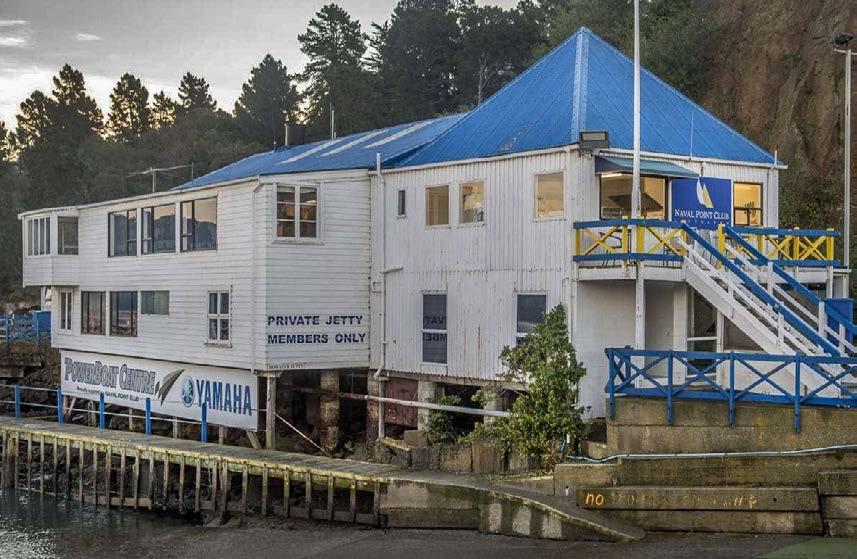
Wanaka Yacht Club has recently undergone significant upgrades, including erosion remediation, a refurbished car park, and a refreshed exterior. A local contractor and club member carried out the erosion work and car park improvements, while club coaches took on the task of repainting the clubhouse. The club’s changing rooms have also been expanded.
19 Six-year-old Harrison Vick and his father Tim (left) claimed victory at the South Island Sunburst championships, hosted by Vauxhall Yacht Club in early February. It was their first time racing together, making Harrison one of the youngest sailors to win the event. Competing against 12 crews, they tackled seven races over two days in challenging, shifting conditions to secure the title.
20
17Naval Point Club Lyttelton (left) has welcomed its latest addition – the Lyttel Library. The library is described as a “treasure trove dedicated to the wonders of the sea, the art of navigation and the rich history of maritime adventures”. It features 2000 books spanning centuries of maritime knowledge and storytelling, catalogued by club volunteers. The impressive collection includes everything from shipbuilding techniques to modern oceanography, the club said.
The Owaka Yacht Club (right) hosted a fantastic weekend of camping, sailing, and hospitality at the Campbell Regatta in March. The event saw a great turnout, with Bluff Yacht Club contributing nine boats and a chase boat.
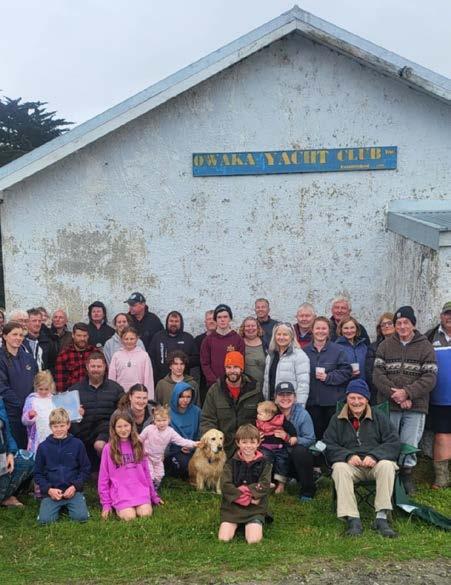
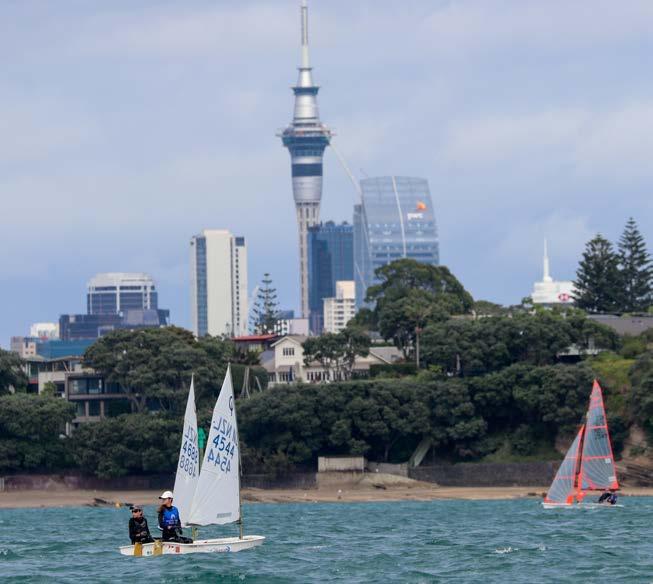
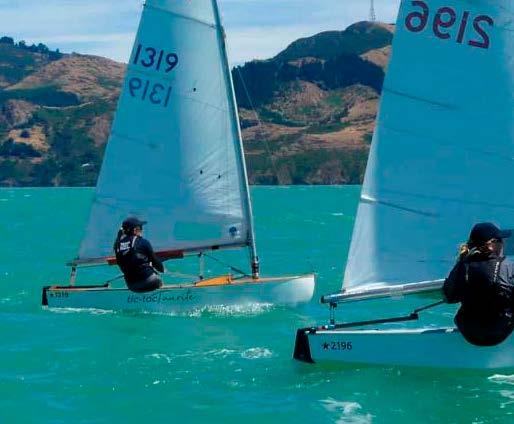

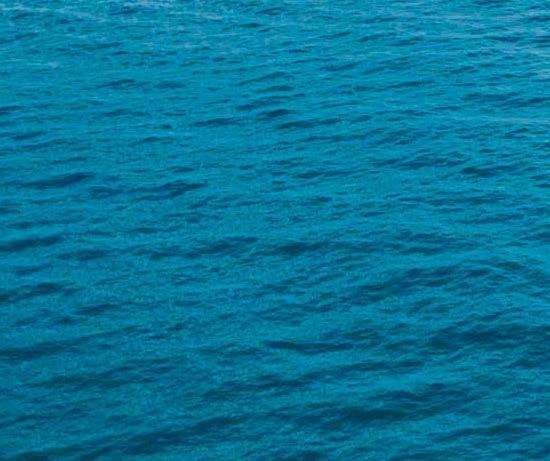
Auckland secondary schools team sailing regional championships
Royal Akarana Yacht Club
March 26-28
Princess Sofia Regatta Palma, Spain
March 28-April 5
Elliot 5.9 national championships Napier Sailing Club
April 3-5
Optimist national championships
Royal Akarana Yacht Club
April 12-16
French Olympic Week Hyeres, France
April 19-26
Starling national championships Howick Sailing Club
April 17-21
Secondary schools team racing national championships
New Plymouth Yacht Club
April 21-26
Hansa Liberty national championships
Royal Akarana Yacht Club
April 24-27
WMRT Ficker Cup
Long Beach, USA
April 25-27
WMRT Congressional Cup Long Beach, USA
April 30-May 4
Keelboat national championships
Royal Akarana Yacht Club
May 1-5
Brazil SailGP
Rio de Janeiro, Brazil
May 4-5
RS Feva national championships Murrays Bay Sailing Club
May 10-11
ILCA 7 men’s and ILCA 6 women’s world championships Qingdao, China
May 10-17
WMRT GKSS Spring Cup Marstrand, Sweden
May 17-18
North Shore freshwater championships Pupuke Boating Club
May 17-18
WMRT NJK Open Spring Cup Helsinki, Finland
May 23-25
WWMRT Casa Vela Cup
San Francisco, USA
May 28-31 May


Optimist European championships
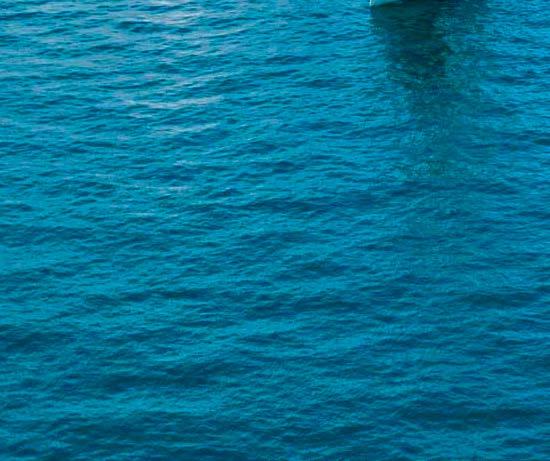
Çeşme, Turkey
May 28-June 4
29er national championships Manly Sailing Club
May 29-June 2
WWMRT Santa Maria Cup Annapolis, USA
June 4-7
WWMRT Normandy Match Cup Le Havre, France
June 6-9
470 world championships Gdynia, Poland
June 6-14
USA SailGP
New York, USA
June 8-9

Farr 1020 national championships
Bucklands Beach Yacht Club
June 14-16
Trailer yacht national championships
Evans Bay Yacht and Motorboat Club
June 19-22
ILCA 6 men’s world championships Kiel, Germany
June 20-25
Optimist world championships
Portoroz, Slovenia
June 26-July 6
WMRT GKSS Match Cup
Marstrand, Sweden
June 30-July 5
WWMRT Nordea Women’s Trophy Marstrand, Sweden
June 30-July 5
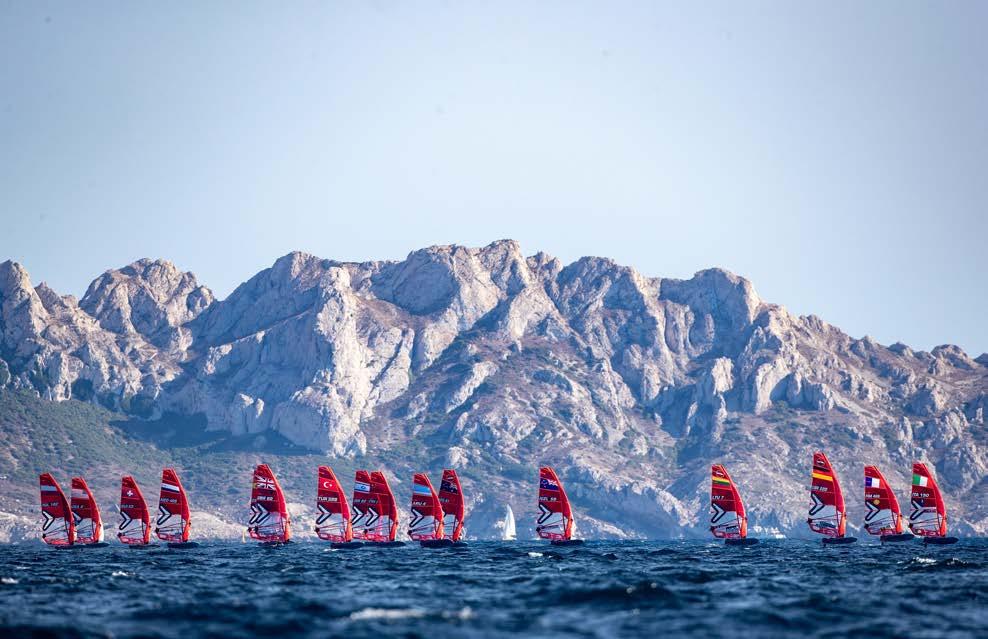
420 world championships Urla, Turkey
July 1-9
Windfoil world championships Aarhus, Denmark
July 4-11
WMRT Internationaux de France de Match Racing Pornichet, France
July 18-20
ILCA 4 youth world championships San Pedro, USA
July 19-26
Great Britain SailGP Portsmouth, England
July 20-21
ILCA 6 youth world championships San Pedro, USA
July 28-August 4

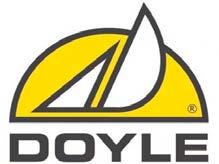
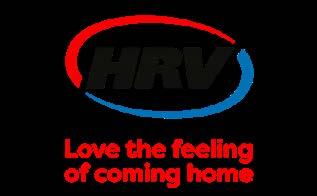
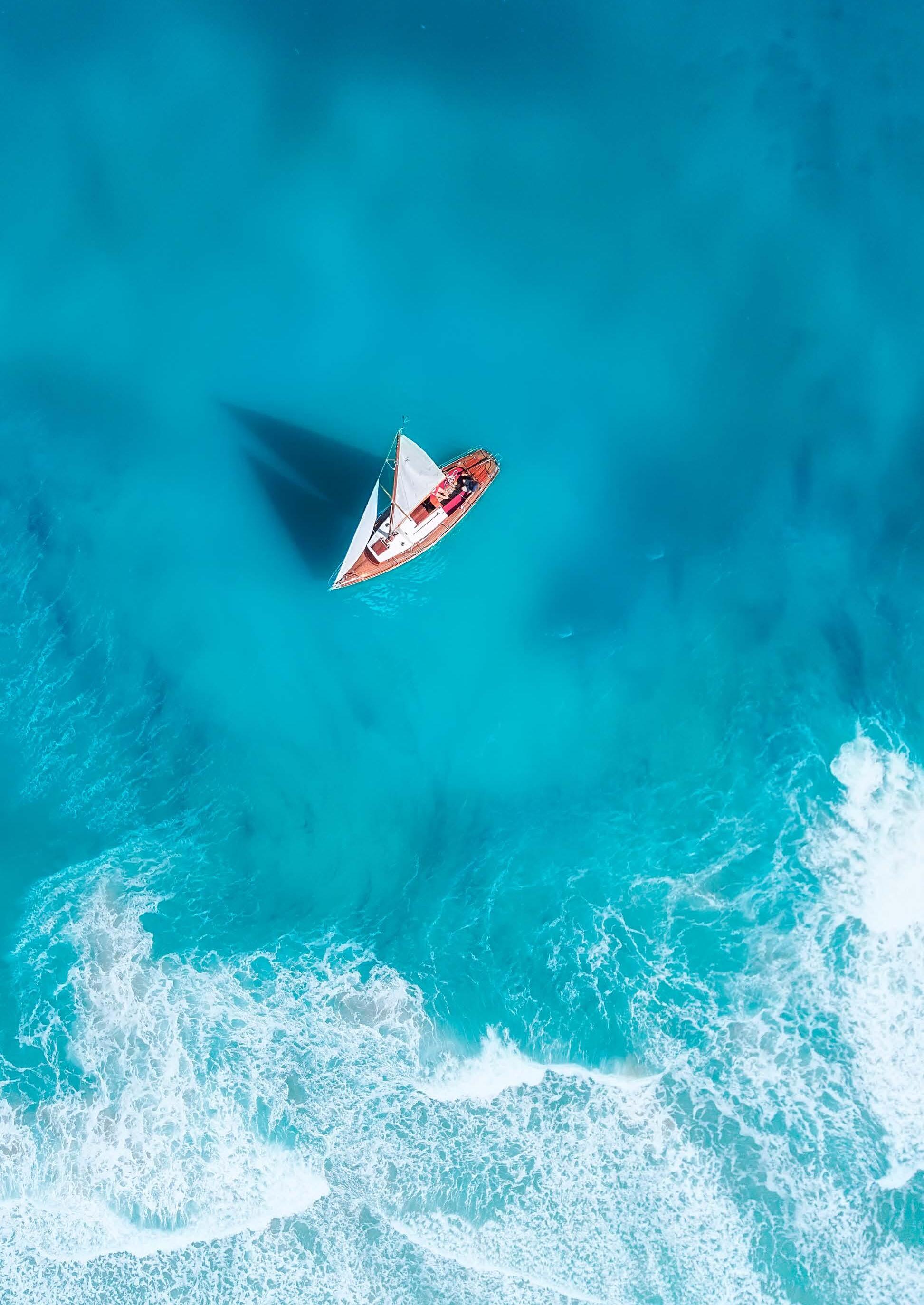
Click on the logo for the latest exclusive member benefits from Yachting New Zealand’s partners.

